
Abandoned & Little-Known Airfields:
Arizona: Northwest Phoenix area
© 2002, © 2023 by Paul Freeman. Revised 12/16/23.
This site covers airfields in all 50 states: Click here for the site's main menu.
____________________________________________________
Please consider a financial contribution to support the continued growth & operation of this site.
(Original) Airhaven Airport (revised 12/27/22) - Fram Field (revised 12/27/22) - Isbell Construction Co. / Air Haven / (Original) Glendale Municipal (revised 11/10/23)
Luke Satellite Field #3 / Luke Aux AAF #A1 / Luke Aux AAF #1 / Wittman Field (revised 11/10/23) - Luke Aux AAF #2 / Beardsley Field (revised 12/16/23)
Luke Satellite Field #1 / Luke Aux Field #3 (revised 10/6/21) - Luke Aux AAF #4 (revised 12/27/22) - McGill Ultralight Field (revised 12/16/23) - Pleasant Valley Airport (revised 12/16/23)
Pylant Airport / Thunderbird #1 Aux AAF A-3 / Paradise Airport (revised 11/2/20) - Sun City Airfield (revised 11/2/20) - Thunderbird Field (revised 12/27/22)
Thunderbird #1 Auxiliary Airfield A-1 (revised 12/27/22) - Thunderbird #1 Auxiliary Airfield A-2 (revised 11/2/20)
Turf Paradise Airfield (revised 10/7/21) - Williams Field / Rex Williams Field / Moseley Field (revised 6/13/23)
____________________________________________________
Pleasant Valley Airport (P48), Peoria, AZ
33.801, -112.249 (Northwest of Downtown Phoenix, AZ)

Pleasant Valley Airport, as depicted on the 1978 Phoenix Sectional Chart (courtesy of Jonathan Westerling).
Pleasant Valley Airport was not yet depicted on a 1971 aerial photo nor on the June 1977 Phoenix Sectional Chart.
According to its FAA Airport/Facility Directory data, Pleasant Valley Airport was activated in November 1977.
According to the Pleasant Valley Airport website, “Roy Coulliette dreamed of being a pilot after he saw a glider club operating off a dirt highway.
In 1976, Roy moved his Turf Soaring School & began building the Pleasant Valley Airport.”
The earliest depiction which has been located of Pleasant Valley Airport was on the 1978 Phoenix Sectional Chart (courtesy of Jonathan Westerling).
It depicted Pleasant Valley Airport as a private airfield having a 4,000' unpaved runway, and to conduct glider operations.
The June 1981 Phoenix Sectional Chart depicted Pleasant Valley Airport as a private airfield having a 4,000' unpaved runway, and to conduct glider operations.
The earliest photo which has been located of Pleasant Valley Airport was a 1981 aerial view.
It depicted Pleasant Valley Airport as having 3 unpaved runways: 2 parallel northeast/southwest & 1 northwest/southeast.
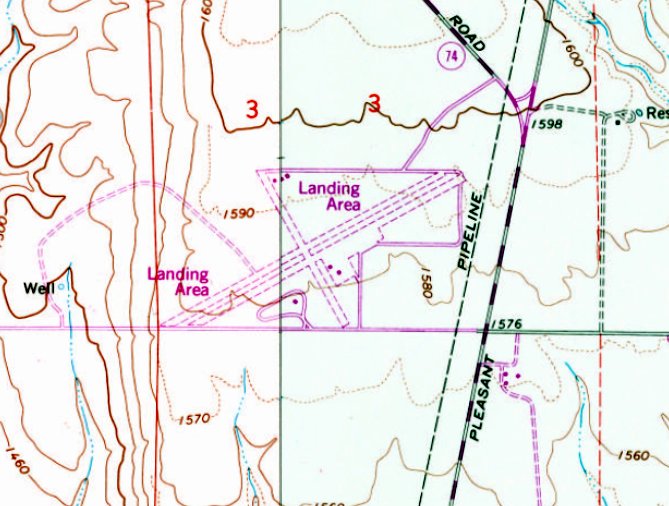
The earliest topo map depiction which has been located of Pleasant Valley Airport was on the 1981 USGS topo map.
It depicted a generically labeled “Landing Area” as having 3 unpaved runways: 2 parallel northeast/southwest & 1 northwest/southeast,
with a ramp & 2 small buildings on the southeast side.
Duncan Woods recalled, “Pleasant Valley Airport was the home of Turf Soaring School.
It was mostly used for sailplanes, although there were some ultralights there also.
Back in the 1980s, I went there for several ultralight events.
I remember it was still called Turf Soaring School after the move, but I’d never heard the name Pleasant Valley Airport.
They probably changed to that name later on sometime after all the ultralight events.
There always seemed to be a lot of flying going on there; sometimes we’d stop & watch the gliders being towed up or coming back in to land.
Didn’t see many ultralights, though; after the initial flurry of interest died down, fewer ultralights used the field,
although I understand that EAA ultralights Chapter 55 held its monthly meetings at the field.”
A 1985 aerial view still depicted Pleasant Valley Airport as having 3 unpaved runways.
A 1988 aerial view showed Pleasant Valley Airport had gained a 3rd parallel runway, bringing its total to 4 runways.
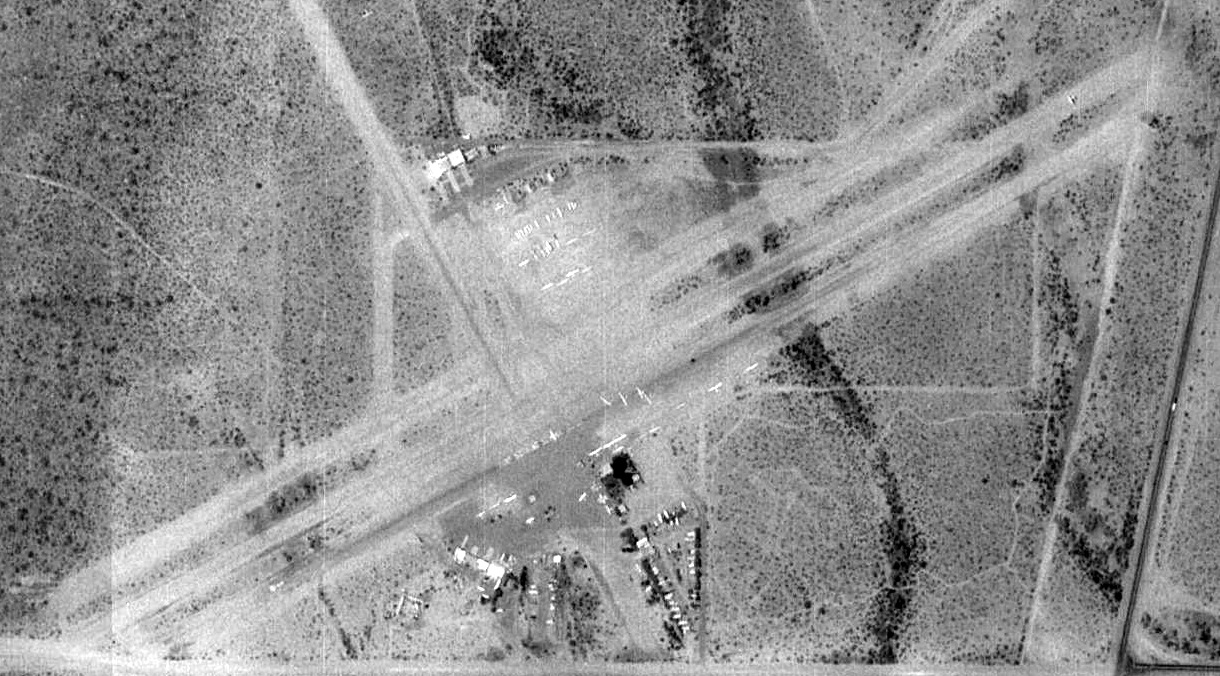
The earliest photo which is available of Pleasant Valley Airport was a 1997 USGS aerial view.
It depicted Pleasant Valley as having 4 unpaved runways, with a large number of gliders & other small aircraft on the north & south sides.
According to the Pleasant Valley Airport website, “By the year 2000, the Turf Soaring School was recognized as one of the major soaring schools in the country
with 11 gliders, 4 tow planes, and operated over 12,00 flights per year.
Pleasant Valley Airport is also home to Civil Air Patrol Cadet Training Squadron Flight 400, the most active in the US.”

The May 1999 Phoenix Terminal Chart depicted Pleasant Valley Airport as a private airfield having a 4,000' unpaved runway, and to conduct glider operations.
According to its FAA Airport/Facility Directory data, Pleasant Valley Airport had an average of 205 takeoffs or landings per day for the year ending 4/24/08.
It had 14 single-engine aircraft based on the field & 5 ultralights.
The owner was listed as Pleasant Valley Airport Association, and the manager as Rick Brown.
It was described as having 3 parallel dirt/gravel Runways 5/23 L/C/R, and a 2,400' gravel Runway 14/32.
Gary Vacin recalled in 2022, “I landed at the Pleasant Valley Airport 10 years ago”, [circa 2012].
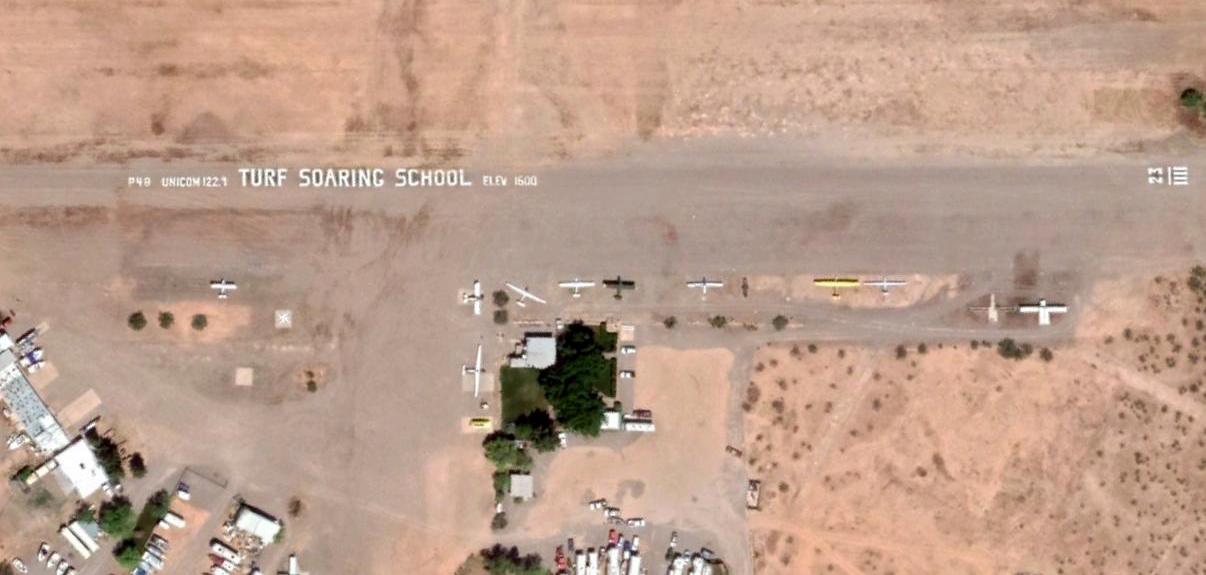
A 2017 aerial view depicted Pleasant Valley Airport as having a healthy number gliders & other small aircraft on its ramp.
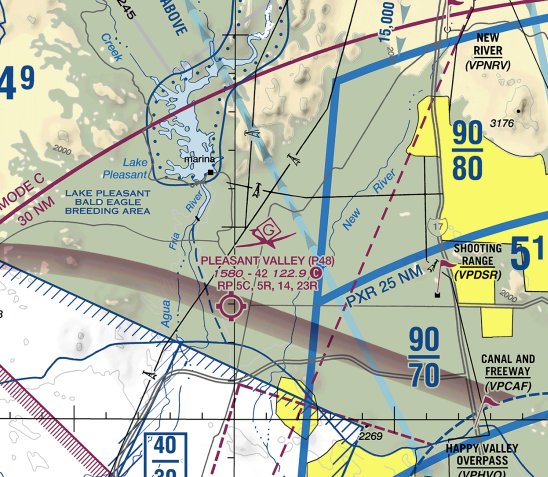
The 2021 Phoenix Terminal Chart depicted Pleasant Valley Airport as a public-use airport having a 4,200' unpaved runway, and to conduct glider operations.
Jon Radowski recalled, “I learned to fly gliders & airplanes & soloed both types here at Pleasant Valley Airport.
I have occasionally landed my hot air balloons on the property over the years.”

A 2021 photo looking north at Pleasant Valley Airport hangars, windsock, and airport office.
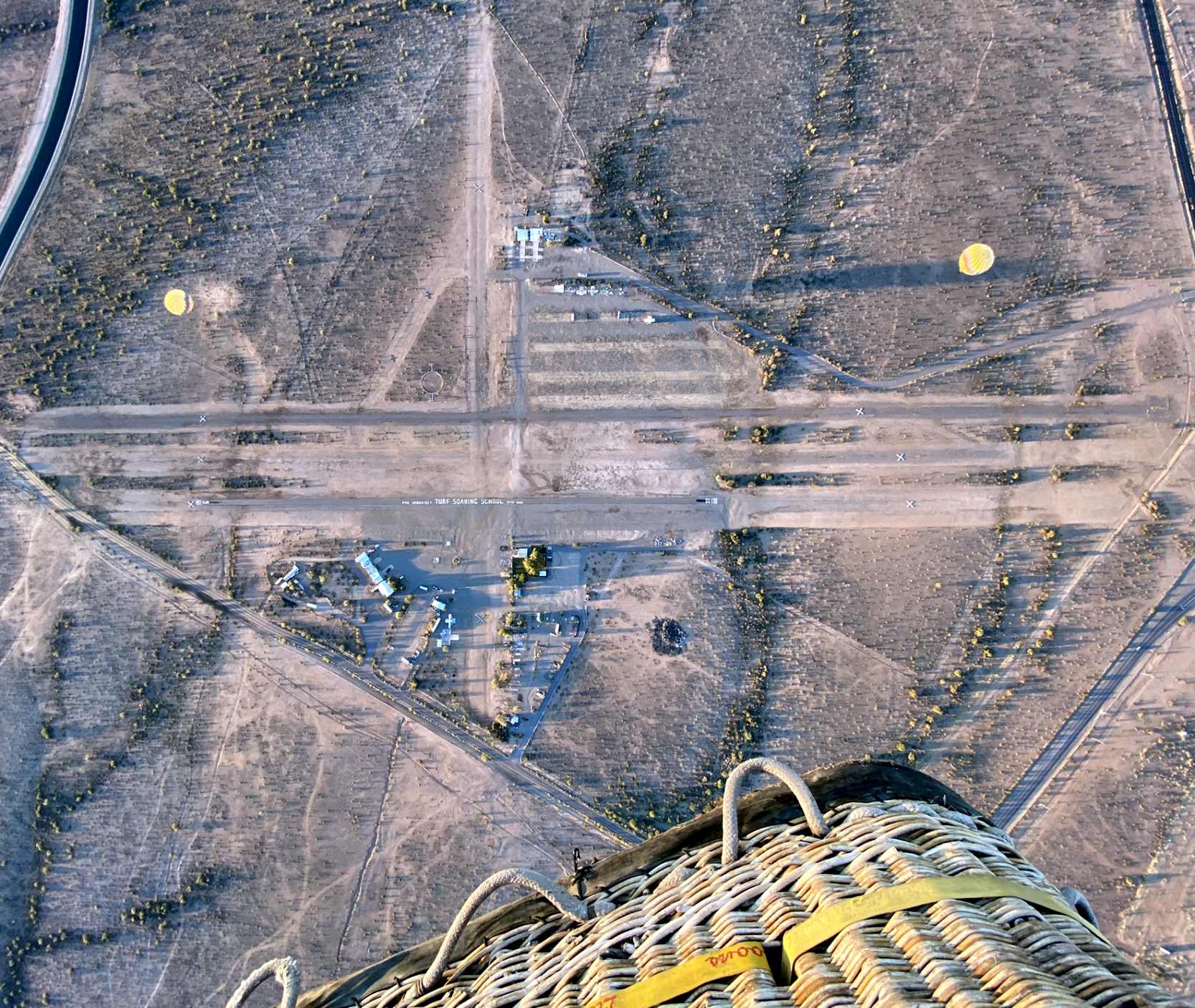
A 12/20/21 aerial view by Jon Radowski of Apex Balloons looking down from his balloon at Pleasant Valley Airport.
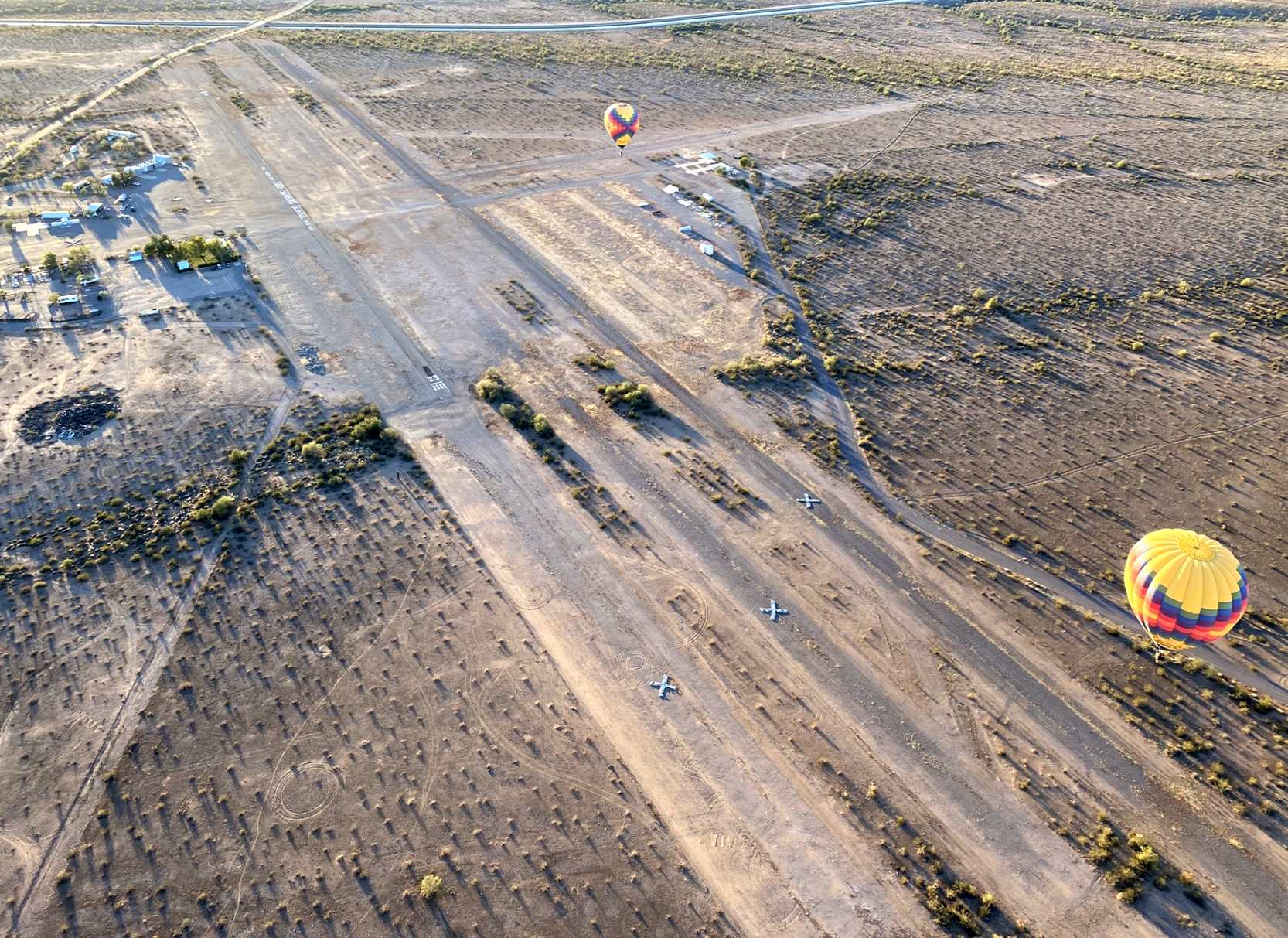
A 12/20/21 aerial view by Jon Radowski of Apex Balloons looking northwest at Pleasant Valley Airport.
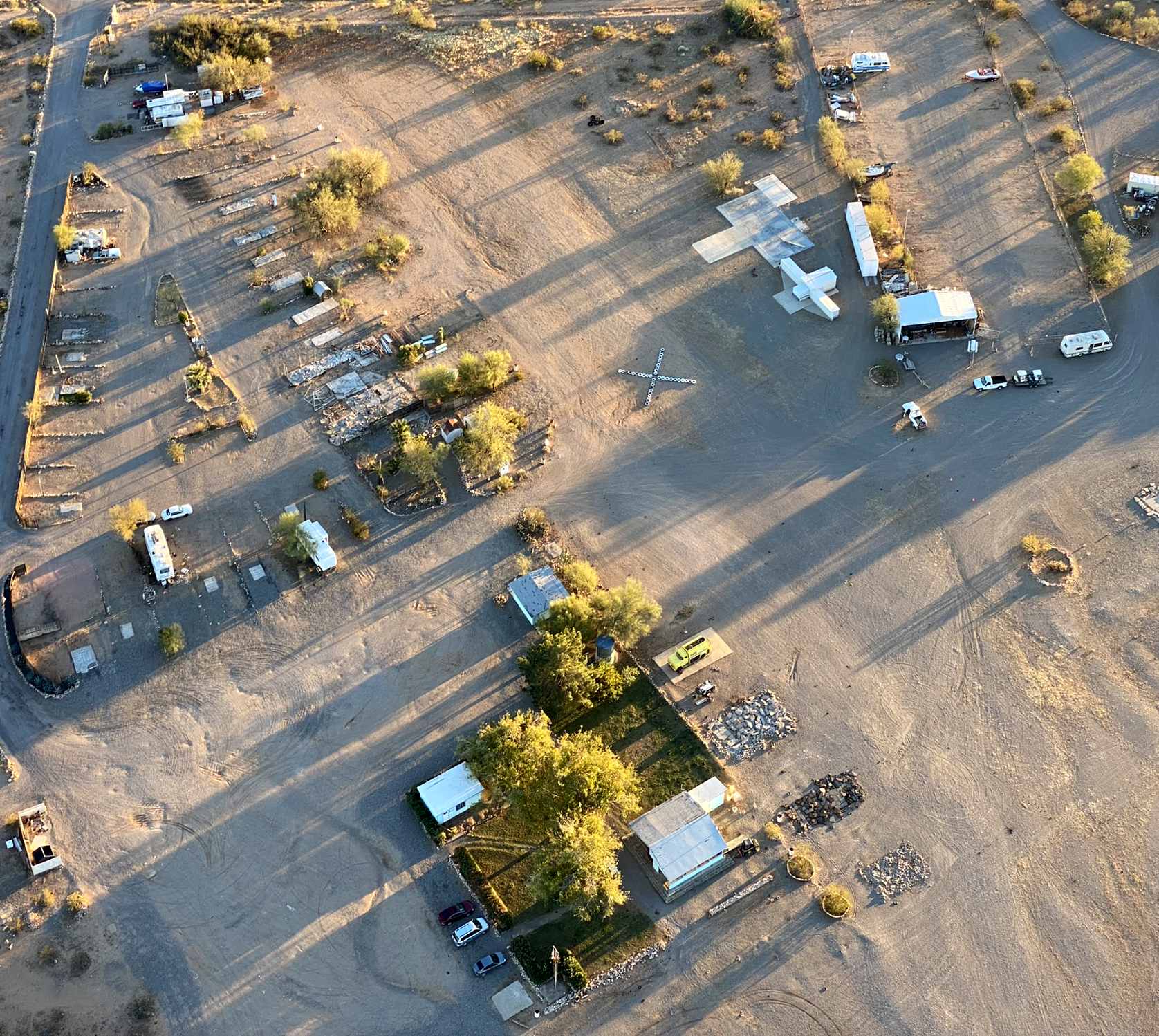
A 12/20/21 aerial view by Jon Radowski of Apex Balloons looking south at the hangars & buildings of Pleasant Valley Airport.
Unfortunately, Jon Radowski reported in 2022, “Pleasant Valley Airport has closed operations as of this fall/winter (possibly end of October).
It has been removed from sectional charts & GPS databases & there are large X's made from tires closing all 4 runways.
The land the airport was built on was leased from the AZ State Land Department for many years.
However, the lease was recently not renewed & the current tenants must vacate the property by February 2022.
Most of the hangars on the north side of the field have been disassembled &/or removed already, as well as the RV park on the south side of the property.
I'm quite sad to see it closed.”

A 2021 aerial view depicted Pleasant Valley Airport devoid of aircraft, presumably after its closure.
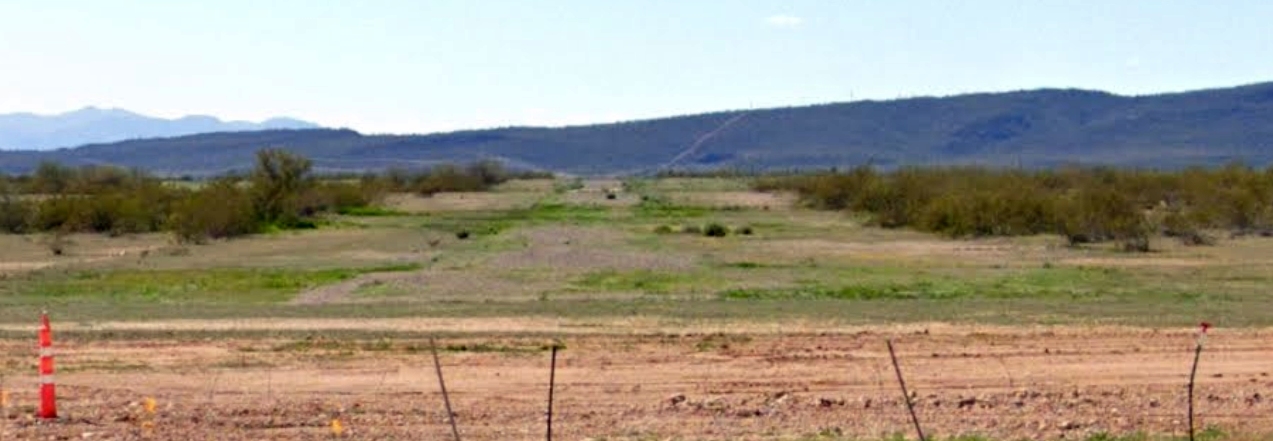
A 2023 photo looking southwest along Pleasant Valley Airport's former Runway 23.
Thanks to Jon Radowski for pointing out this airfield.
____________________________________________________
Williams Field / Rex Williams Field / Moseley Field, Glendale, AZ
33.502, -112.252 (Northwest of Downtown Phoenix, AZ)

Williams Field, as depicted on the September 1948 Phoenix Sectional Chart.
This little general aviation airport on the west side of Phoenix was evidently established at some point in 1948,
as it was not yet depicted on the March 1948 Phoenix Sectional Chart.
The earliest depiction which has been located of Williams Field was on the September 1948 Phoenix Sectional Chart.
It depicted Williams Field as having a 2,600' unpaved runway.
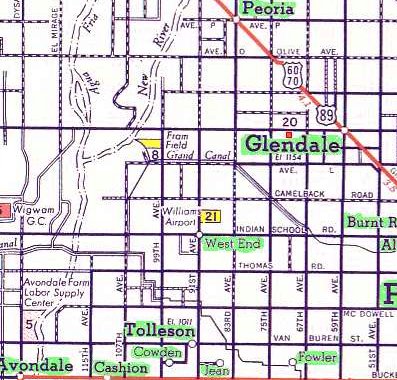
Williams Airport was depicted as a rectangular property outline on a 1952 street map.
Williams Field was still depicted on the March 1952 Phoenix Sectional Chart.
Williams Field was evidently closed (for reasons unknown) at some point in 1952,
as it was no longer depicted on the September 1952 Phoenix Sectional Chart.
The earliest photo which has been located of Williams Field was a 1953 aerial view.
It depicted Williams Field to have a single east/west runway, with a hangar at the southwest end, and 1 light single engine aircraft.
Williams Field was not depicted on Phoenix Sectionals from 1955/57.
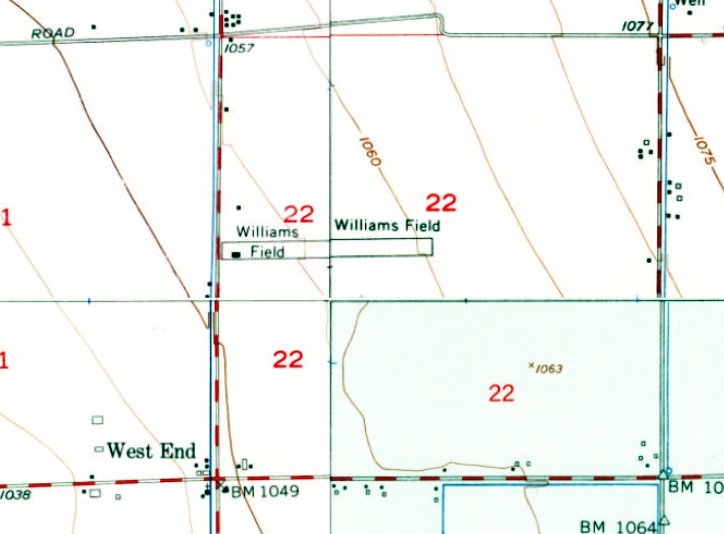
The 1957 USGS topo map depicted Williams Field as having a single paved east/west runway, with 2 small buildings on the west end.

A 1960 photo of Chance-Vought F4U-4 Corsair BuNo 97359 while in storage with Bob Bean at Williams Field / Moseley Field.
This mighty fighter eventually spent 19 years deteriorating outside after being purchased by Bob Bean in November 1957.
Williams Field was not depicted on 1960/61 Phoenix Sectional Charts.

Williams Field was evidently reopened as the Rex Williams private airfield at some point between 1961-65,
as that is how it was labeled on the January 1965 Phoenix Sectional Chart.
It depicted Rex Williams Field as having a 2,500' unpaved runway.
Rex Williams Field was evidently closed (for reasons unknown) at some point in 1965,
as it was no longer depicted on the July 1965 – January 1966 Phoenix Sectional Charts.

Rex Williams Field was evidently reopened as Moseley Field at some point in 1966,
as that is how it was labeled on the July 1966 Phoenix Sectional Chart.
It depicted Moseley Field as a public-use airport having a 2,600' unpaved runway.
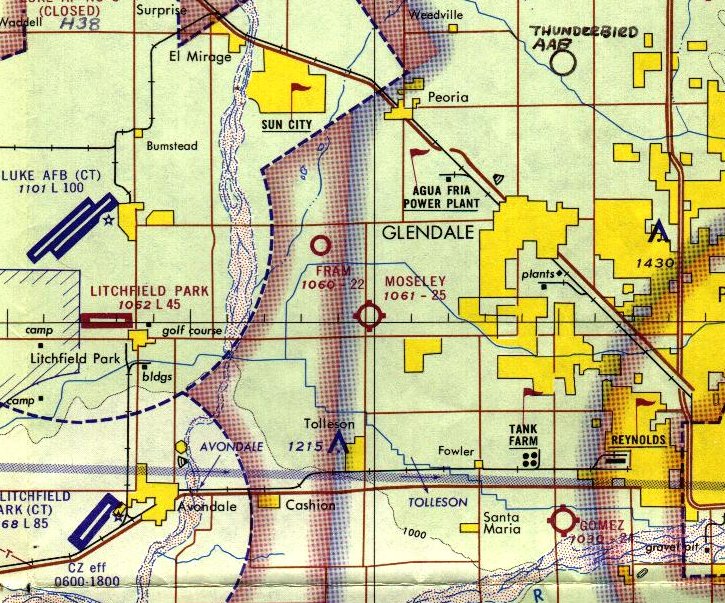
The 1966 Phoenix Local Aeronautical Chart depicted Moseley Field as having a 2,500' unpaved runway.
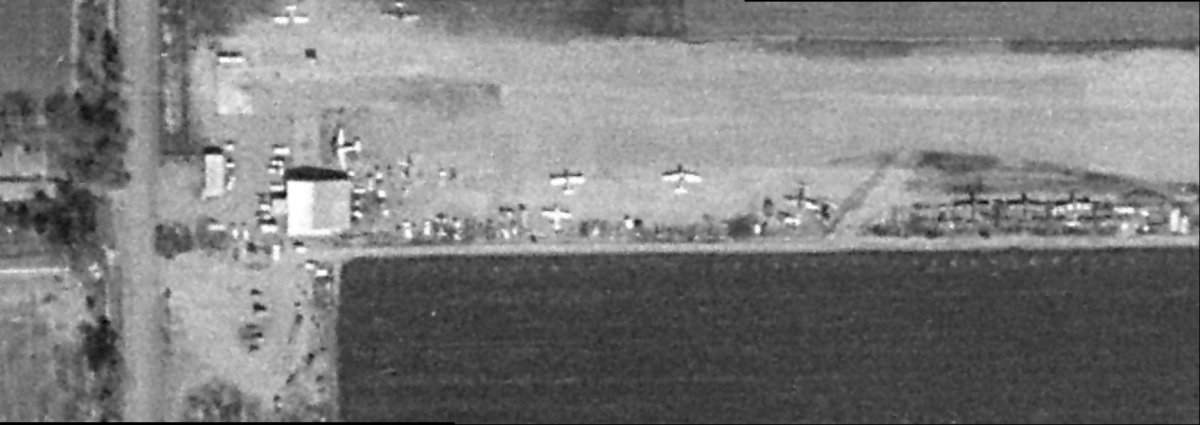
An undated aerial view of Moseley Field (courtesy of Matt Gunsch) showed the field to have a single east/west runway, with a hangar at the southwest end, and a dozen aircraft.
Matt Gunsch recalled, “I live about a mile from where Mosely Field was; it was located on the northeast corner of 91st Avenue & Campbell Road.
Some of the planes on the field are the Mosely Field Corsairs; Bob Bean stored them there after flying them out of Litchfield NAS.”
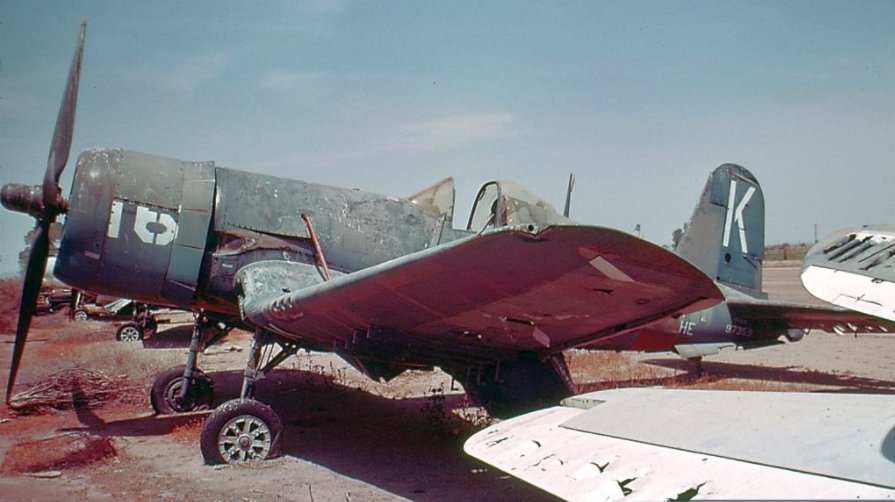
A May 1970 photo by Hank Rappone of Chance-Vought F4U-4 Corsair BuNo 97359 while in storage with Bob Bean at Moseley Field.
A 1970 aerial view depicted Williams Field at perhaps its zenith of usage, with over 20 aircraft visible on the field.
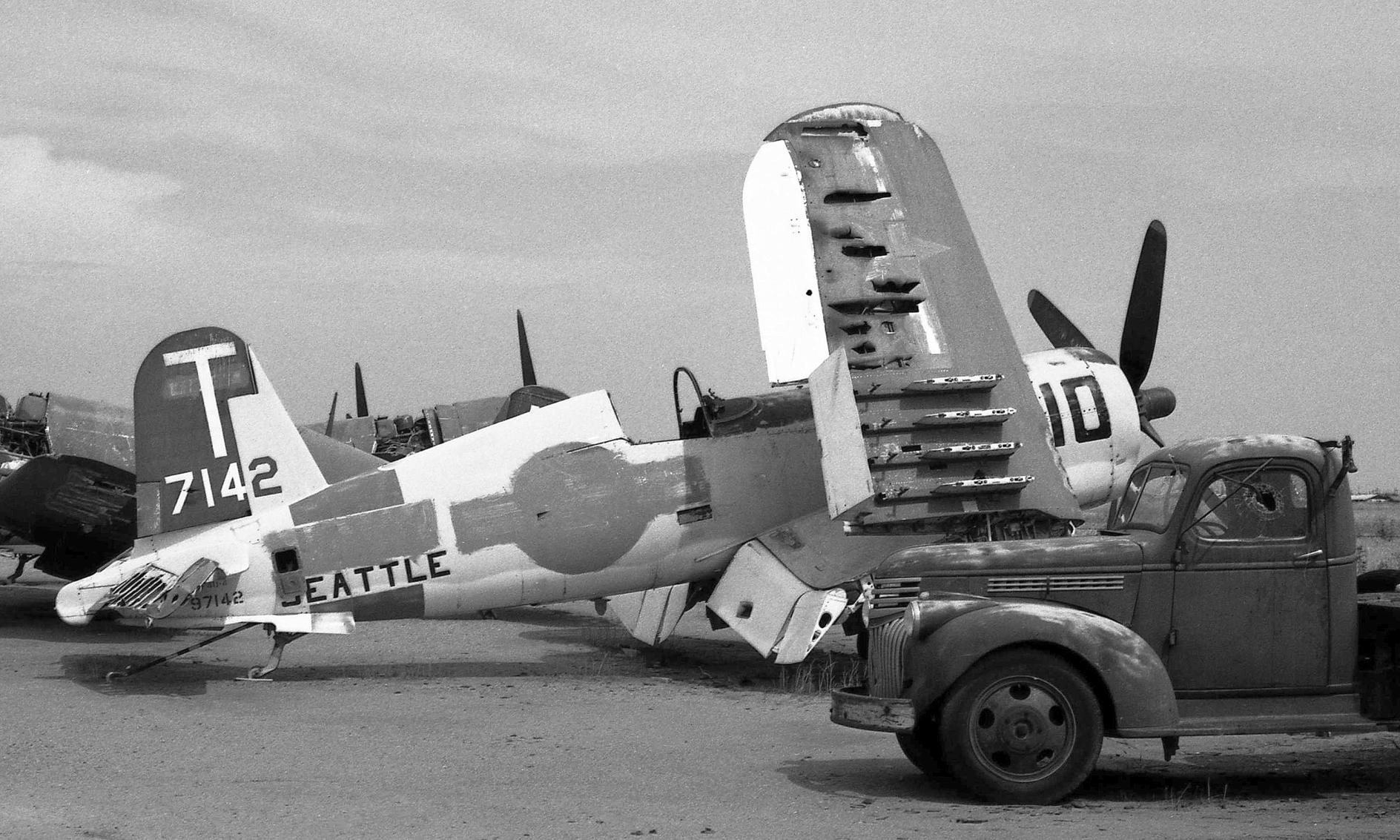
An August 1971 photo by Jay Sherlock of Navy Chance-Vought F4U-4 Corsair BuNo 97142 (originally from NAS Seattle) at Moseley Field.
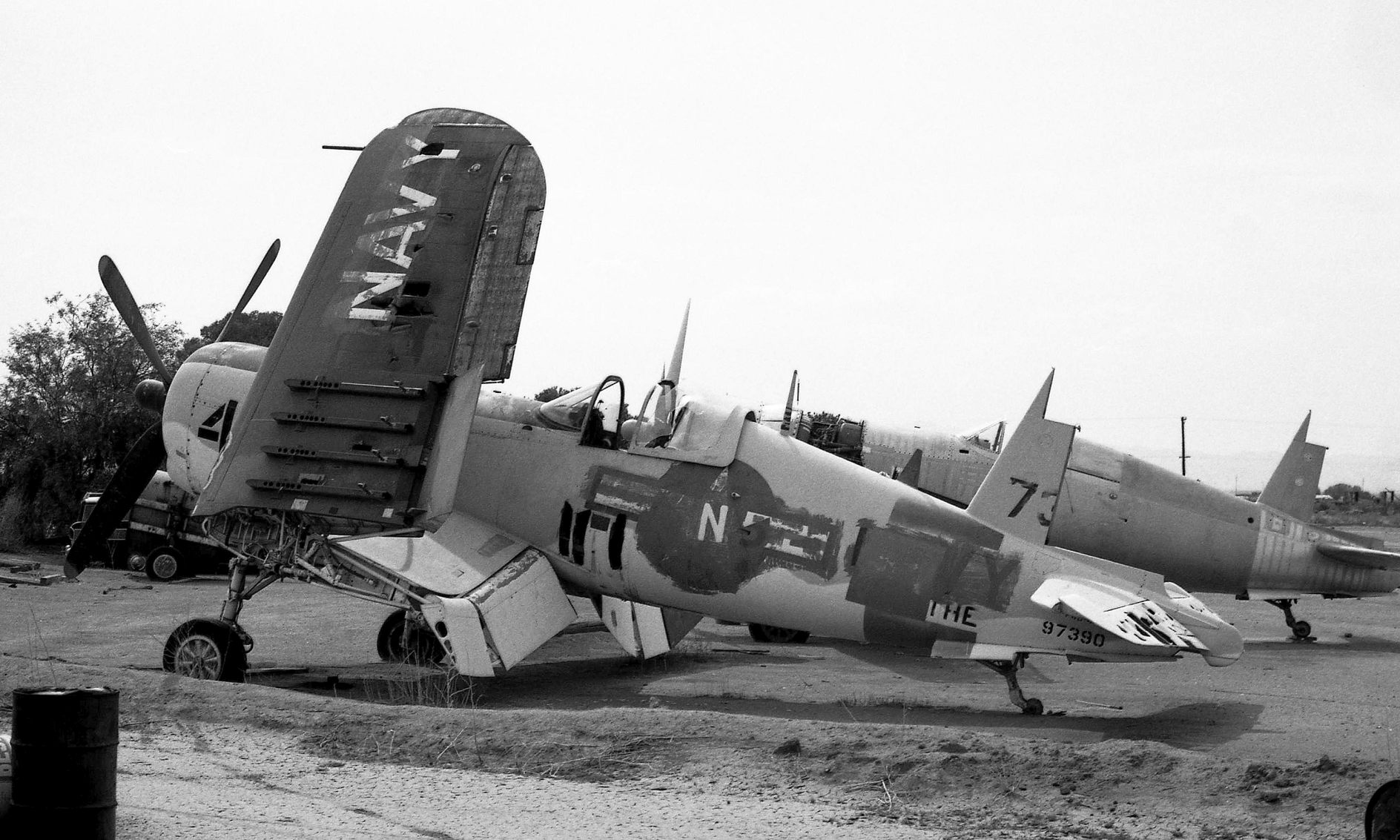
An August 1971 photo by Jay Sherlock of Navy Chance-Vought F4U-4 Corsair BuNo 97390 (originally from NAS Olathe) at Moseley Field.
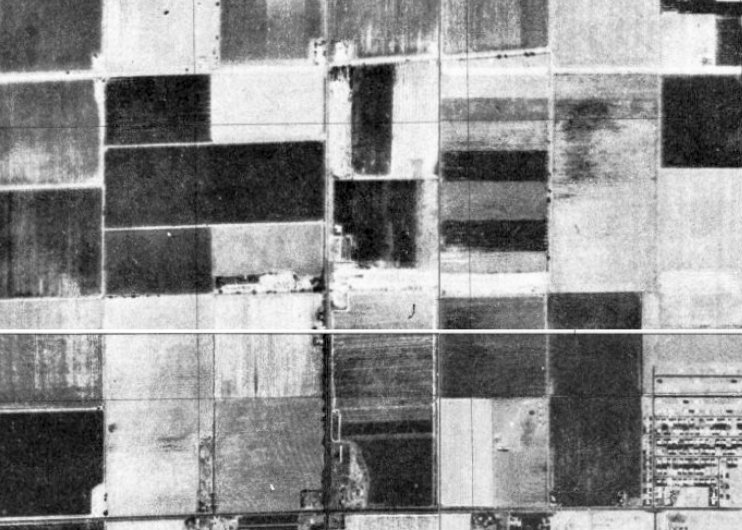
A 1971 USGS aerial photo depicted Williams Field as having a single paved east/west runway, with some small buildings on the west end.
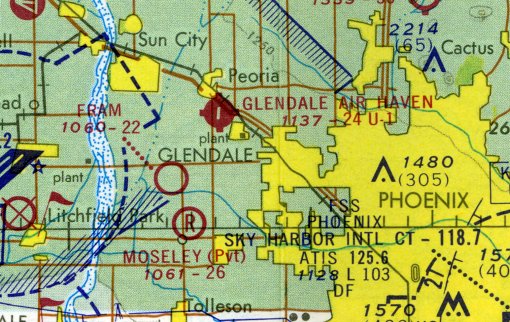
The last aeronautical chart depiction which has been located of Moseley Field was on the June 1972 Phoenix Sectional Chart.
It depicted Moseley Field as a private airfield having a 2,600' unpaved runway.
The last photo which has been located showing aircraft at Moseley Field was a 1973 aerial view, which depicted 4 aircraft on the field.
Moseley Field was evidently closed (for reasons unknown) at some point between 1972-74,
as it was no longer depicted on the 1974 USGS topo map.
A 1974 aerial view showed the Moseley Field runway & hangar remained intact, but the field was devoid of aircraft.
A 1975 aerial view showed the Moseley Field hangar had been removed.
Tom Friedkin purchased the F4U-4 Corsair BuNo 97359 at Moseley Field on 11/19/75; it would eventually be restored & would be featured in the Black Sheep Squadron TV series.
Moseley Field was no longer depicted on the 1977 Phoenix Sectional Chart.
A 1977 aerial view showed Juan Bautista de Anza High School had been constructed over the west side of the Moseley Field property,
erasing the last trace of the little airport.

A 2019 aerial view looking northeast showed no trace remaining of Moseley Field.
Thanks to Matt Gunsch for pointing out this airfield.
____________________________________________________
McGill Ultralight Field, Phoenix, AZ
33.684, -112.165 (Northwest of Dowtown Phoenix, AZ)
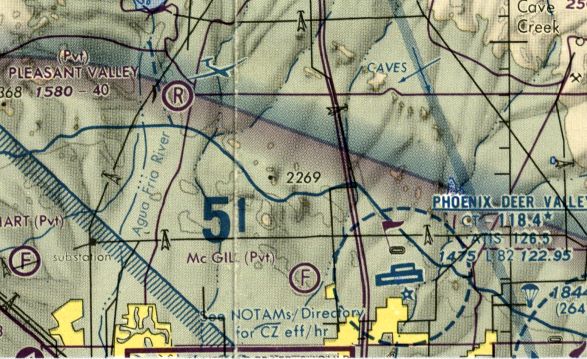
McGill Ultralight Field, as depicted on the 1988 Phoenix Sectional Chart (courtesy of Jonathan Westerling).
DS reported, “This was my wife's grandparent's land & airfield; Clyde & Millie McGill.
Wonderful people, lots of great memories on this mountain.
They built an adobe home (the namesake of Adobe dam rec area) in the 1940s, along with a windmill that pumped water from a deep well to a holding tank on the East mountain.
They once had a thriving farm on in the valley with corn & other crops!
These folks were hardcore homesteaders that would make today's hobby farmers look soft.
When they arrived after WW2, it was almost an hour drive the city of Phoenix.”
This short-lived airfield for ultralight aircraft was evidently established at some point between 1971-78,
as it was not yet depicted on a 1971 aerial photo.
The earliest depiction which has been located of McGill Ultralight Field was a 1978 aerial photo,
which may have depicted the very beginnings of the airfield,
with a single unpaved east/west runway having been carved from the desert.
No airfield at this location was depicted on the 1981 USGS topo map or the November 1985 Phoenix Sectional Chart (courtesy of John Voss).
A 1986 aerial view showed a 2nd unpaved runway (oriented north/south) had been added at McGill Ultralight Field.
The earliest aeronautical chart depiction which has been located of McGill Ultralight Field was on the 1988 Phoenix Sectional Chart (courtesy of Jonathan Westerling).
It depicted McGill as a private ultralight flight park.
A 1993 aerial view showed McGill Ultralight Field had gained a 3rd unpaved runway, oriented northeast/southwest,
along with a cluster of T-hangars to the south of the runways.
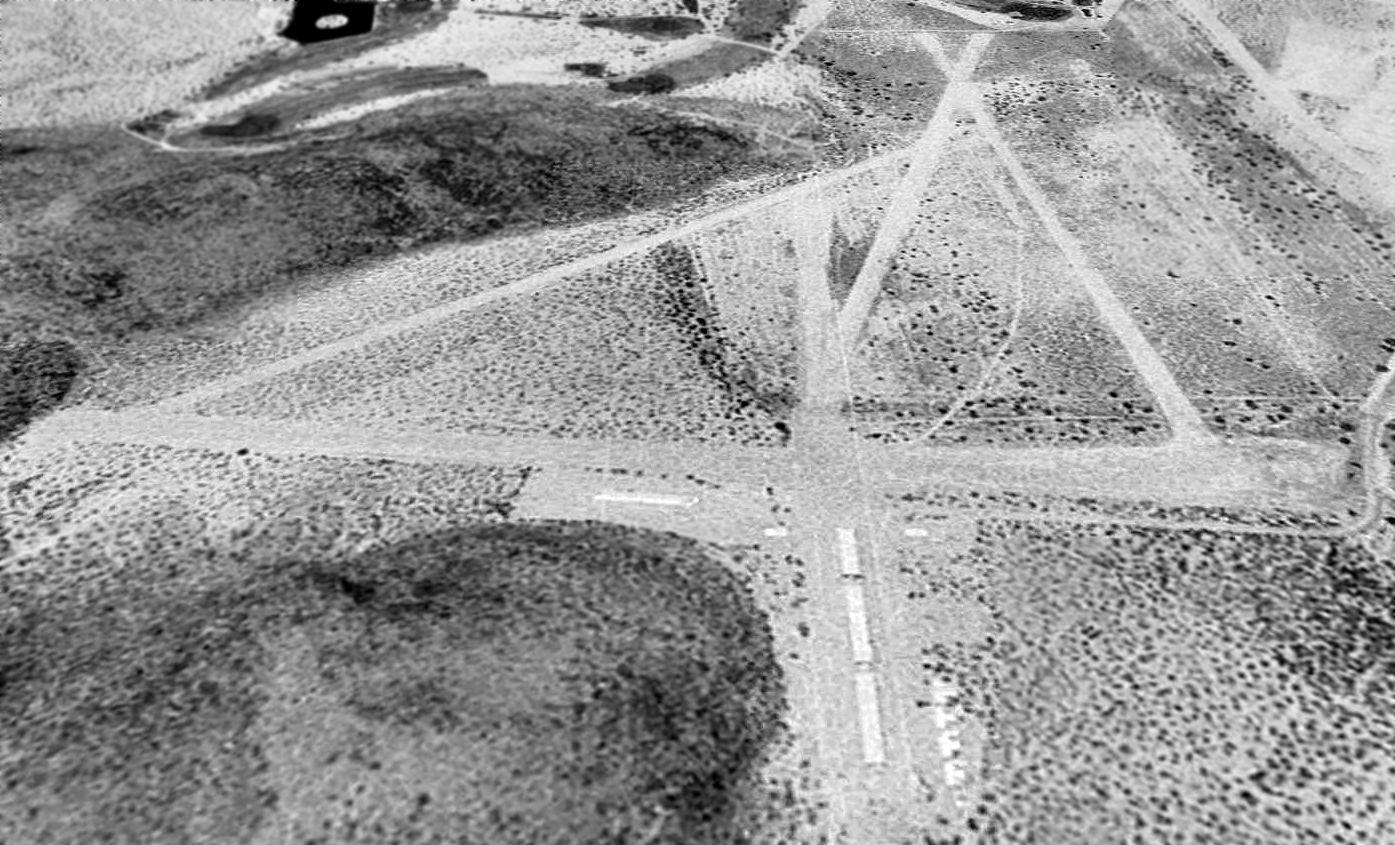
A 1997 USGS aerial view looking north at McGill Ultralight Field.
Steve Petttyjohn reported, “This was a wonderful ultralight flying field up until the late 1990s when a greedy developer wanted to build on the nearby hillsides & didn't want recreational ultralights buzzing around.
The county was all too complacent in shutting down the field as they wanted the hangars for storage of the county vehicles & equipment.
So they evicted the ultralight flying club which was there for many years including members of the McGill family which where the original homesteaders.
The club actually owned the hangars & disassembled & took them away. The developer never had the funds to build the luxury homes on the hillside.
The remains of the field lay derelict for years until some private company made a paintball field on the land.
This was so tragic as the old ultralight field was such a nice complement to the other recreational uses of the area
which included a model railroad, remote control flying field, golf course, go cart track, and waterslide park.”
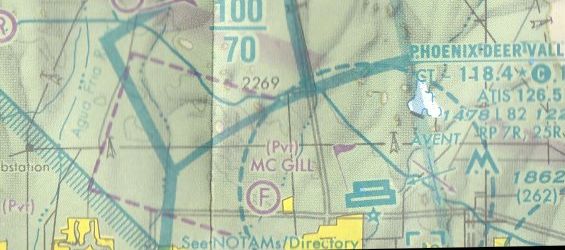
The last aeronautical chart depiction which has been located of McGill Ultralight Field was on the April 2002 Phoenix Sectional Chart.
It depicted McGill as a private ultralight flight park.
A 2004 aerial view showed that all of the hangars (except for 1 T-hangar) appeared to have been removed,
with only their foundations remaining.
McGill Ultralight Flightpark was no longer depicted on the 2006 Phoenix Sectional Chart (courtesy of Jonathan Westerling).

A circa 2010-2016 aerial view looking north at the T-hangar foundations (& one which appears to remain standing)
on the south side of the site of McGill Ultralight Field.
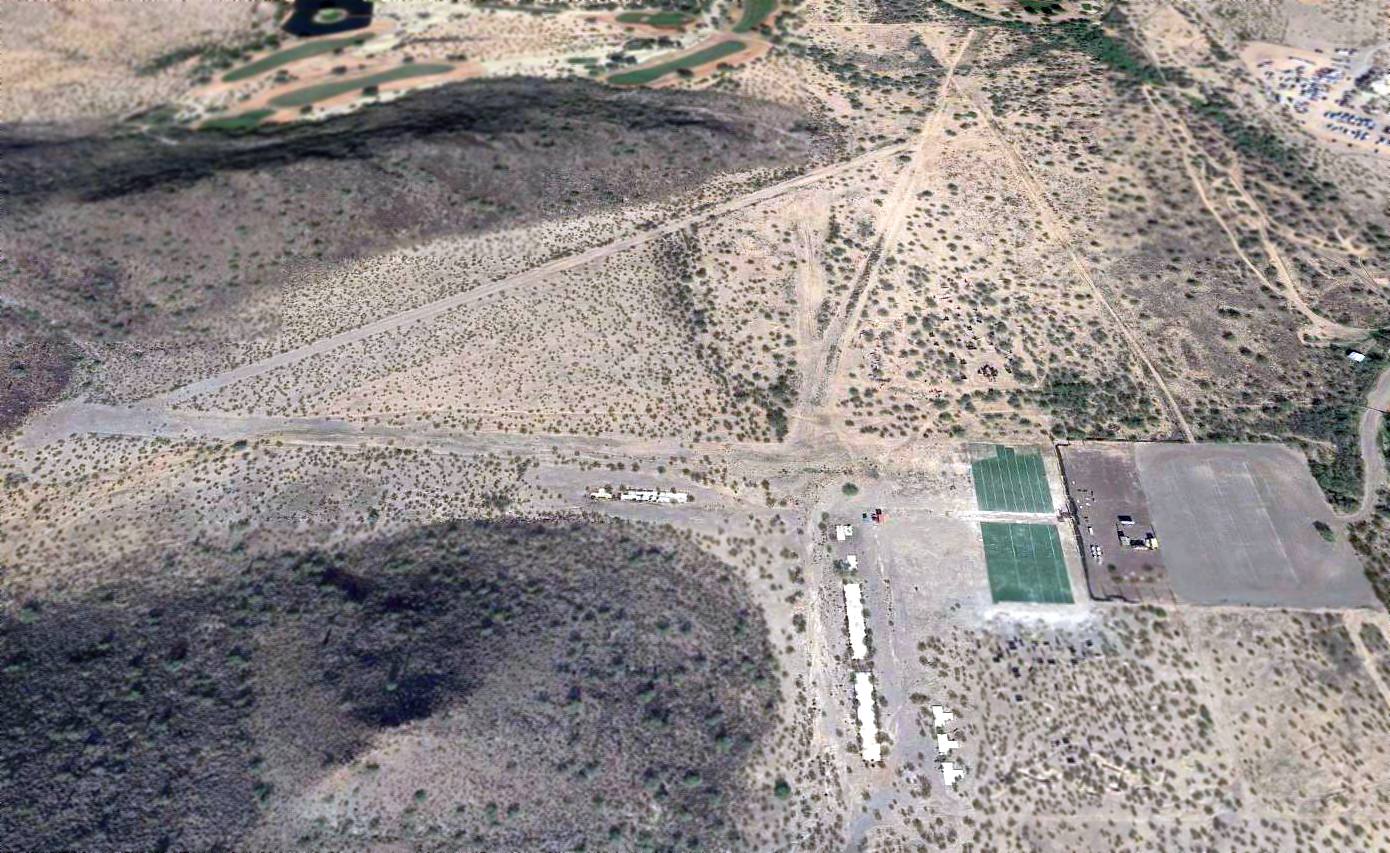
A 2015 aerial view looking north at the remains of McGill Ultralight Field.
As of 2016, street maps show the site of McGill Ultralight Field to be located within Adobe Dam Recreation Area.
DS reported, “The home just below the city water tank is now gone. Sadly, it was burned by vandals in 2020. It was vacant at the time.
It's all owned by the city now. We're glad to see the residents of North Phoenix enjoying the land.”

A 2021 photo looking southwest at the McGill Ultralight Field entrance gate.
The site of McGill Ultralight Field is located southwest of the intersection of West Pinnacle Peak Road & North 43rd Avenue.
Thanks to Doug Landers for pointing out this airfield.
____________________________________________________
(Original) Airhaven Airport, Alhambra, AZ
33.49, -112.12 (Northwest of Phoenix, AZ)
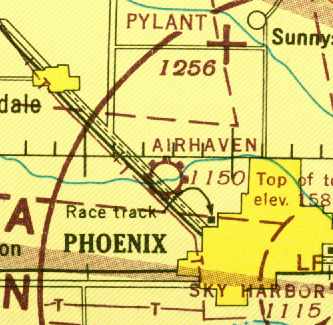
Airhaven Airport, as depicted on the March 1946 Phoenix Sectional Chart (courtesy of David Brooks).
Airhaven Airport was not yet depicted on a 1937 aerial photo,
on the August 1943 Regional Aeronautical Chart (courtesy of Kevin Walsh)
or the March 1945 Phoenix Sectional Chart (courtesy of Ron Plante).
According to Ron Chavez's book “The Valley's Airports of the Past”,
“Phoenix Airhaven Airport Inc. began as a business venture in June of 1945 by 2 businessmen, M. Fanning & S. Stewart after the end of WW2.
Fanning & Stewart leased farm land from L.H. Seargeant
and after an agreement was reached construction was to begin on the runways in July of 1945,
but before construction could be started sometime in 1946 the business venture was sold to L.L Monsees & H. Holtzman.”
The earliest aeronautical chart depiction which has been located of Airhaven Airport
was on the March 1946 Phoenix Sectional Chart (courtesy of David Brooks),
which depicted Airhaven as a commercial/municipal field.
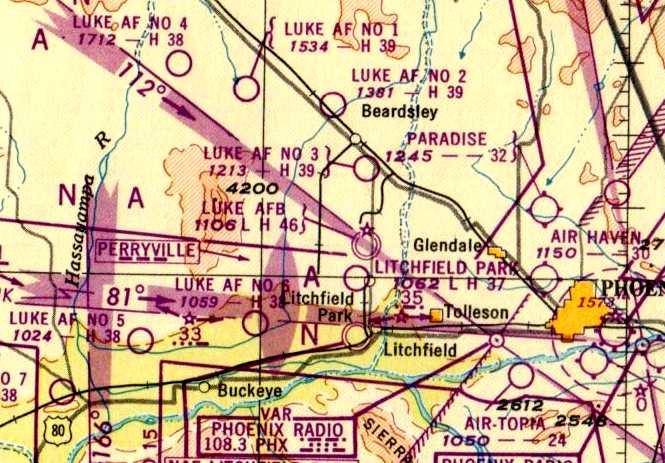
The 1947 Gila River World Aeronautical Chart depicted Air Haven Airport as having a 3,000' unpaved runway.

The 1948 USAF Phoenix Urban Area Chart (courtesy of Scott O'Donnell)
depicted Air Haven has having two 1,700' runways (oriented northeast/southwest & northwest/southeast),
each with a parallel taxiway.
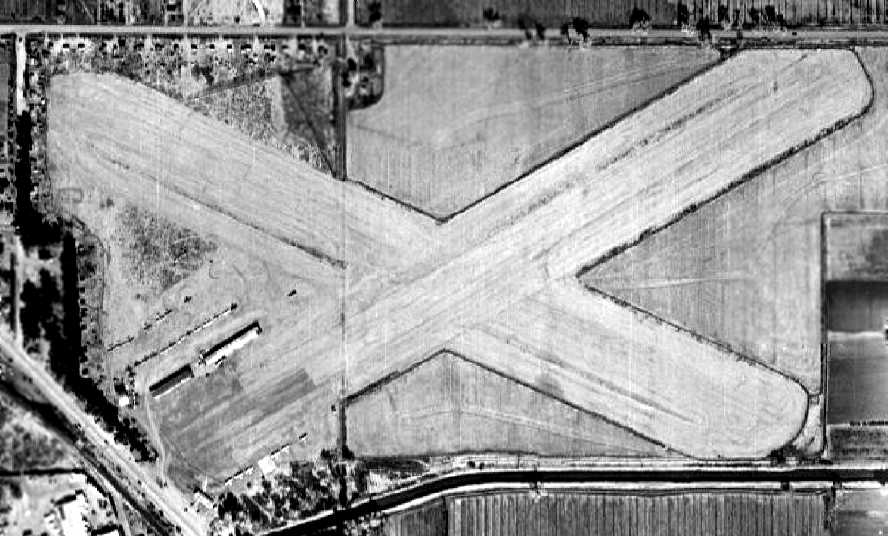
The earliest photo which has been located of the Airhaven Airport
was a 2/14/49 aerial view (from the Maricopa County Flood Control District).
It depicted the field as having 2 unpaved runways in an 'X' shape.
More than 2-dozen light aircraft were parked around a few small buildings on the southwest side of the field.

Airhaven Airport, as depicted on a 1949 street map (courtesy of Kevin Walsh).
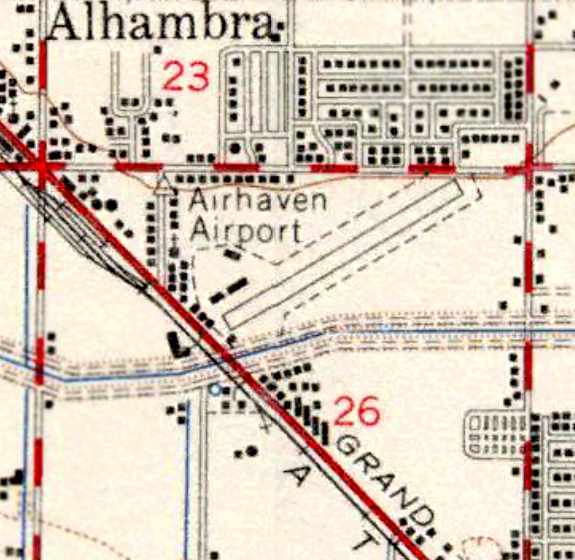
Airhaven evidently lost its crosswind runway at some point between 1949-52,
as the 1952 USGS topo map depicted Airhaven Airport as having a single northeast/southwest runway.

A circa 1950s advertisement for Phoenix Airhaven Airport (from Ron Chavez's book “The Valley's Airports of the Past”, enhanced by Bill Grasha)
described the field as being “One of the largest schools for flying instruction in AZ.”
The Aerodromes table on the reverse side of the 1956 Phoenix Sectional chart (courtesy of John Voss),
described Airhaven as having a single 3,000' bare runway.
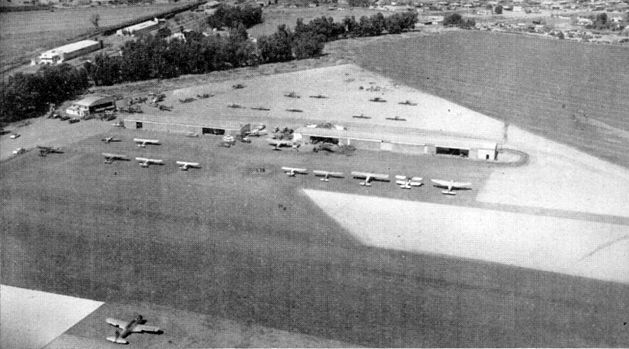
An undated aerial view looking west at Airhaven Airport from a January 1957 article (courtesy of Jerry Sorrell),
which described Airhaven as having a 3,200' runway on 130 acres.
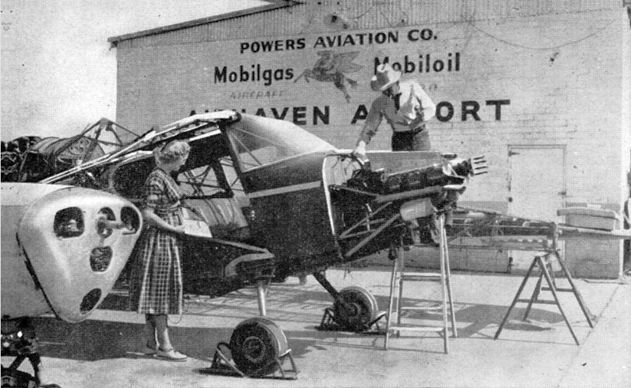
An undated photo of the Powers Aviation Company repair area at Airhaven Airport from a January 1957 article (courtesy of Jerry Sorrell),
which was captioned, “Mrs. Powers checks the upholstery, while Alabam looks over a faulty engine.”
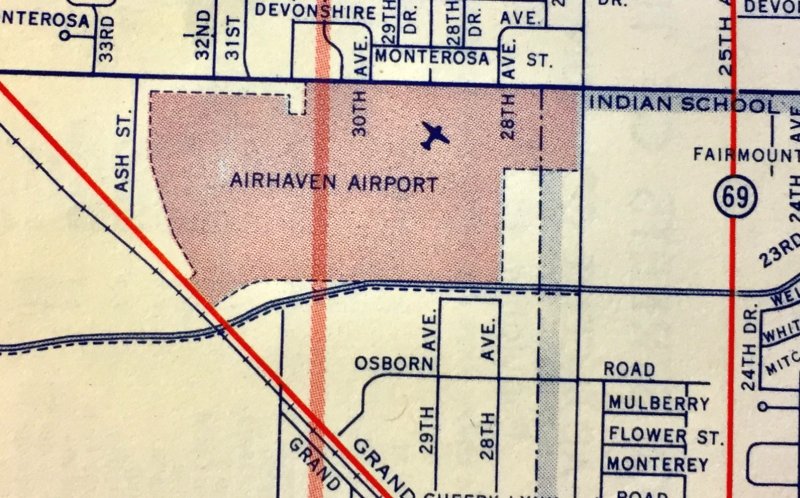
A 1958 streeet map (courtesy of Kevin Walsh) depicted Airhaven Airport as an east/west oriented property outline.
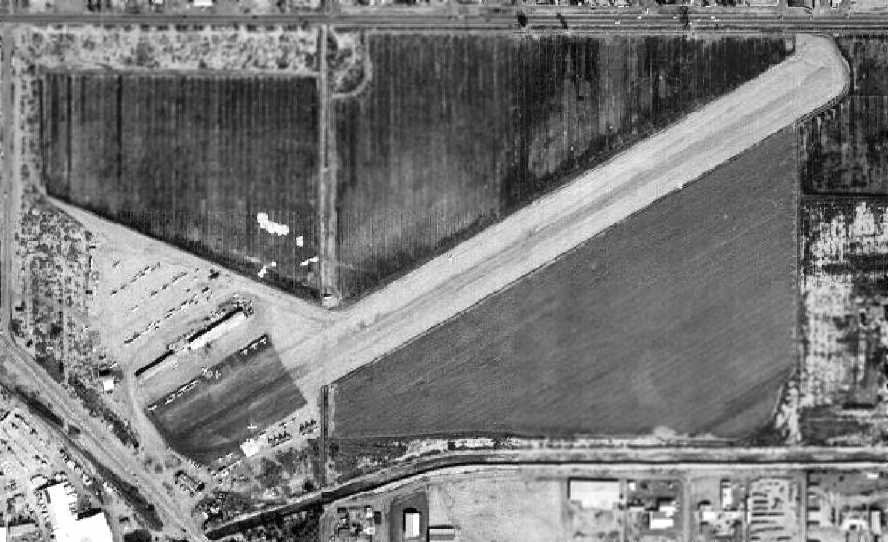
A 2/15/59 aerial view (from the Maricopa County Flood Control District)
depicted Airhaven Airport as having a single unpaved northeast/southwest runway,
with the land of the former crosswind runway having been returned to cultivation.

A closeup from the 2/15/59 aerial view (from the Maricopa County Flood Control District, enhanced by Bill Grasha),
showing dozens of light planes parked around the hangars on the southwest side of the field.
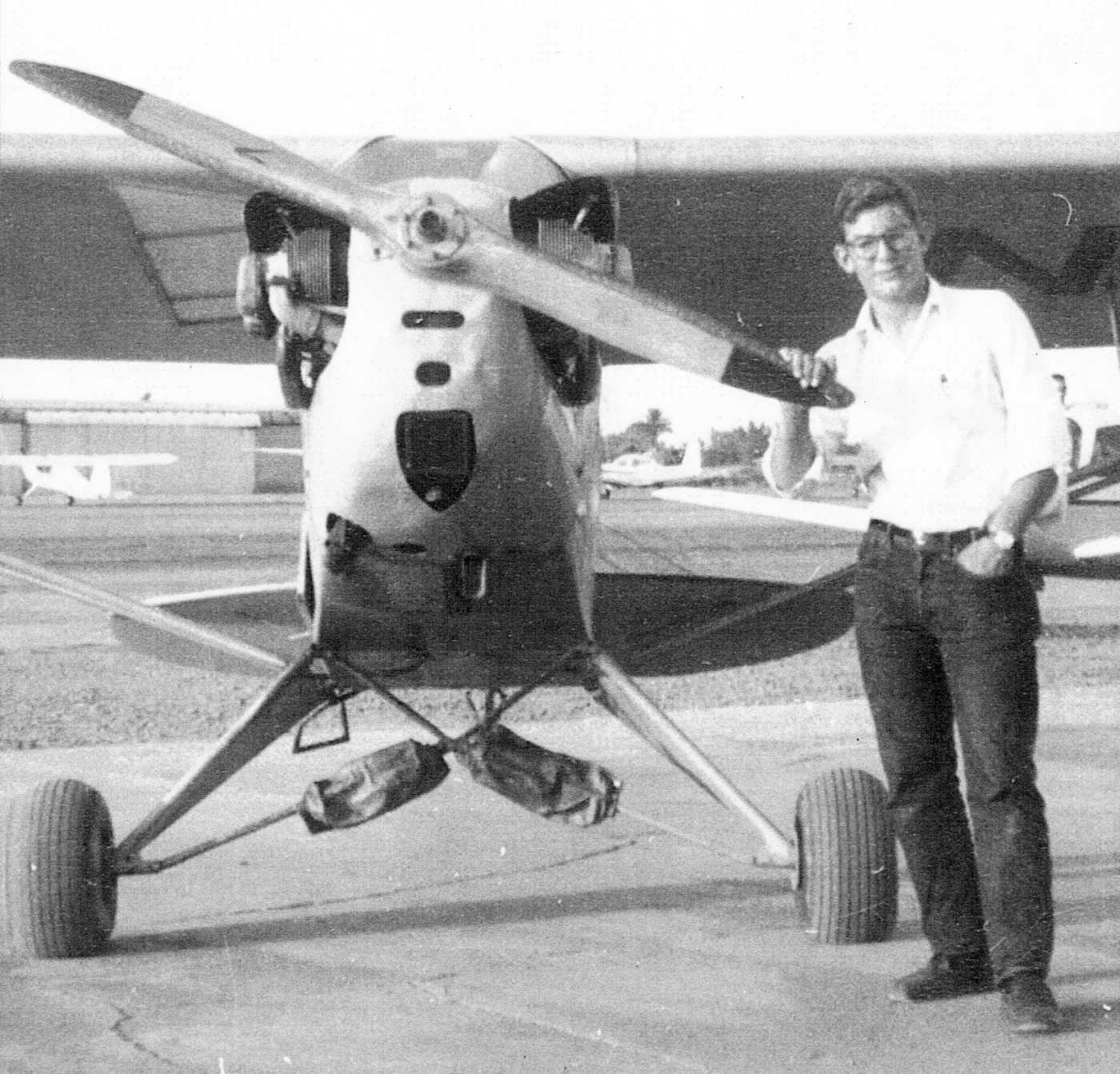
The last photo which has been located of the Airhaven Airport was an 11/13/59 photo of a 17 year-old Jim Hackman with a Piper Cub upon the occasion of his first solo flight.
Jim observed, “I was skinny & had hair!”

The 1960 Jeppesen Airway Manual (courtesy of Chris Kennedy)
depicted Airhaven as having a single 3,200' paved Runway 5/23,
with a parallel taxiway on the northwest side leading to a ramp at the west side of the field with a few small buildings.
According to Ron Chavez's book “The Valley's Airports of the Past”,
“In mid-1960, Phoenix Airhaven Airport began winding down its operation.”
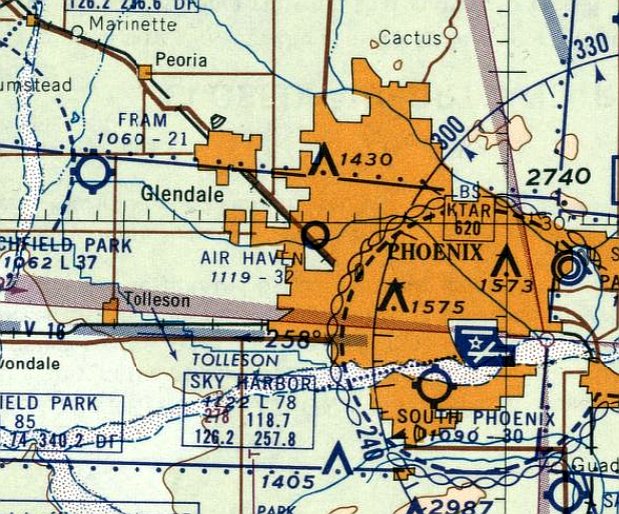
The last aeronautical chart depiction which has been located of Air Haven Airport was on the March 1961 Phoenix Sectional Chart.
It depicted Air Haven Airport as having a 3,200' unpaved runway.
According to Ron Chavez's book “The Valley's Airports of the Past”,
“In 1961 the airport property was purchased by a development company
and afterwards Phoenix Airhaven Airport ceased operations after 15 years.”
Airhaven was no longer depicted at all on the March 1962 Phoenix Sectional Chart (according to Chris Kennedy).
According to Ron Chavez's book “The Valley's Airports of the Past”,
“In 1963 the developer tore down the hangar offices & plowed over the runway to make room for construction.”
A 1964 aerial view (from the Maricopa County Flood Control District)
showed that the airport site had been scraped clean, for future redevelopment,
and not a trace appeared to remain of the airport.
A 1970 aerial view showed that several buildings had been constructed over the site.
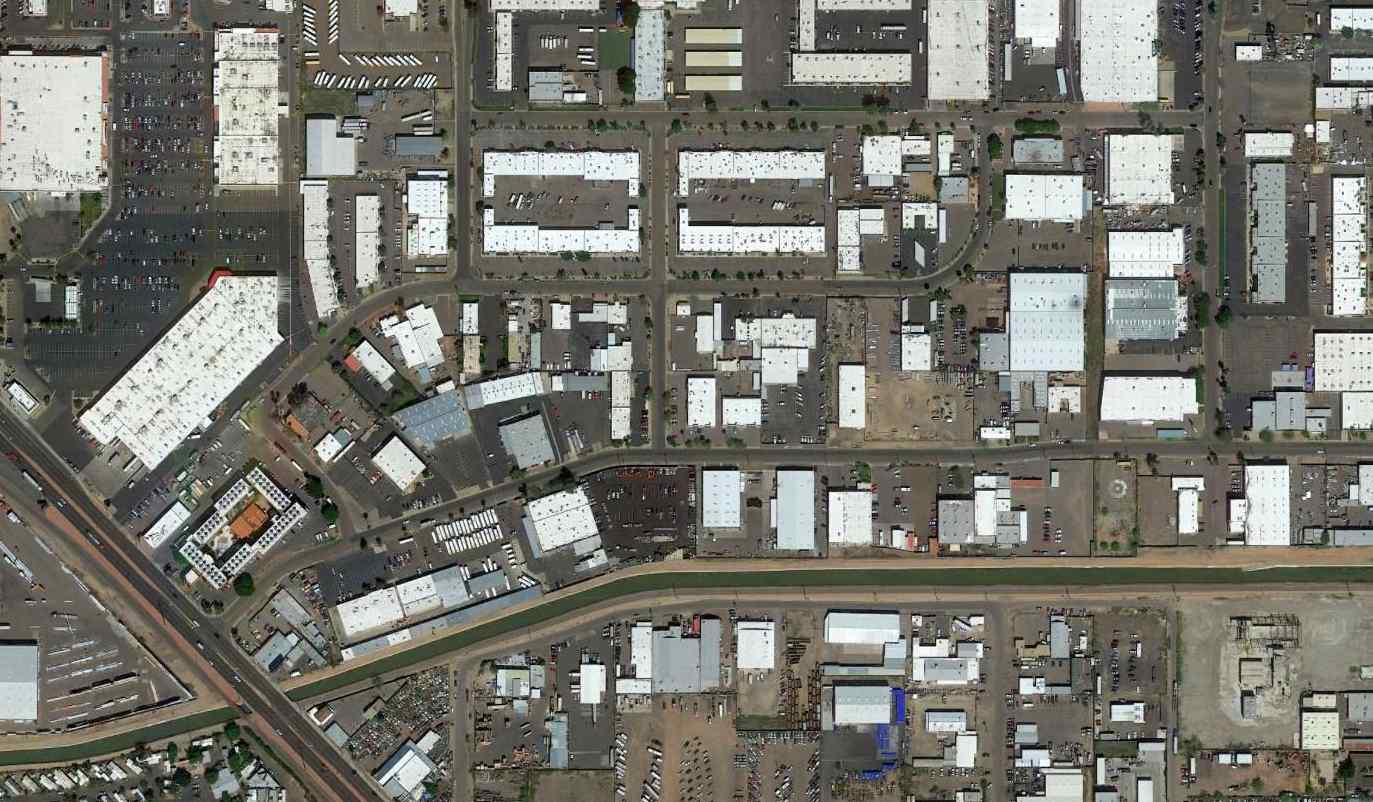
A 2015 aerial photo showed no trace remaining at the site of Airhaven Airport.
The site of Airhaven Airport is located southeast of the intersection of West Grand Avenue & West Indian School Avenue, just north of the Grand Canal.
The name Airhaven was later used by a separate airfield in Peoria, 8 miles northwest.
____________________________________________________
Isbell Construction Company Airfield / Air Haven Airport / (Original) Glendale Municipal Airport (P37), Peoria, AZ
33.57, -112.23 (Northwest of Phoenix, AZ)
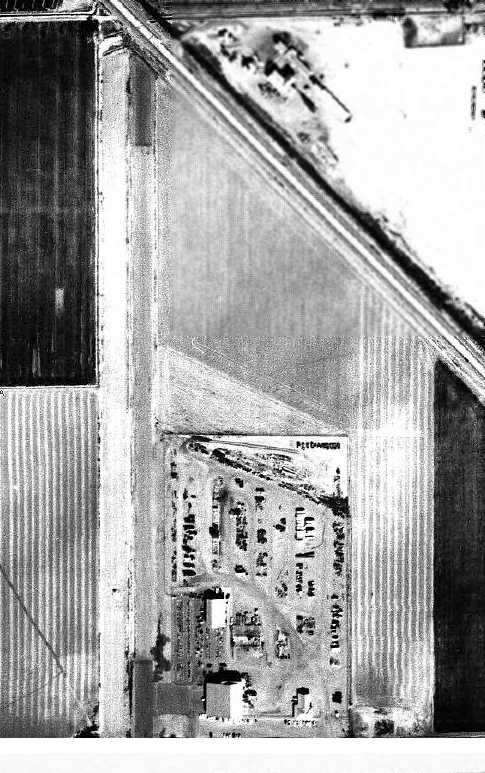
The Isbell Construction Company Airfield, as depicted on a 2/20/59 aerial view (from the Maricopa County Flood Control District).
No airfield was yet depicted at this location on a 1949 aerial photo.
According to Ron Chavez's book “The Valley's Airports of the Past”, this airfield “began as the Isbell Construction Company Airfield,
a privately-owned airstrip built in 1955 at 75th & Olive Avenues.
The airport was used as an aerial crop seeding & spraying operation,
had a dirt strip that measured 2,400', and ran in a north/south direction (17/35) between Grand & Olive Avenues.”
The Isbell Construction Company Airfield was not yet depicted on the 1956 Phoenix Sectional chart (courtesy of John Voss).
The earliest depiction of this airfield which has been located was a 2/15/59 aerial view (from the Maricopa County Flood Control District).
It depicted the field as having a single north/south runway,
with a hangar & at least one other smaller building on the southeast side of the runway.
No planes were visible on the field.
A 1964 aerial view (from the Maricopa County Flood Control District) depicted the field in the same configuration.
The Isbell airfield was apparently not depicted on aeronautical charts at first
(which may be done at the owner's request, for a private airfield),
as it was not depicted at all on the July 1965 Phoenix Sectional Chart (courtesy of Ron Kunse).
The 1966 AOPA Airport Directory (according to David Brooks) described the “Isbell Construction Company” airfield at this location in Glendale
as a private field, operated by Arizona Helicopters, Inc.
The field was said to consist of a single 2,400’ bituminous Runway 17/35.
The field was said to have tie-downs for emergency use only, and the remarks said, ““This is an agricultural spraying operation. Use at own risk.”
According to Ron Chavez's book “The Valley's Airports of the Past”, “After the closure of Paradise & Phoenix Airhaven Airports,
the Isbell Construction Company Airfield became available for general public use & general aviation aircraft began using the airport in 1966.”
The Isbell airfield was still not depicted on the January 1966 Phoenix Sectional Chart (according to Chris Kennedy)
or the January 1968 Phoenix Sectional Chart (according to Chris Kennedy).
The 1968 AOPA Airport Directory (according to David Brooks)
described “Isbell Construction Company” as a private airfield, having the same configuration as described in 1966.
According to Ron Chavez's book “The Valley's Airports of the Past”,
“The name of the airport was changed to Glendale Airhaven Airport.”

The July 1968 Phoenix Sectional Chart (courtesy of David Brooks)
depicted the renamed Air Haven Airport as having a single 2,400' paved north/south runway,
matching the configuration of the “Isbell Construction Company” airfield.
A January-March 1969 aerial view (from the Maricopa County Flood Control District)
depicted the field with the same physical layout as earlier photos,
but now with over 2-dozen light aircraft parked on the south side.
The 1970 AOPA Airport Directory (according to David Brooks)
described “Air Haven” as having a single 2,600’ blacktop Runway 17/35.
The field was said to have tie-downs.
The operators were listed as Air Haven Airport Service (a Cessna dealer) & Precision Helicopters (a Hughes dealer).
The January 1971 Phoenix Sectional Chart (courtesy of Ron Plante)
depicted Air Haven Airport as having a single 2,400' paved north/south runway.
The 1972 Phoenix Sectional Chart (courtesy of David Brooks) depicted “Glendale - Air Haven”
as having a single 2,400' paved runway.
The 1973 Phoenix Sectional Chart (courtesy of David Brooks) depicted the field simply as “Glendale”.
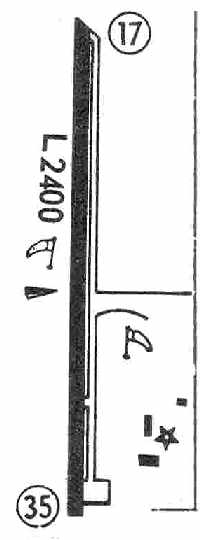
The 1977 Flight Guide (courtesy of Chris Kennedy) depicted Glendale Municipal Airport
as having a single 2,400' paved Runway 17/35 with a parallel taxiway on the east side,
leading to a ramp on the southeast corner of the field with a few small buildings.
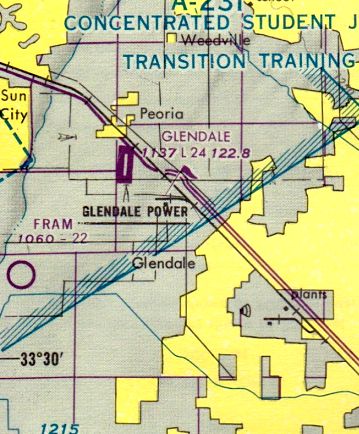
The 1977 Phoenix Sectional Chart close-up portion (courtesy of Ron Plante)
depicted Glendale Airport as having a single 2,400' paved north/south runway.
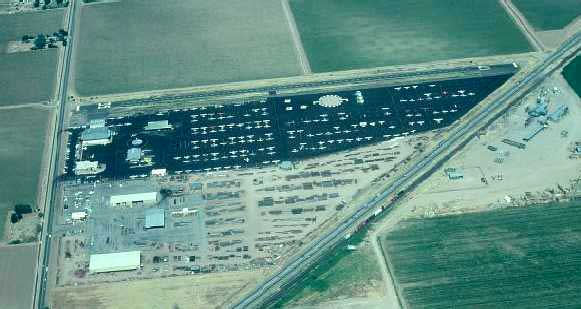
A 6/2/79 aerial view by Brian Baker (enhanced by Bill Grasha) looking west at Glendale Airport, showing a huge number of light aircraft parked on the field.
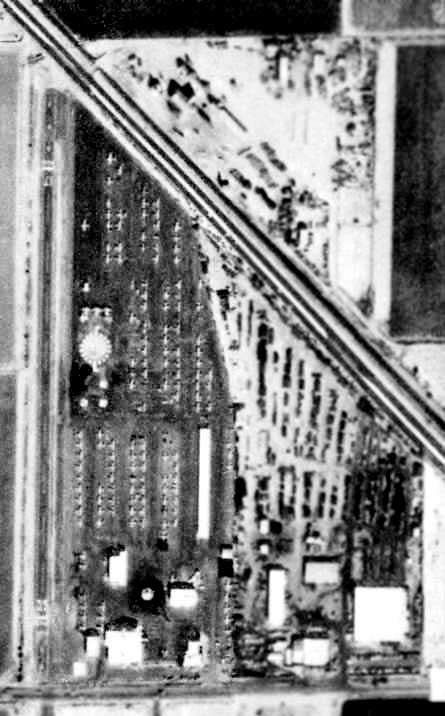
A 1982 aerial photo (courtesy of John Arthur, enhanced by Bill Grasha) showed that the aircraft parking ramp
had increased to over double the area depicted in the 1970 photo.
Over 100 aircraft were visible parked on the field.

A circa 1980s photo by Matt Gunsch of a Globe Swift at the original Glendale Municipal Airport.

A circa 1980s photo by Matt Gunsch of a North American T-6 Texan in front of an Alexander Aircraft Service hangar at the original Glendale Municipal Airport.

A circa 1980s photo by Matt Gunsch of N37690, a Frank Turben Scamp experimental biplane at the original Glendale Municipal Airport.
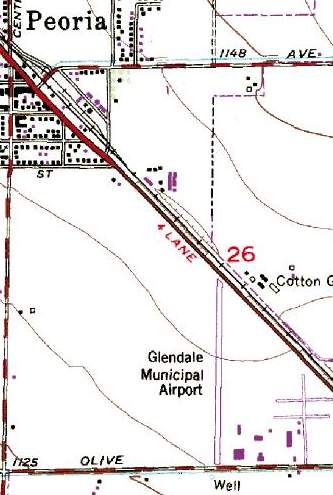
The 1982 USGS topo map depicted Glendale Municipal Airport as having a single north/south paved runway.
The 1982 AOPA Airport Directory (courtesy of Ed Drury)
described Glendale Municipal Airport as having a single 2,400' asphalt Runway 17/35.
The operators were listed as Royal Helicopter & Marketing,
Flight Tech, Arizona Airplanes, Blue Baron Inc., and Alexander Aircraft Service.
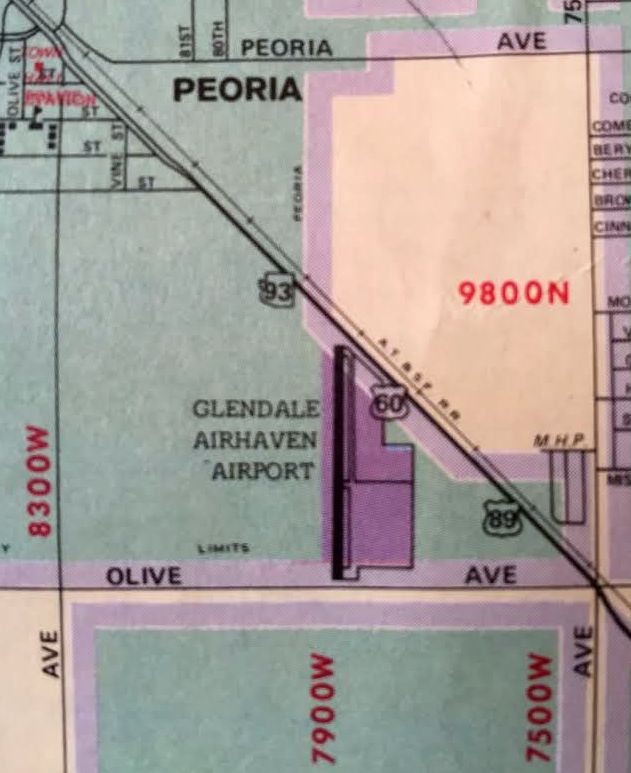
The last map depiction which has been located of Glendale Airhaven Airport was on a 1983 street map (courtesy of Kevin Walsh).
According to Ron Chavez's book “The Valley's Airports of the Past”,
“In the early 1980s, the City of Glendale planners decided to build a new airport at Glendale Avenue & Glen Harbor Boulevard
that would allow plenty of space for expansion.
Plans were also in the works to terminate operations at Glendale Airhaven Municipal Airport.”
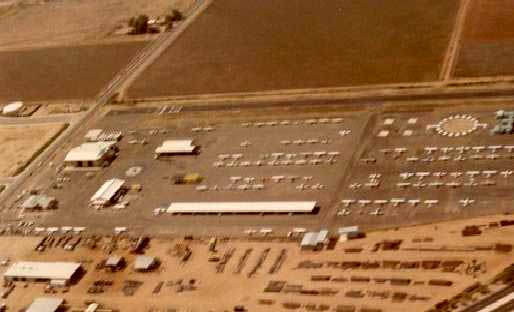
The last photo which has been located showing the original Glendale Airport still in operation
was a 1983 aerial view looking west by Stephen Mahaley (enhanced by Bill Grasha).
Stephen flew Cessnas at the original Glendale Airport in the early 1980s,
and recalled "the runway was 2,600' with the threshold displaced a couple of hundred feet at each end
due to the roads at each end of the end of the runway."
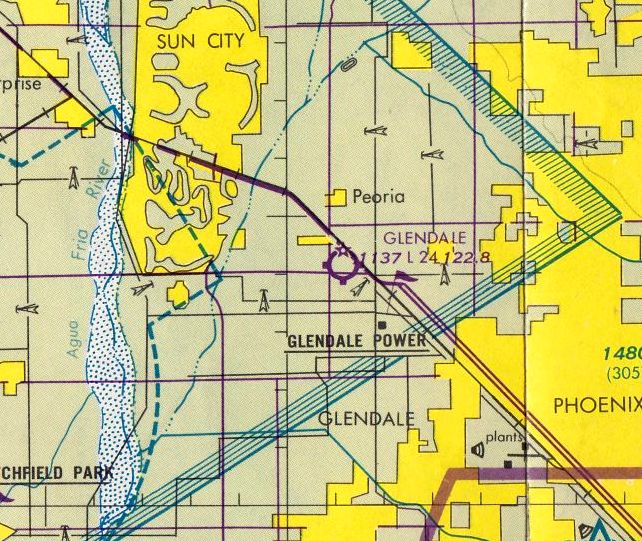
The last chart depiction which has been located of the original Glendale Airport was on the November 1985 Phoenix Sectional Chart (courtesy of David Brooks).
Only the new Glendale Airport was depicted on the 1987 Phoenix Sectional Chart (according to David Brooks).
According to Ron Chavez's book “The Valley's Airports of the Past”,
“The city closed operations at Glendale Airhaven Airport & the property was sold off to private owners.”
However, the location of the original Glendale Airport continued to have a more-limited aviation role,
as starting in 1987 it was listed as a private heliport, the “Sunstate-Glendale Helistop (2AZ2)”.
It was said to have a 100' square concrete/asphalt helipad,
owned by the Sunstate Equipment Corporation, with the managers listed as Mike & Dave Watts.
The 1988 USGS topo depicted the original airfield as having a single 2,500' runway, oriented north/south.
The runway ran right up to Grand Avenue at its northern end, and Olive Avenue at the south.
A 1/21/93 aerial view (from the Maricopa County Flood Control District)
depicted the old Glendale Airport after it had been closed, with no aircraft visible on the property, which otherwise remained intact.
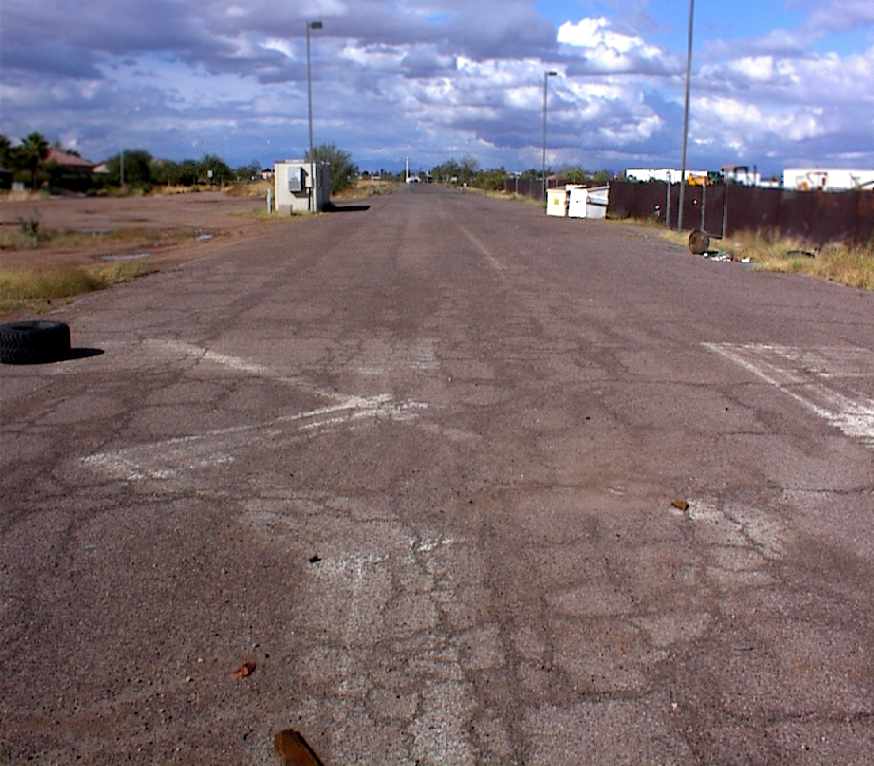
A 2005 photo by Rick Tejera looking north along the remains of Runway 35.
The former runway numbers, and the closed-runway “X” symbol were still clearly recognizable.
Rick Tejera reported in 2005, “I recently visited Glendale, Airhaven
and found it to be remarkably intact for not having been used for 14 years.
The runway & taxiway markings are still visible & the remnants of the segmented circle are still there,
along with the helipads (from the original helicopter operation at this field I presume).
The area beyond the taxiway is marked as private property
so I did not venture in to look for old tie-downs or other airport features.”
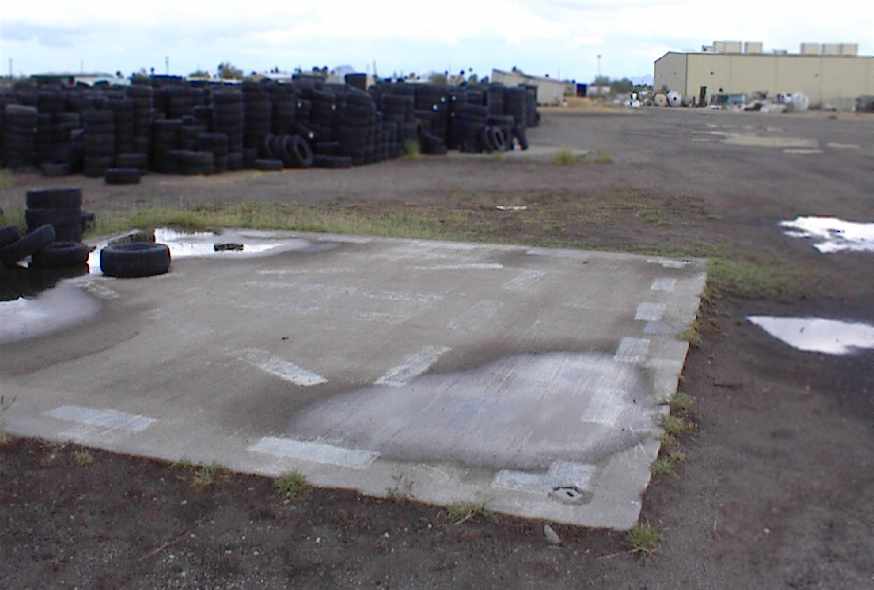
A 2005 photo by Rick Tejera, “looking east from the main taxiway at one of 4 helipads in a square
(visible in the aerial photo as small white squares).
This one was the only one not covered in old tires.
The area now seems to be occupied by recycling & salvage businesses.”
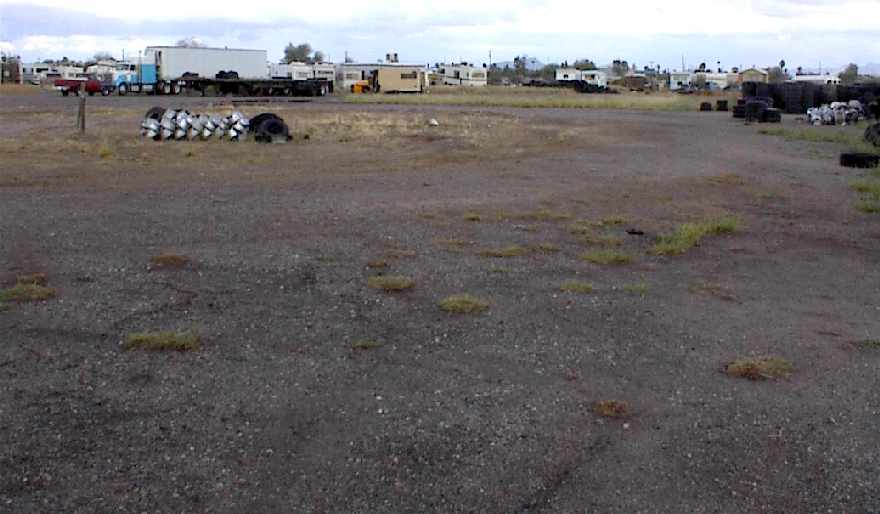
A 2005 photo by Rick Tejera. “The round berm of dirt is the remains of the segmented circle, located just north of the helipads.
There are no remnants of the pattern indicators
and the area between the segmented circle & helipads is covered with old tires piles about 15' high.”
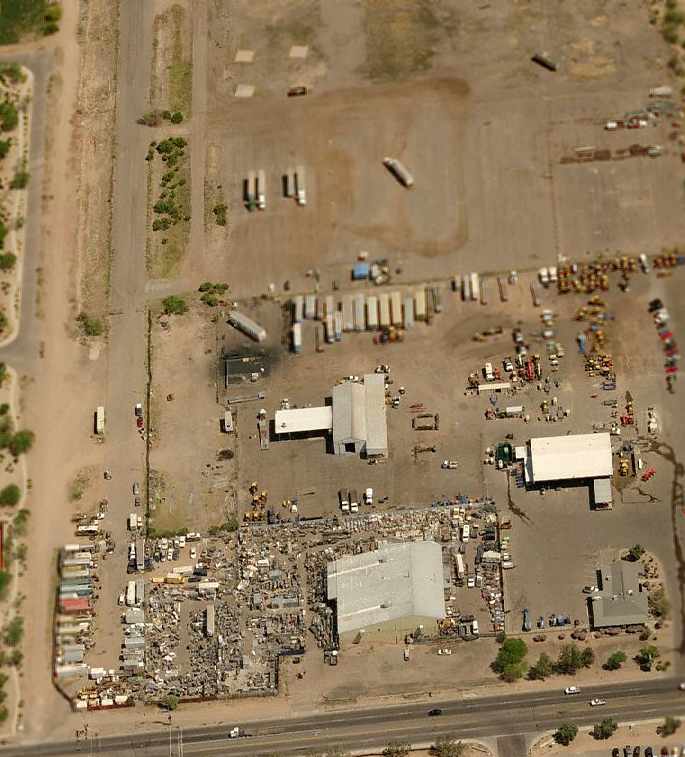
A circa 2006 aerial view looking north at the south end of the original Glendale Municipal Airport,
showing the 3 remaining former hangars.
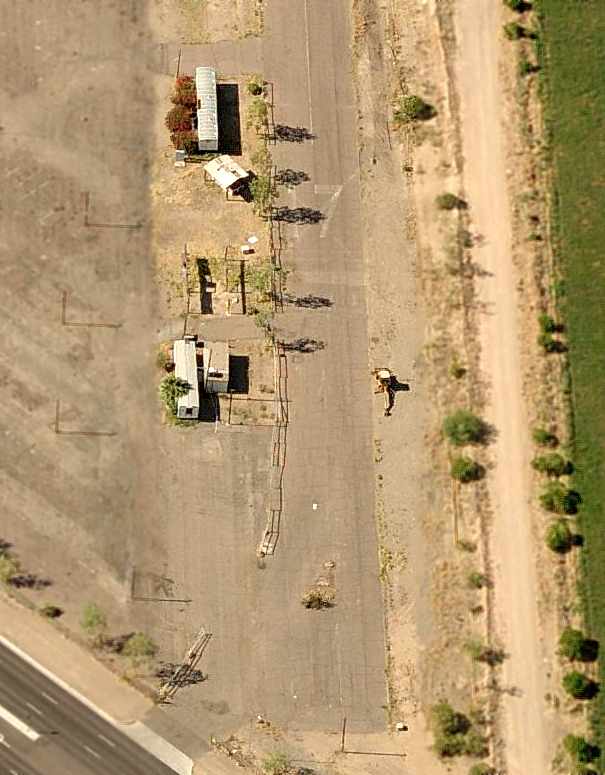
A circa 2006 aerial view looking south at the Runway 17 markings
which are still barely visible at the site of the original Glendale Municipal Airport.
As of 2009 the “Sunstate-Glendale Helistop (2AZ2)” on the property was still listed as a private heliport.

A 2015 aerial view looking northwest showed the majority of the former runway of the original Glendale Municipal Airport still remains,
along with what look to be some original airport hangars & the large paved ramp area in the foreground.
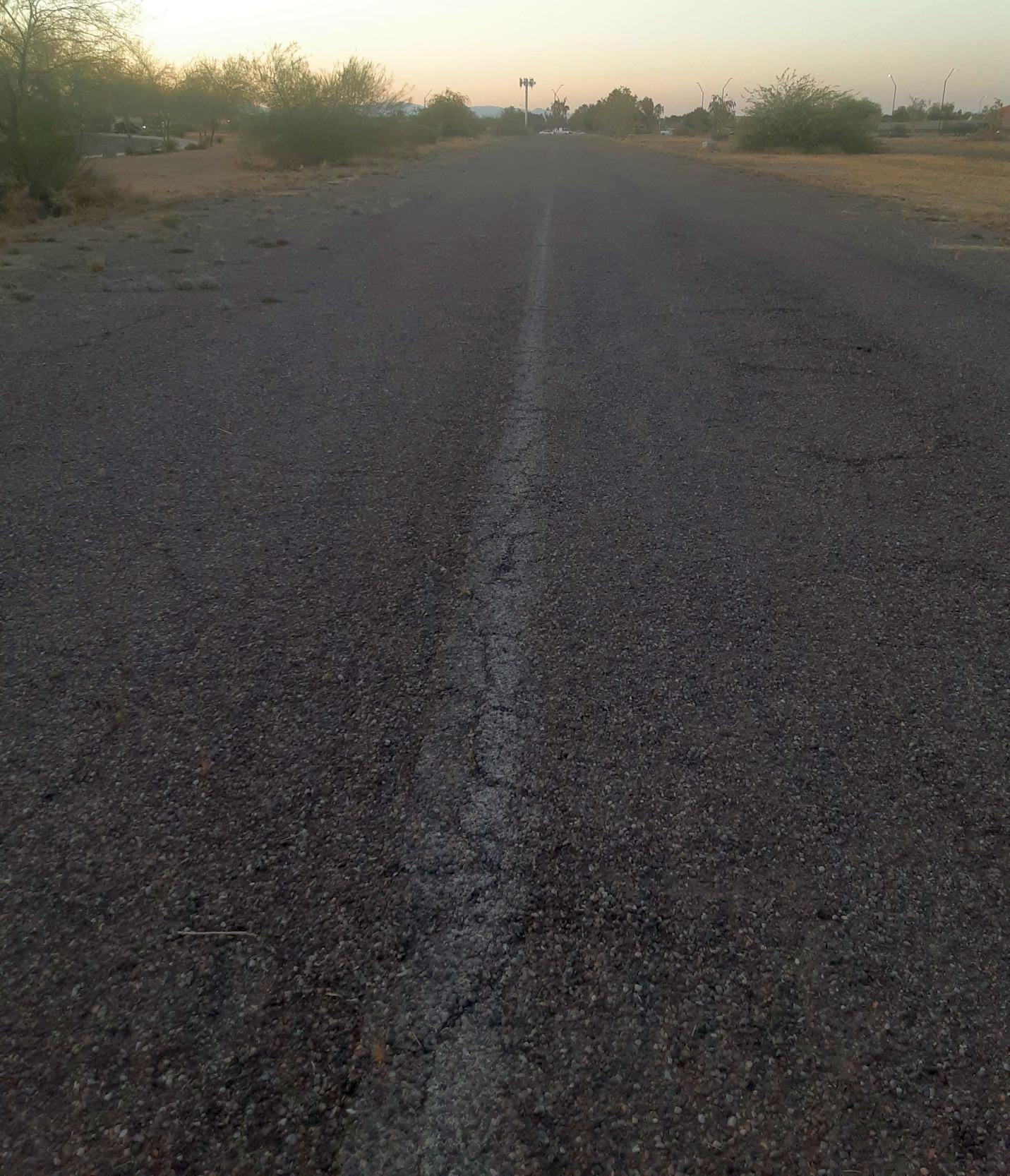
A 5/7/21 photo by Matt Gunsch looking along the former runway of the original Glendale Municipal Airport.
Matt reported, “The runway is fairly intact, but there is a section that has been removed. The markings for Runway 17 were still visible, as were some of the centerline markings.”

A 5/7/21 photo by Matt Gunsch of the remains of one helipad which could be site at the site of the original Glendale Municipal Airport.

A 5/7/21 photo by Matt Gunsch of the remains of Tiedown #4, one of several which could be seen at the site of the original Glendale Municipal Airport.
The site of the original Glendale Municipal Airport is located north of the intersection of West Olive Avenue & North 79th Avenue.
____________________________________________________
Thunderbird Field #1, Glendale, AZ
33.62, -112.18 (Northwest of Phoenix, AZ)
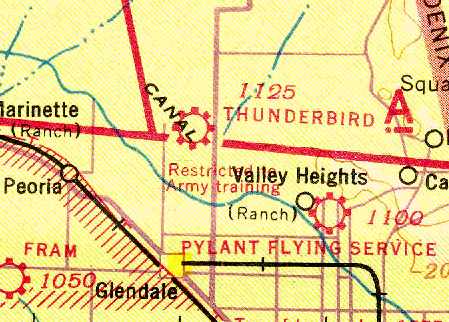
Thunderbird Field, as depicted on the September 1941 Phoenix Sectional Chart (courtesy of Chris Kennedy).
Thunderbird Field #1 was one of 4 contract flying schools operated in the Phoenix area by Southwest Airways.
According to Nelda Crowell, Archivist of the Thunderbird School of Global Management,
“The 3 men most responsible for developing the Thunderbird Fields
were Leland Hayward, a movie producer & actor; John Connelly, a test pilot;
and John Swope, secretary-treasurer of Southwest Airways & a Life Magazine photographer married to actress Dorothy McGuire.”
The site was laid out to look from the air like an etching of a mythical Anasazi Thunderbird, and so it was called Thunderbird Field.
Thunderbird Field was also known as Thunderbird #1,
due to the presence of 3 other Thunderbird Fields run by Southwest Airways
(at the eventual locations of Falcon Field, Scottsdale Airport, and adjacent to Sky Harbor Airport).
Thunderbird Field #1 began construction on 1/2/41 (according to Nelda Crowell, Archivist of the Thunderbird School of Global Management).
Thunderbird Field was a contract flying school, operated by Southwest Airways.
They were contracted to train American, Canadian, British & Chinese military pilots.
Stearman biplane trainers were operated at Thunderbird.
The installation consisted of a number of hangars, barracks, and other buildings.
Adjacent to the buildings to the southeast was a 2,800' square ramp area,
and across West Greenway Road to the north was the airfield itself, with three 3,500' runways.
Thunderbird Field #1 was ready for operations on 3/22/41 (according to Nelda Crowell, Archivist of the Thunderbird School of Global Management).
The earliest depiction of the field which has been located was on the September 1941 Phoenix Sectional Chart (courtesy of Chris Kennedy).
It depicted "Thunderbird" as a commercial airfield, but with the note “Restricted to Army training.”
Stewart, Carmichael and the other backers paid $25,000 per month for fuel
until 1942, when the US Army Air Corps took over control & funding of the pilot training at Thunderbird.
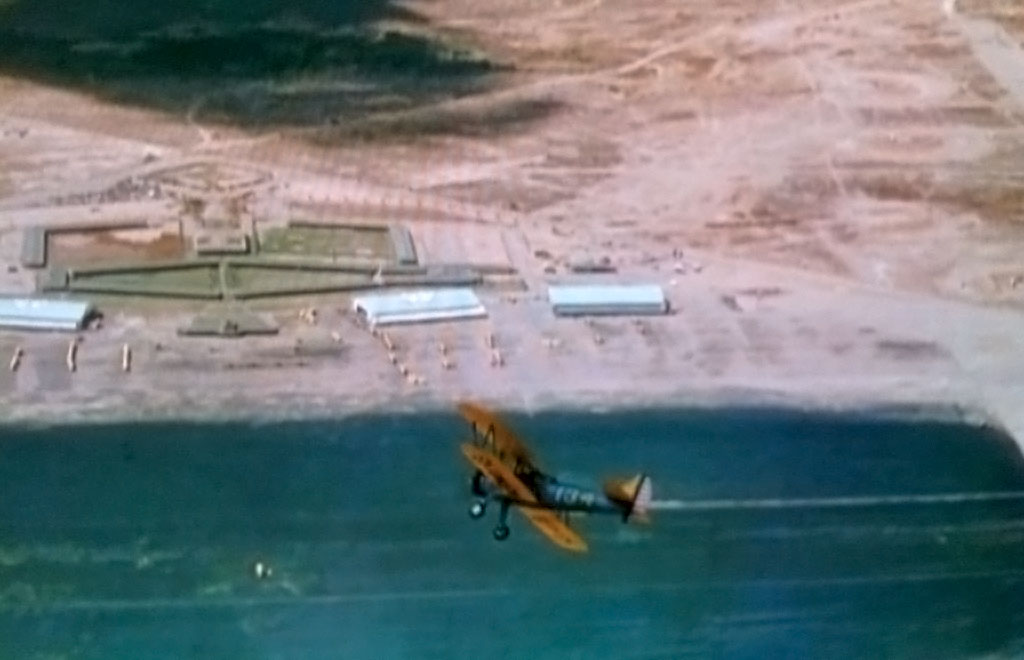
The earliest photos which has been located of Thunderbird Field was a series of stills from the 1942 movie “Thunder Birds” (courtesy of Tim Tyler, enhanced by Bill Grasha).
This is an an aerial view looking northwest at a Stearman overflying the Thunderbird hangars, with dozens of Stearmans visible on the ramp

An aerial view looking northwest at the Thunderbird logo on top of one of the hangars, from the 1942 movie “Thunder Birds” (courtesy of Tim Tyler, enhanced by Bill Grasha).
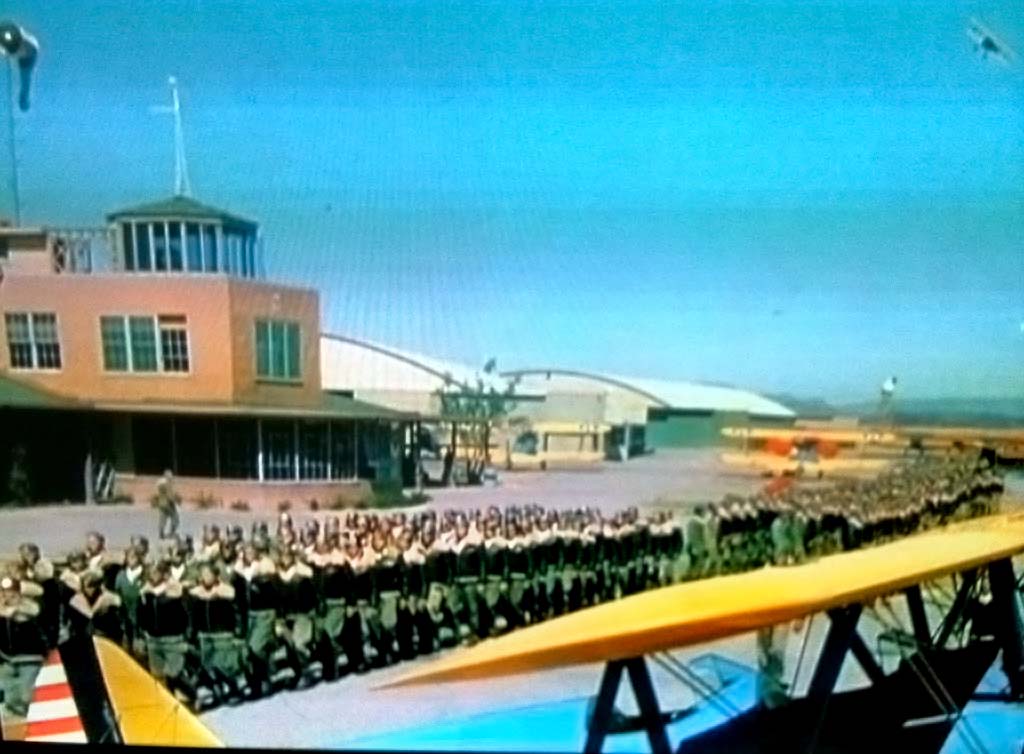
A still from the 1942 movie “Thunder Birds” (courtesy of Tim Tyler, enhanced by Bill Grasha) showing Stearman trainers & cadets marching in front of the Thunderbird control tower.

A circa 1942 aerial view looking south at Thunderbird Field showed a huge number of trainers on the ramp,
along with several on the paved landing mat.
A series of 3 runways extended toward the north across the road in the foreground.

A 1942 aerial view by Steve Magdich looking south at Thunderbird Field from a PT-17 Stearman (courtesy of Lon Magdich).
Lon Magdich recalled, “Thunderbird Field... My father was a Primary Flight Instructor there from April 1942 through January 1944.

A 1942 photo by Steve Magdich of the Thunderbird Field control tower (courtesy of Lon Magdich).
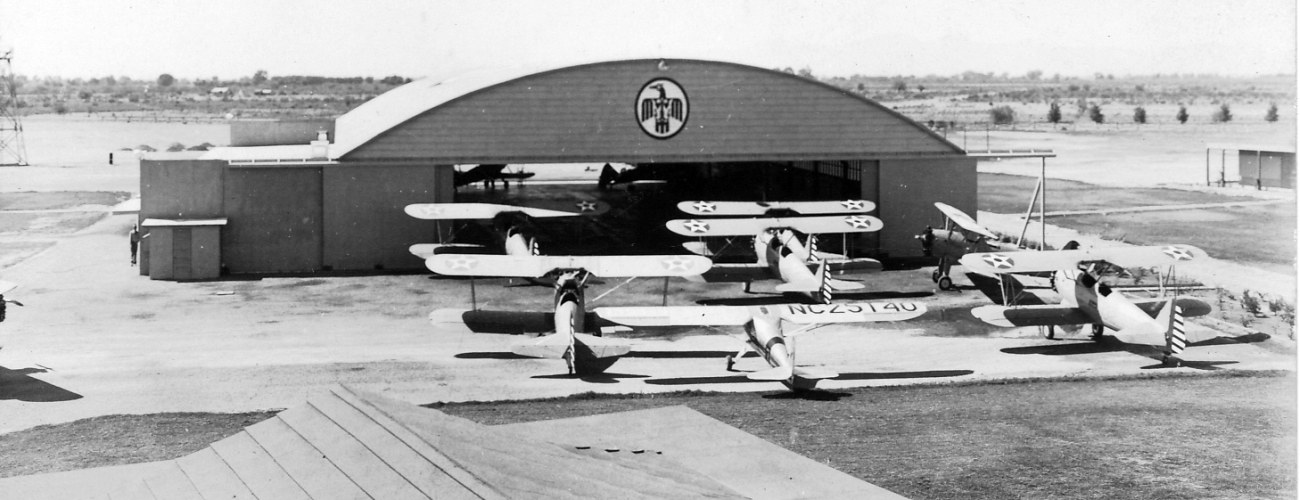
A circa 1942 photo by Steve Magdich of Stearman biplane trainers in front of Thunderbird Field's B hangar, taken from the control tower (courtesy of Lon Magdich).

A 1943 photo of Thunderbird Field flight students (front row) & instructors (back row) (courtesy of Lon Magdich).
Lon Maddich observed his father, Steve Magdich, is on the back row at right.
The February 1943 Phoenix Sectional Chart (courtesy of Chris Kennedy) depicted "Thunderbird" as a military airfield.

Two WW2-era photos (courtesy of Tammy McLaughlin-Underwood) of flight instructors at Thunderbird Field,
including her father Morris McLaughlin, her Uncle Wallace Pankratz, and his best friend Jerry McWayne.
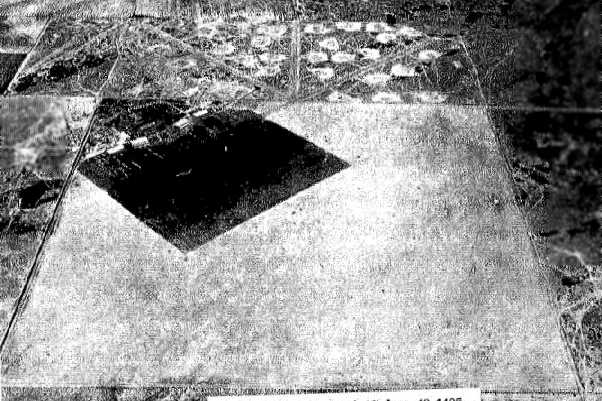
A 6/17/43 aerial view looking north from the 1945 AAF Airfield Directory
depicted Thunderbird Field as having a number of hangars, barracks, and other buildings
on the southeast corner of West Greenway Road & North 59th Avenue.
The airfield consisted of a 2,800' square paved landing mat,
and across West Greenway Road to the north was another three 3,500' runways.
Surrounding the runways were a large number of revetments or bunkers (of unknown purpose).
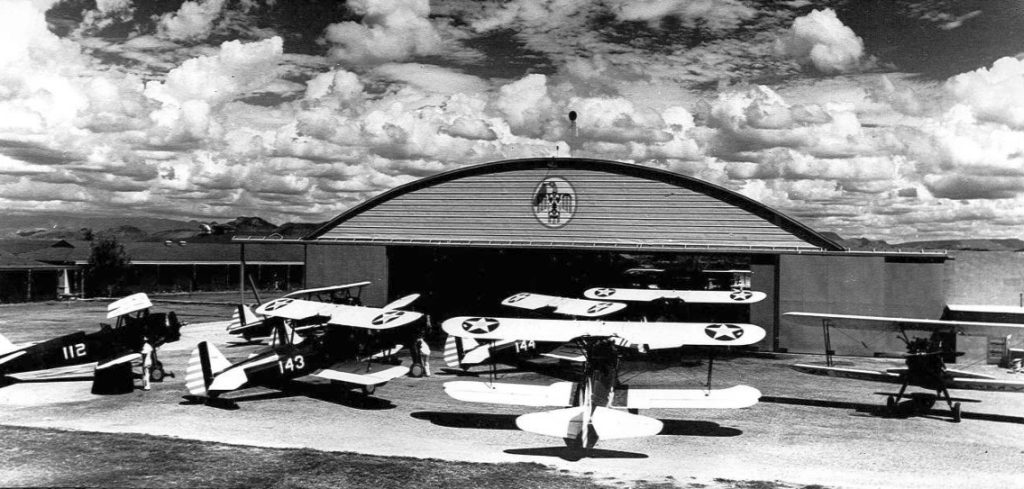
A circa 1943 photo (enhanced by Bill Grasha) of Stearman PT-17 biplanes in front of a Thunderbird hangar (decorated with the school's logo).

A 1943 photo (enhanced by Bill Grasha) of a Vultee BT-13 Valiant monoplane & a Stearman biplane in front of a Thunderbird hangar (decorated with the school's logo).
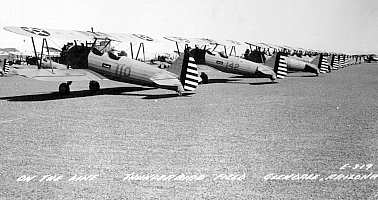
A circa 1941-45 photo of Stearman biplane trainers at Thunderbird Field.

A circa 1941-45 photo of Stearman biplane trainers inside a Thunderbird hangar (enhanced by Bill Grasha).
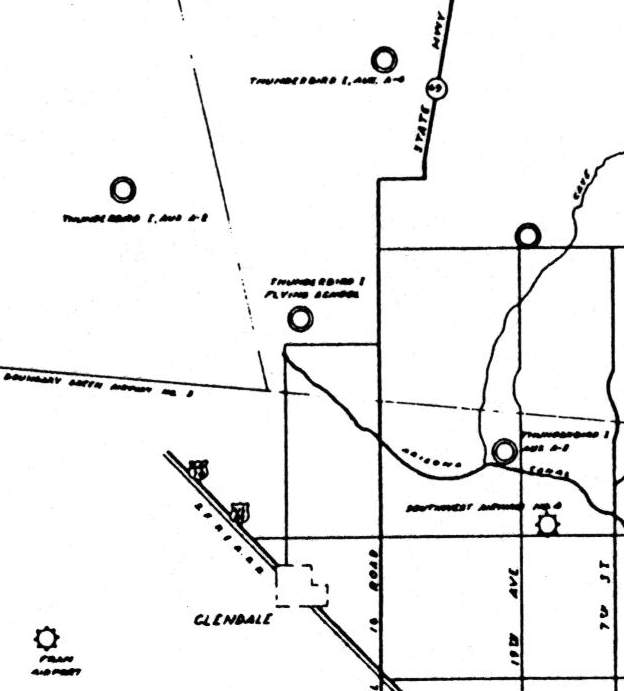
A 1944 USAAF map of Thunderbird Field (center of map) & its satellite airfields (courtesy of John Voss).
During WW2, Thunderbird Field had several auxiliary airfields,
including Thunderbird #1 Aux A-1, Thunderbird #1 Aux A-2, Thunderbird #1 Aux A-3,
and Southwest Airways #4 (located 7 miles southeast, of which no recognizable airfield remains).

The layout of Thunderbird Field as depicted on a WW2-era document (from the Air Force Historical Research Agency, via Brian Rehwinkel).
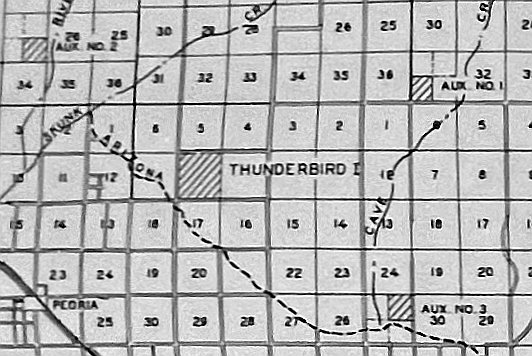
Thunderbird Field & its 3 auxiliary airfields, as depicted on a WW2-era document (from the Air Force Historical Research Agency, via Brian Rehwinkel).
"Thunderbird #1" was still depicted as a commercial airfield on the March 1945 Phoenix Sectional Chart (courtesy of Chris Kennedy).
The 1945 AAF Airfield Directory (courtesy of Scott Murdock) described Thunderbird Airport #1
as a 640 acre square property within which was a 5,280' square bare all-way field, with a 2,582' x 1,850' oiled mat in the northwest corner,
and 3 dirt runways (the longest of which were the 3,200' northeast/southwest & northwest/southeast strips),
which were “N of field & are extensions of main landing area.”
Thunderbird #1 was said to have four 200' x 102' wood & metal hangars.
The field was described as being privately owned & operated,
and to have 3 auxiliary fields.
Thunderbird Field #1 closed on 6/27/45 (according to Nelda Crowell, Archivist of the Thunderbird School of Global Management).
Following the end of WW2, Thunderbird Field was declared surplus by the War Assets Administration in 1946.
That same year, Thunderbird was given for free by the federal government to Lt. General Barton Yount,
the commanding general of the U.S. Army Air Training Command.
He established the American Institute for Foreign Trade, and classes reportedly began on the site within a few months.
However, the airfield at Thunderbird may have continued in operation alongside the new school for some time,
as Thunderbird Field continued to be depicted on aeronautical charts for several more years.
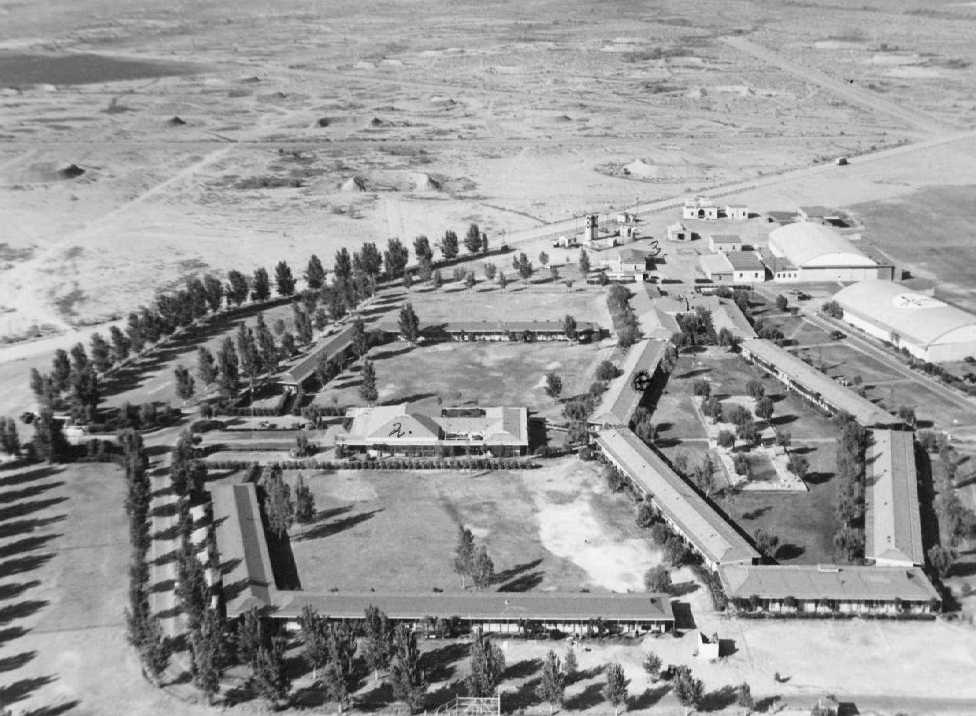
A 1946 aerial view looking northeast at the buildings of Thunderbird Field, by that point reused as the American Institute for Foreign Trade.
The 2 hangars are seen on the right, and the 3 runways in the background on the north side of the road.
Thunderbird Field was not depicted on the 1947 Gila River World Aeronautical Chart.
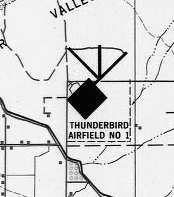
The layout of Thunderbird #1, as depicted on the 1948 USAF Phoenix Urban Area Chart (courtesy of Scott O'Donnell),
with the large landing mat on the south side, and 3 runways to the north.
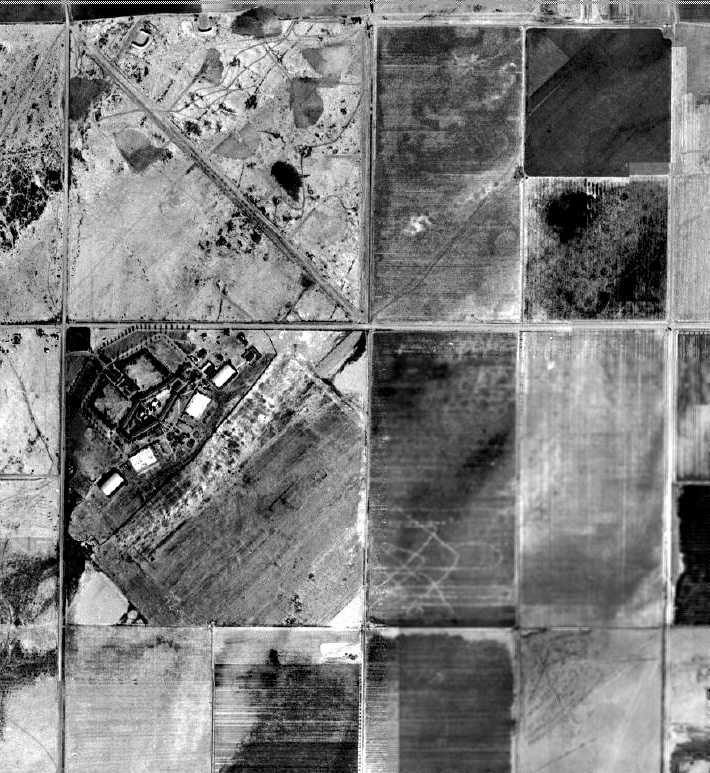
A 2/14/49 aerial view (from the Maricopa County Flood Control District)
depicted the Thunderbird hangars & landing mat on the south side of the field.
It also clearly showed the taxiway on the northeast side of the ramp leading to West Greenway Road,
and the remains of the 3 runways on the north side of the road.
The path of the north/south runway had become North 55th Avenue, north of West Greenway Road.
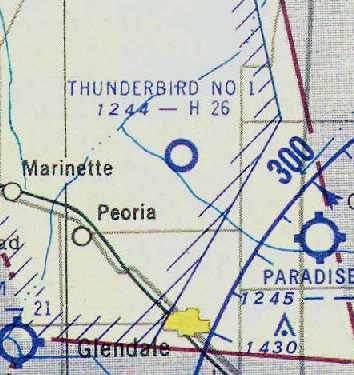
"Thunderbird #1" was still depicted on the September 1953 Phoenix Sectional Chart (courtesy of Chris Kennedy).
The Aerodromes table on the chart described the field as being "Attended 24 hours",
and it was said to consist of a single 2,580' hard surface runway.
Thunderbird Field was apparently closed at some point between 1953-54,
as it was no longer depicted on the September 1954 Phoenix Sectional Chart (according to Chris Kennedy).
A 1958 aerial view of Thunderbird Field (courtesy of John Arthur)
did not show any significant difference compared to the 1949 aerial photo -
the hangars & former ramp area remained intact, without any redevelopment.

A 1965 aerial view looking southeast at Thunderbird Field showed that the hangars & former landing mat remained intact.
Note also the complete lack of any surrounding residential development.
According to Nelda Crowell, Archivist of the Thunderbird School of Global Management,
“After the property was given to the American Institute for Foreign Trade, the runway remained intact for many years.
In the late 1960s, the school President, Arthur Peterson, flew his private plane onto the grounds to his campus residence.”
A 1970 aerial view still showed the former airfield in a basically unchanged state.
Brian Baker recalled of the former Thunderbird Field, “The last airplane I saw there was [in 1976].”
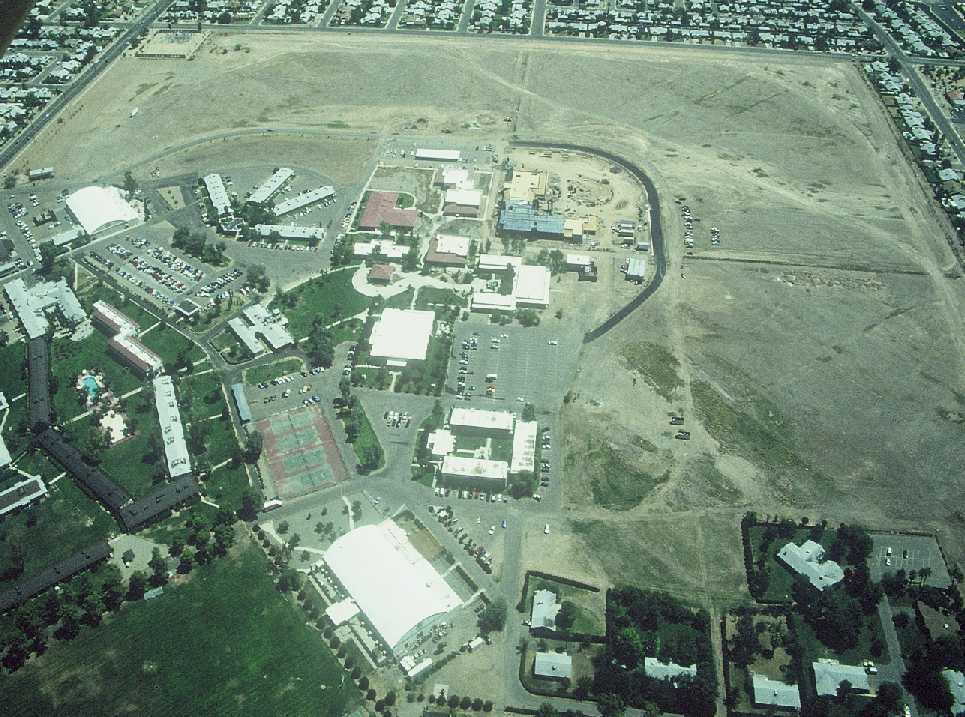
A 8/21/91 aerial view by Brian Baker looking east at the site of Thunderbird Field
showed that a significant amount of construction had been conducted by the Thunderbird School between 1970-91,
but many of the WW2-vintage airfield buildings remained standing.
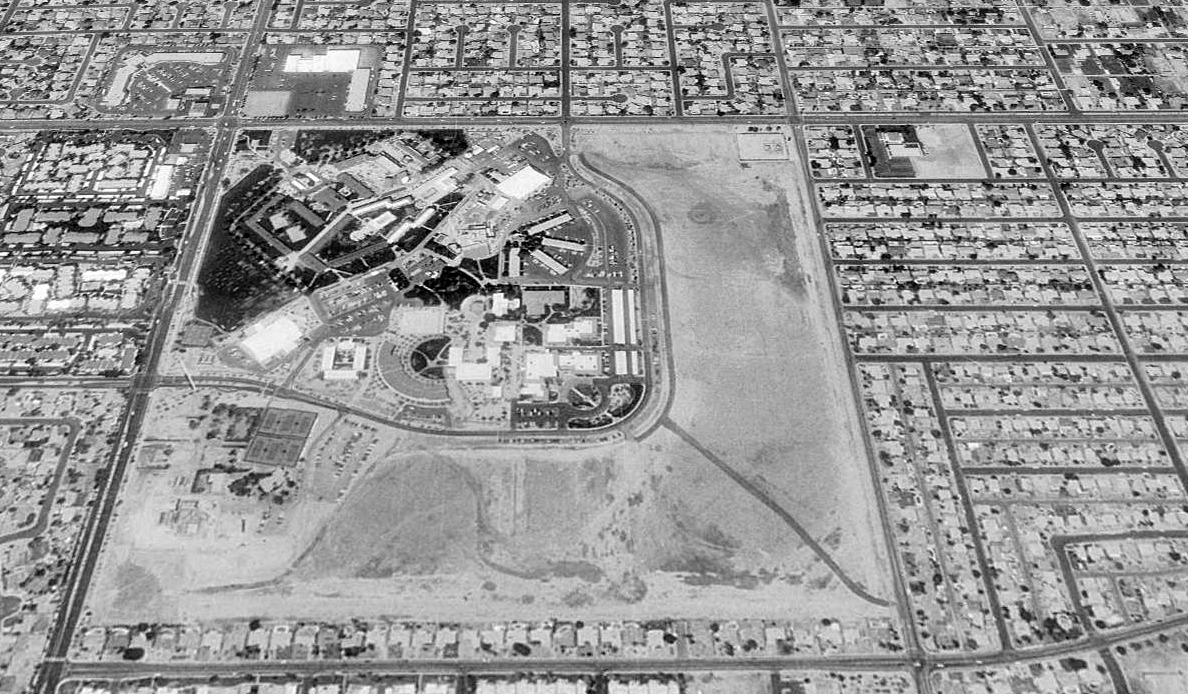
A 1997 USGS aerial view looking north depicted the Thunderbird hangars remaining intact.
The area of the 3 runways on the north side of the road had been densely redeveloped with housing.

A circa 2000s aerial view looking southeast at the former Thunderbird airfield buildings,
which are now reused as the Thunderbird Graduate School.
Today, the former Thunderbird Field is still the location of the school,
known currently as Thunderbird, The American Graduate School of International Management.
The campus still contains many original airfield buildings,
including the airfield control tower, barracks & 2 large airplane hangars.
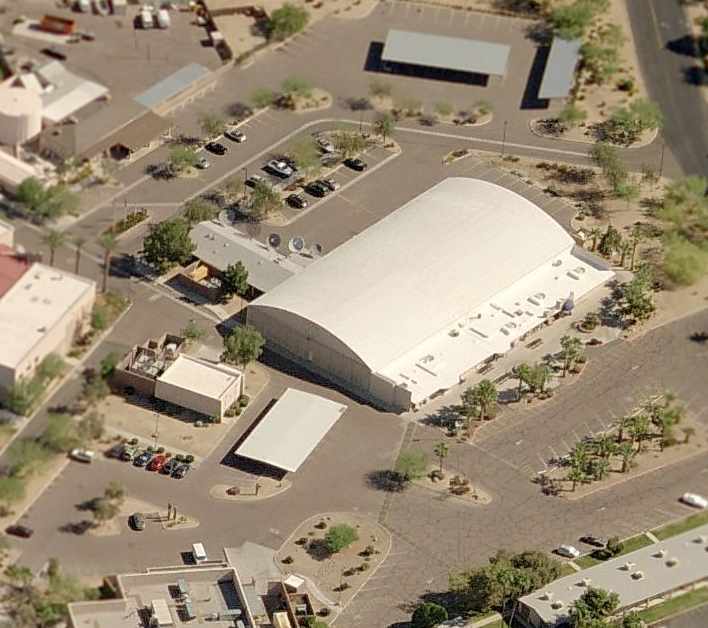
A circa 2006 aerial view looking north at the northeast former hangar,
one of 2 which remains standing.
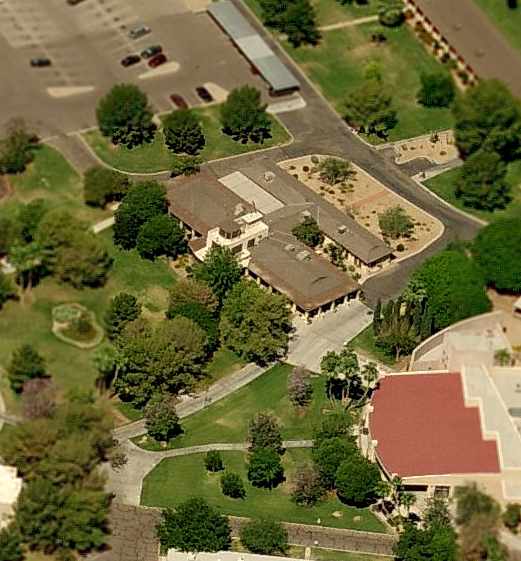
A circa 2006 aerial view looking west at Thunderbird's former control tower building.
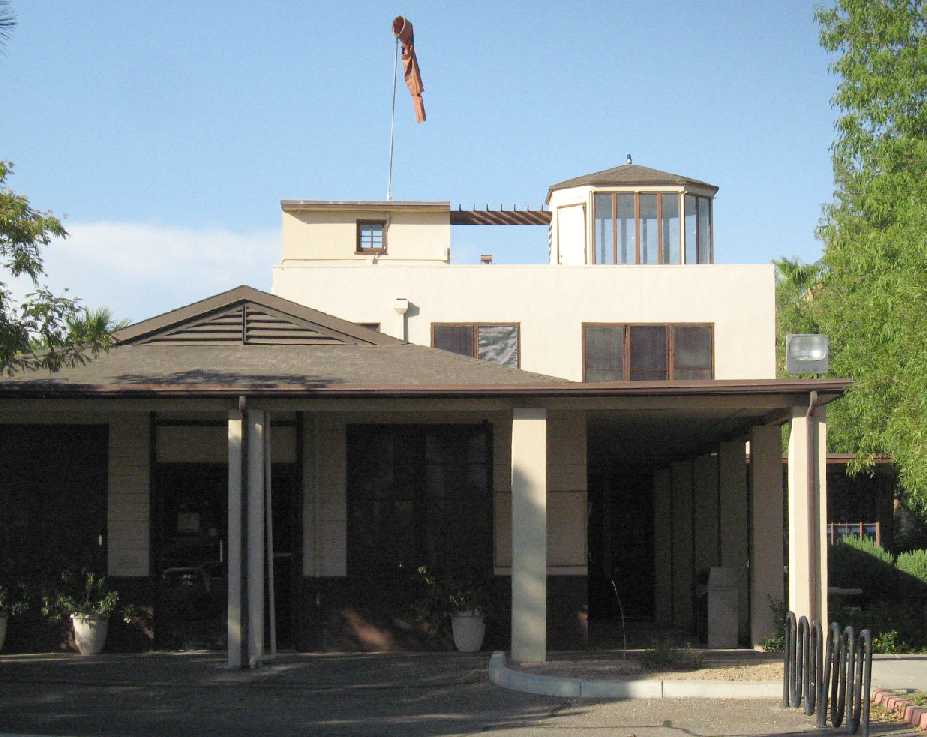
A 2007 photo by Steve Owen of the former Thunderbird control tower building, which still sports a windsock on top.
Steve noted, “The old barracks were still in use for office space, and the old tower structure remains.”
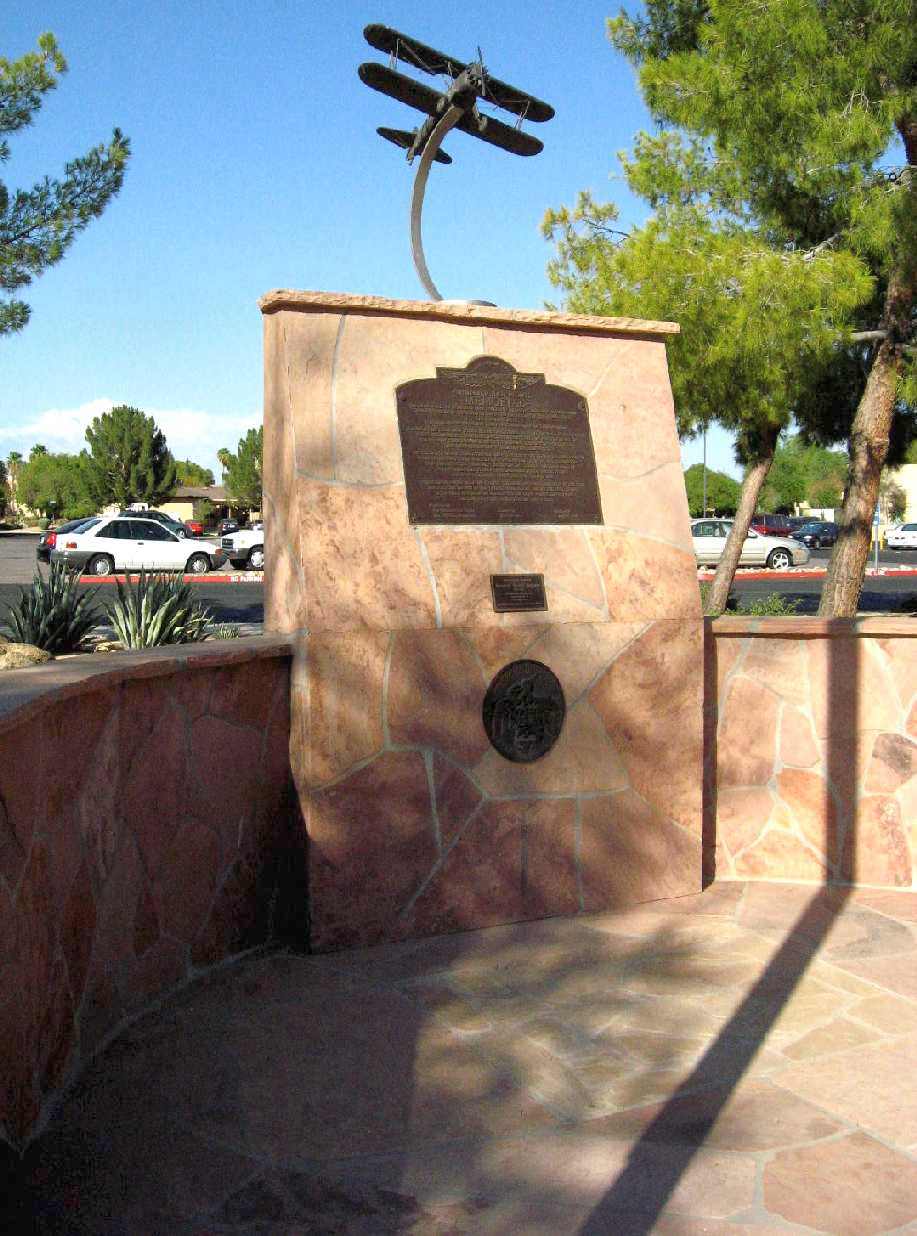
A 2007 photo by Steve Owen of “A nice monument to the aviators east of the western hangar structure, with its large T-Bird symbol.”
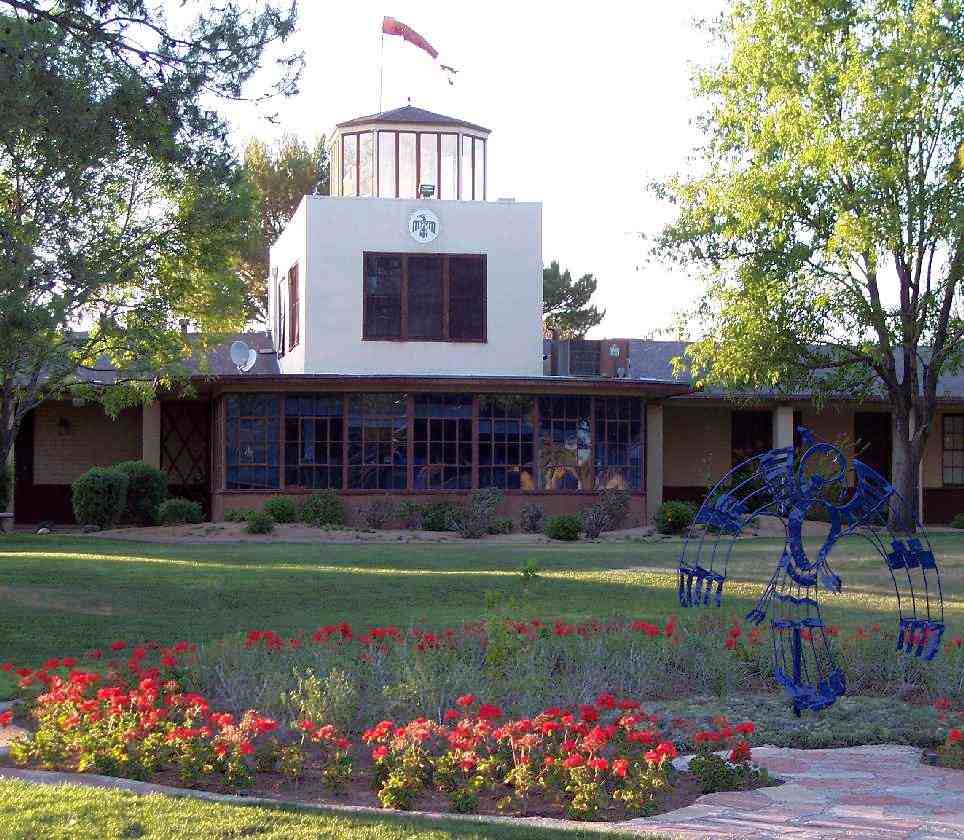
A 4/2/09 photo of the original Thunderbird Field control tower building.
The former tower building currently houses student government offices, a student lounge, and the Tower Cafe.

A 2021 aerial view looking north at the site of Thunderbird Field showed the 2 former hangars remained standing.
The site of Thunderbird Field is located southeast of the intersection of West Greenway Road & North 59th Avenue.
____________________________________________________
Thunderbird #1 Auxiliary Airfield A-1, Sun City, AZ
33.64, -112.1 (Northwest of Phoenix, AZ)
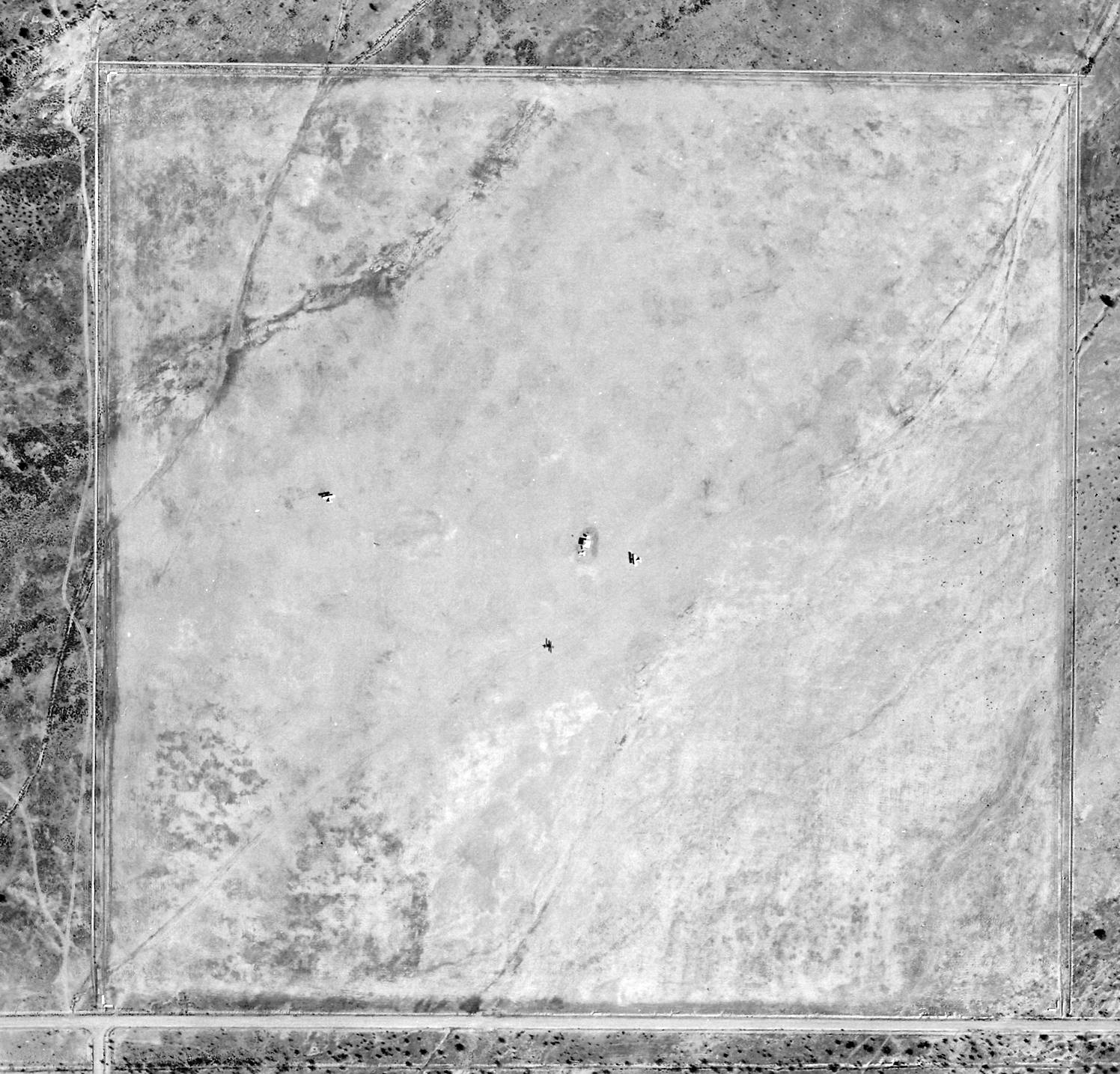
A 3/2/43 USAAF aerial view (from the National Archives, via Brian Rehwinkel).
This airfield was originally one of at least 4 satellite airfields used during WW2 by the cadets from Thunderbird Field.
Thunderbird Airport #1 Auxiliary #1 was not depicted at all on Phoenix Sectional Charts from 1941/42/43/44/45.
The earliest depiction which has been located of Thunderbird #1 Auxiliary Airfield #1 was a 3/2/43 USAAF aerial view (from the National Archives, via Brian Rehwinkel).
It depicted Thunderbird #1 Auxiliary Airfield #1 as consisting of an unpaved square landing area, with possibly a small shack or tent in the center.
Brian Rehwinkel noted, “You can see a couple of aircraft (presumably Boeing PT-17 Stearman) on the field.”
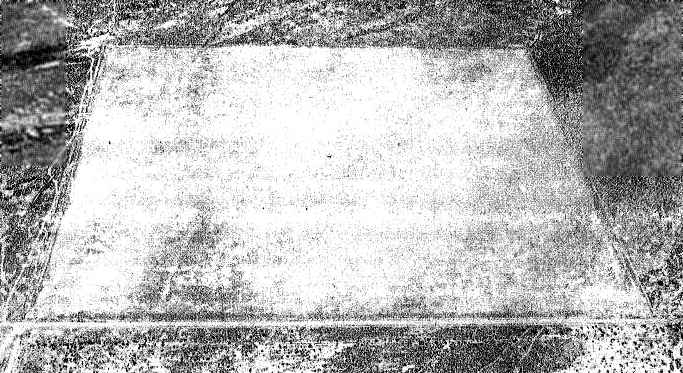
A 1943 aerial view looking north at Thunderbird #1 Auxiliary Airfield #1,
from the 1945 Army Air Forces Directory of Airfields (courtesy of Chris Kennedy).
It depicted Thunderbird #1 Auxiliary Airfield #1 as consisting of an unpaved square landing area.

The location of of Thunderbird Field Aux Field #1 relative to its parent airfield, as depicted on a WW2-era document (from the Air Force Historical Research Agency, via Brian Rehwinkel).
The 1945 AAF Airfield Directory (courtesy of Scott Murdock) described Thunderbird Airport #1 Auxiliary #1
as a 160 acre square property within which was a 2,640' square “sod” all-way field.
The field was described as not having any hangars, and to be privately owned & operated.

The last aeronautical chart depiction which has been located of Thunderbird #1 Auxiliary Airfield #1
was on the 1948 USAF Phoenix Urban Area Chart (courtesy of Scott O'Donnell).
It depicted a square outline, labeled “AF Aux Landing Area”.
Thunderbird #1 Aux A-1 was presumably abandoned at some point after 1948, as it was not depicted on subsequent aeronautical charts.
A 3/27/49 aerial view (from the Maricopa County Flood Control District) did not depict any specific trace of Thunderbird #1 Aux A-1, just a square plot of land.
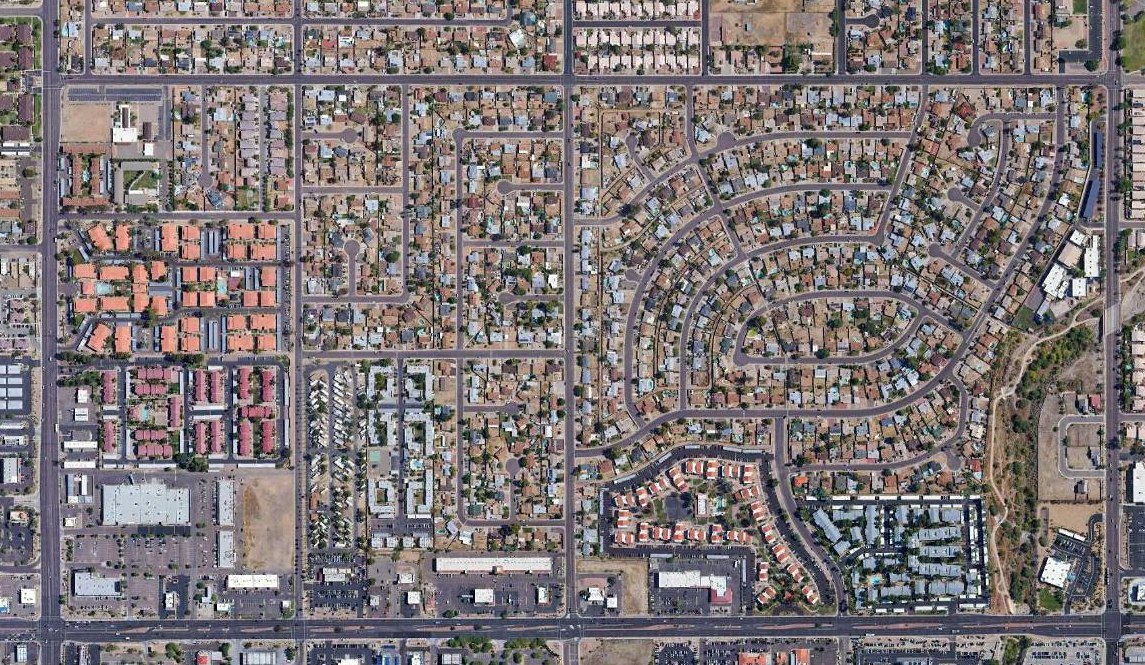
A 2019 aerial view showed no trace remaining of Thunderbird #1 Auxiliary Airfield #1.
Note: Another airfield, for the Turf Paradise Racetrack, was later built on the opposite (south) side of West Bell Road.
The site of Thunderbird #1 Auxiliary Airfield #1 is located northeast of the intersection of West Bell Road & North 19th Avenue.
____________________________________________________
Thunderbird #1 Auxiliary Airfield A-2, Sun City, AZ
33.65, -112.24 (Northwest of Phoenix, AZ)
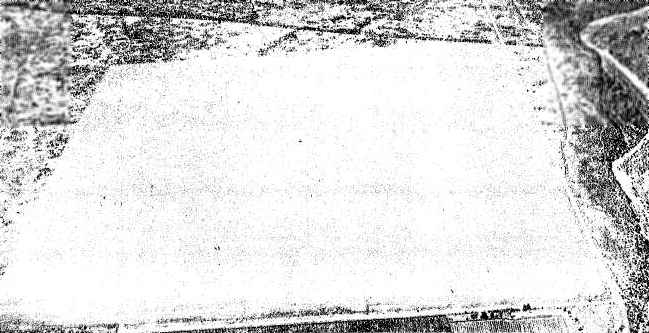
A 1943 aerial view looking north at Thunderbird #1 Auxiliary Airfield #2,
from the 1945 Army Air Forces Directory of Airfields (courtesy of Chris Kennedy).
This airfield was originally one of at least 4 satellite airfields used during WW2 by the cadets from Thunderbird Field.
Thunderbird Airport #1 Auxiliary #2 was not depicted at all on Phoenix Sectional Charts from 1941/42/43/44/45.
The earliest depiction which has been located of Thunderbird #1 Auxiliary Airfield #2
was a 1943 aerial view from the 1945 Army Air Forces Directory of Airfields (courtesy of Chris Kennedy).
The aerial view depicted the airfield as consisting of an unpaved square landing area.
The 1945 AAF Airfield Directory (courtesy of Scott Murdock) described Thunderbird Airport #1 Auxiliary #2
as a 240 acre square property within which was a 3,423' square “sod” all-way field.
The field was described as not having any hangars, and to be privately owned & operated.
Thunderbird #1 Auxiliary Airfield #2 was evidently never reused as an airfield after WW2,
as it was not depicted on the 1948 USAF Phoenix Urban Area Chart (courtesy of Scott O'Donnell)
nor on subsequent aeronautical charts.
A 2/14/49 aerial view (from the Maricopa County Flood Control District)
did not depict any specific trace of an airfield, just a square plot of land.

A 2019 aerial view looking north showed the site of Thunderbird #1 Auxiliary Airfield #2 had been redeveloped with housing & the Westbrook Villa Vistas golf course, with no trace of the airfield remaining.
The site of Thunderbird #1 Auxiliary Airfield #2 is located northwest of the intersection of West Union Hills Drive & North 83rd Avenue.
____________________________________________________
Pylant Airport / Southwest Airways Airfield / Thunderbird #1 Auxiliary Airfield A-3 / Paradise Airport, Sunnyslope, AZ
33.58, -112.1 (Northwest of Phoenix, AZ)
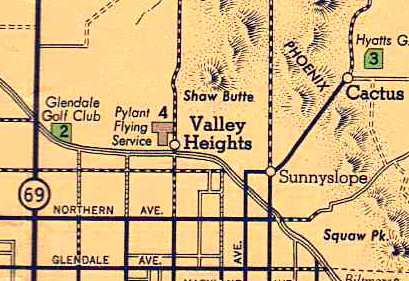
“Pylant Flying Service” Airport, as depicted on a 1940 HM Gousha Company map (courtesy of Curtis Carroll).
According to Curtis Carroll, “Earl Pylant was an Arizona native & aviation pioneer.
He had his pilot’s license by the time he was 17.
By the late 1930s, he started the Pylant Flying School near his hometown of Glendale.”
The earliest depiction which has been located of Pylant Airport was a 1940 HM Gousha Company map (courtesy of Curtis Carroll).
It depicted the “Pylant Flying Service” Airport as being T-shaped, on the northeast side of Valley Heights.
A 10/10/40 newspaper article (courtesy of Curtis Carroll) described a fatal crash at Pylant Airport,
in which Manuel Gutierrez was killed after his small cabin monoplane caught some wires on its landing approach to Pylant Airport.
No airfield was depicted at this location on the September 1941 Phoenix Sectional Chart (courtesy of Chris Kennedy).

Plyant Airport was depicted as “Southwest Airways” on the September 1942 Phoenix Sectional Chart.
According to Curtis Carroll, “Pylant enlisted in the Army Air Corps on 10/21/42.
It’s possible he turned over the operation of the field at that time to the Army
and continued as a flight instructor with the understanding it would resume as a private airfield after the end of the war.”
Pylant Airport was used during WW2 as Thunderbird Auxiliary Field A3.
According to Ron Chavez's book “The Valley's Airports of the Past”,
“Thunderbird Auxiliary Field A3 [was] one of many auxiliary fields built in 1942 by Southwest Airways Inc., owner & operator of Thunderbird Field.”
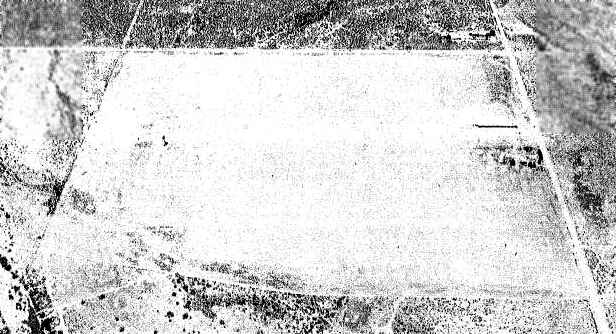
The earliest photo which has been located of Thunderbird #1 Auxiliary Airfield #3
was a 1943 aerial view looking north from the 1945 Army Air Forces Directory of Airfields (courtesy of Chris Kennedy).
The aerial view depicted the airfield as consisting of an unpaved square landing area,
with what may have been some buildings on the east side of the field.
The 1945 AAF Airfield Directory (courtesy of Scott Murdock) described Thunderbird Airport #1 Auxiliary #3
as a 160 acre square property within which was a 2,640' square “sod” all-way field.
The field was described as not having any hangars, and to be privately owned & operated.
According to Ron Chavez's book “The Valley's Airports of the Past”,
“In 1945, with the end of Word War II in sight, Southwest Airways began scaling down the flight operations at both Thunderbird Airfields.
It was decided these surplus auxiliary airfield properties were no longer of any use
and began selling them off for use as private-use airports.
In 1945, E. Pylant, a pilot, purchased this airfield property with the intention of starting a flying school.
After completing the purchase agreement, Pylant began renovating the military airfield.
He had 2 hangars & a terminal building constructed & had a new northeast/southwest runway carved out over the rutted existing runways.”
“Southwest Airways #3” was depicted as an auxiliary airfield on the September 1945 Phoenix Sectional Chart.
According to Curtis Carroll, “Once the military need ended, Pylant changed the proper name of the facility to Paradise Aviation Co., Inc. and the name of field to Paradise Airport.
He took the name from the expansive area known as Paradise Valley that spreads from north of the Phoenix mountains to Cave Creek & Carefree.”
“Plyant” was depicted as an auxiliary airfield on the March 1946 Phoenix Sectional Chart.
“Paradise” was depicted as an auxiliary airfield on the August 1946 Phoenix Sectional Chart.

The 1947 Gila River World Aeronautical Chart depicted Paradise Airport as having a 3,200' unpaved runway.

Paradise Airport was depicted on the 1948 USAF Phoenix Urban Area Chart (courtesy of Scott O'Donnell),
but strangely it did not depict any runway configuration.
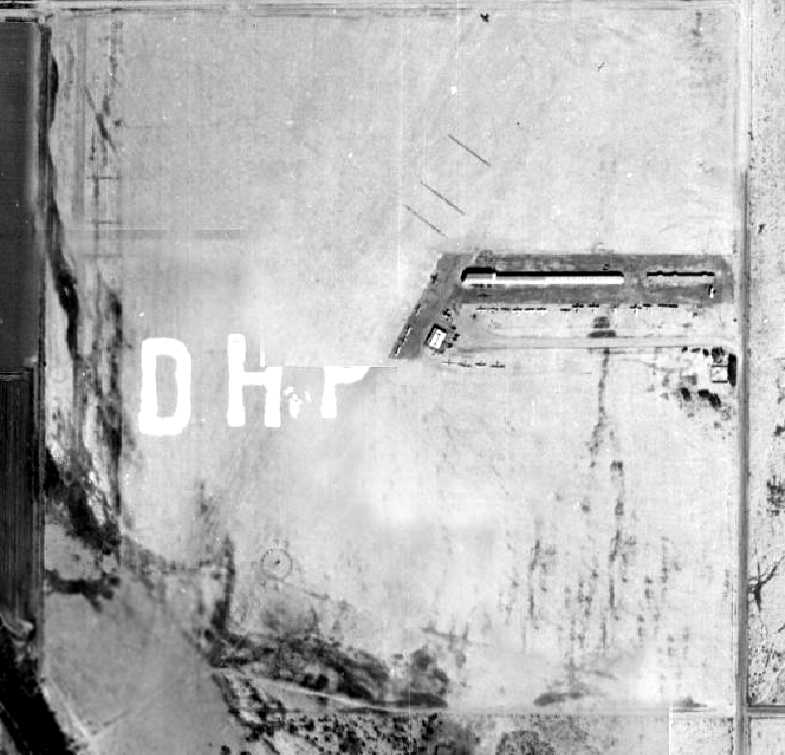
The earliest photo which has been located of Paradise Airport during its use as a civilian airport
was a 2/14/49 aerial view (from the Maricopa County Flood Control District).
It depicted the field as consisting of a largely square dirt field, with 3 hangars on the east side of the field.

A closeup from the 2/14/49 aerial view (from the Maricopa County Flood Control District)
showing a total of 2-dozen single-engine aircraft around the hangars of Paradise airport, the longest of which was painted with “Paradise” on its roof.
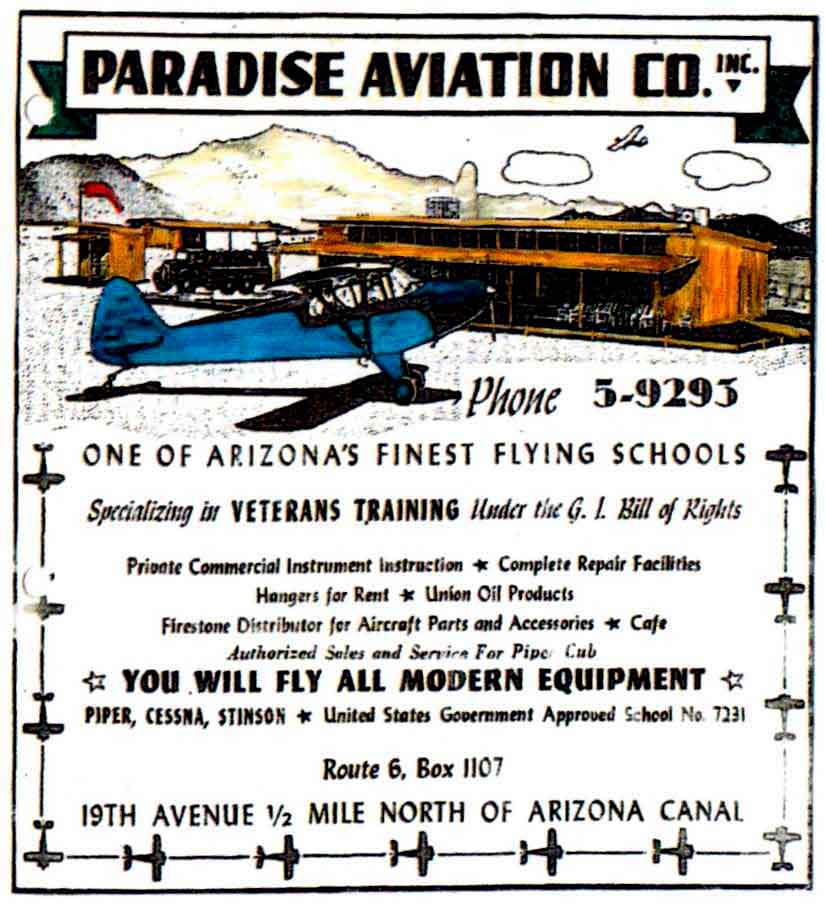
A circa late 1940s - early 1950s advertisement for Paradise Aviation Company (from Ron Chavez's book “The Valley's Airports of the Past”)
described the company as “One Arizona's finest flying schools”.

Two circa 1950s photos by Richard Bertram of an AT-6 & a Cessna at Paradise Airport (courtesy of Bob Bertram).

A circa 1950s photo of 2 Piper Cubs in front of a building at Paradise Airport (enhanced by Bill Grasha).
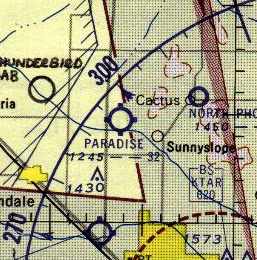
The Aerodrome table on the 1956 Phoenix Sectional chart (courtesy of John Voss).
described Paradise Airport as having a total of 4 runways, with the longest being 3,200'.

A 1958 photo by Brian Baker (enhanced by Bill Grasha) of one of Don Underwood's NAF N3N-3s, N44831, PW985 duster, with a B-25 Mitchell bomber in the background.
Brian recalled, “It was taken at Paradise Airport before Don moved his crop spraying business over to Deer Valley.
Don had some N3N's & Stearmans at Paradise, and also had a B-25 there for a while, but that all went to Deer Valley.”
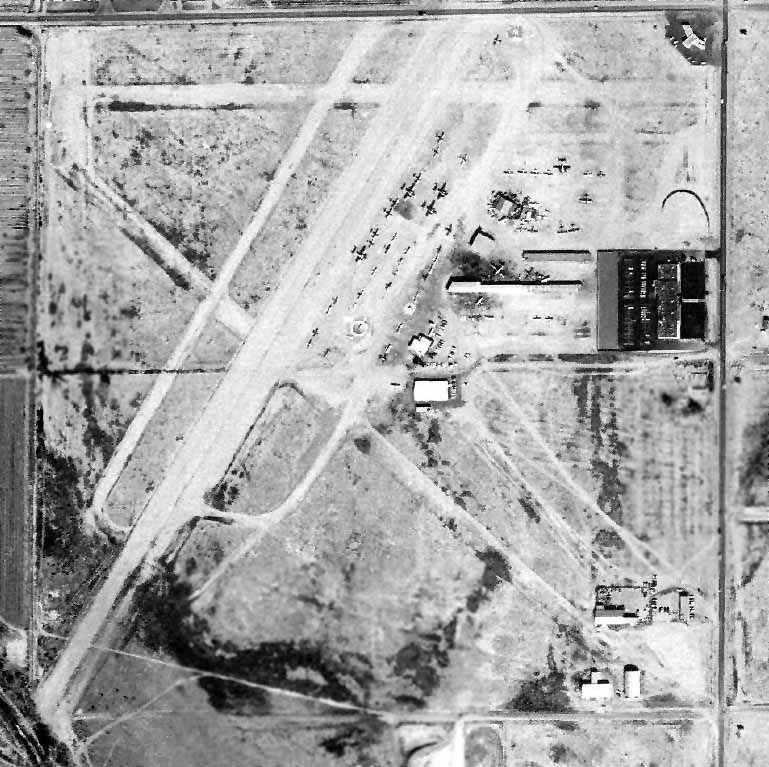
The last photo which has been located of Paradise Airport
was a 2/20/59 aerial view (from the Maricopa County Flood Control District, enhanced by Bill Grasha).
It showed that the field had been improved at some point between 1949-59 with 3 unpaved runways & several additional hangars.
The number of aircraft parked on the field had also increased compared to the 1949 photo,
including several relatively larger twin-engine aircraft.
According to Ron Chavez's book “The Valley's Airports of the Past”,
“The Paradise Airport began to wind down airport operations in 1959,
due to the increase in new development that was starting to appear along the airport property.
In 1959 [airport owner] Kilbourne decided to sell the property to a developer who had plans to turn the area into an industrial park for the AZ Public Service Company.
In 1960 with the sale of the property completed, Paradise Airport was closed down.”
A 1962 aerial view (from the Maricopa County Flood Control District) showed that the hangars had been removed
and several buildings had been built over the western & eastern portions of the field.
Paradise Airport was no longer depicted at all on the July 1965 Phoenix Sectional Chart (courtesy of Ron Kunse).
Traces of several runways were still recognizable in a 1969 aerial view (from the Maricopa County Flood Control District).
By the time of a 1979 aerial view (from the Maricopa County Flood Control District),
not a trace remained of the former Paradise Airport.
Two buildings which were visible in the 1959 aerial view appeared to still remain standing in a 2005 aerial view.
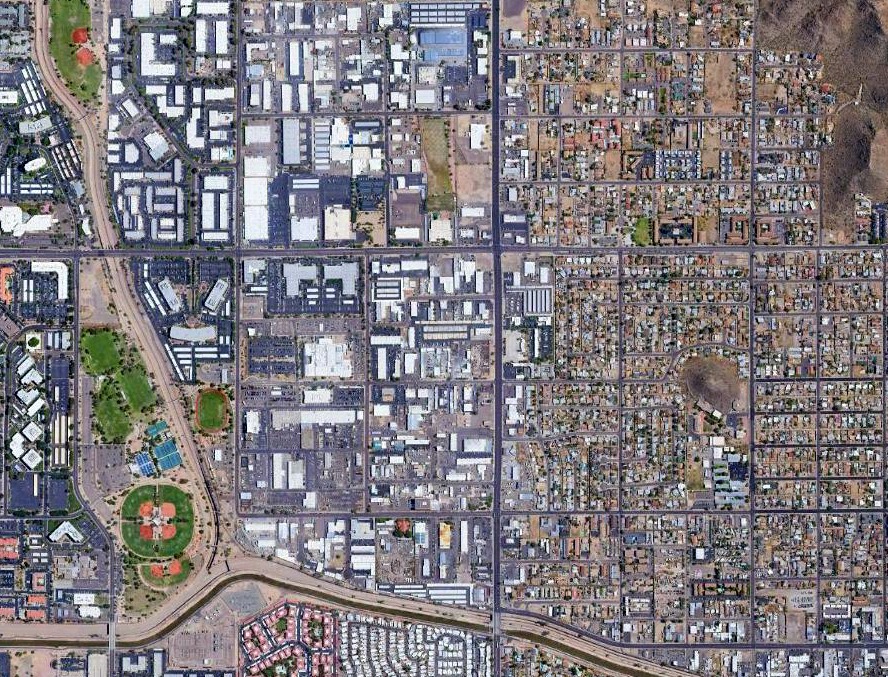
A 2019 aerial view showed no trace remaining of Paradise Airport.
The site of Paradise Airport is located at the intersection of West Peoria Avenue & North 19th Avenue, just south of Shaw Butte, and north of the Arizona Canal.
A later airfield, Turf Paradise Airfield, was located 4 miles to the north of Paradise Airport.
____________________________________________________
Sun City Airfield, Sun City, AZ
33.74, -112.26 (Northwest of Phoenix, AZ)
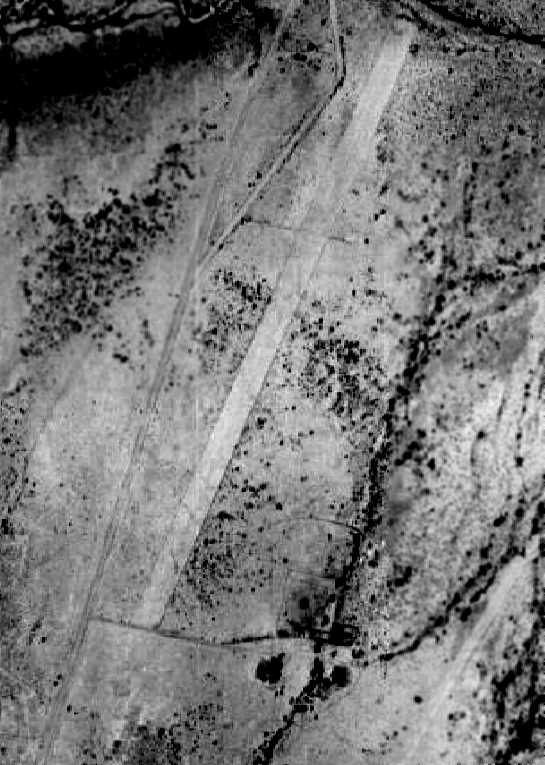
A 2/14/49 aerial view (from the Maricopa County Flood Control District) depicted the airfield as having a single unpaved northeast/southwest runway.
Photo of the airfield while in use has not been located.
This field may have been established during WW2 as a satellite airfield
used to support flight training operations at nearby Thunderbird Field.
The date of this airfield's construction has not been determined, nor any details of its use.
No airfield was depicted at this location on the March 1946 Phoenix Sectional Chart.
The earliest depiction of this field which has been located was a 2/14/49 aerial view (from the Maricopa County Flood Control District).
It depicted the airfield as having a single unpaved northeast/southwest runway,
along with a possible graded aircraft parking area on the southern side.
It is not known if the field was every reused for military or civil flying after the war, but it appears unlikely.
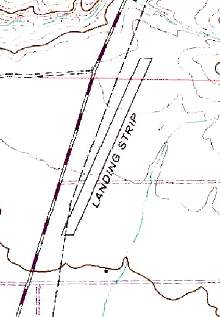
The 1981 USGS topo map labeled the "Landing Strip" as consisting of a single 2,800' runway,
running parallel along the east side of North Lake Pleasant Road.
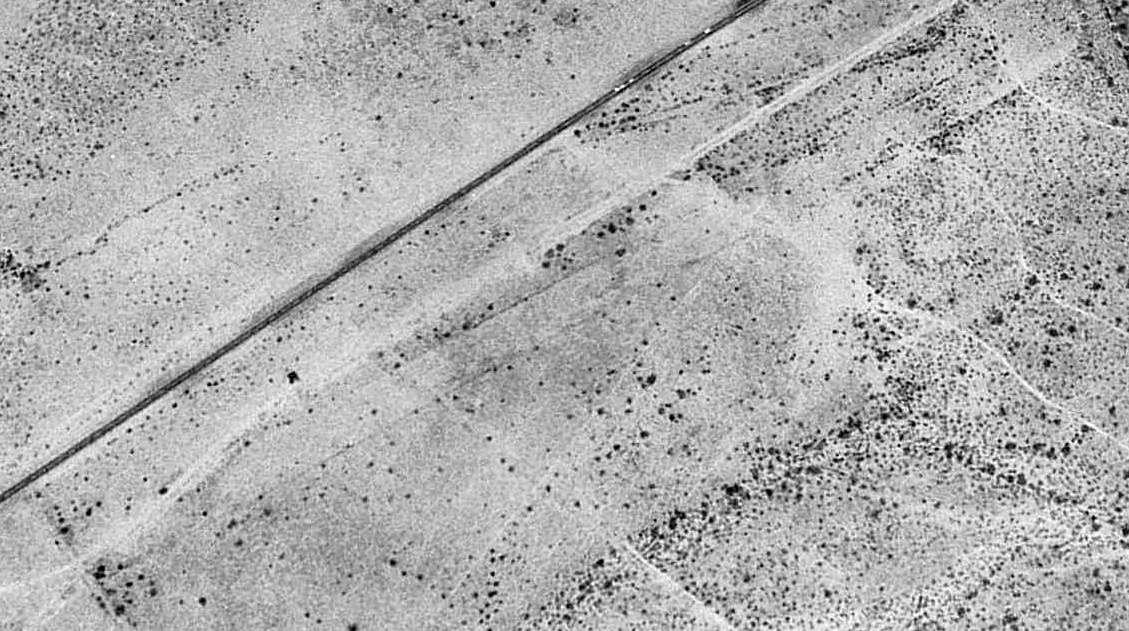
A 1997 USGS aerial view looking northwest showed the Sun City runway was still barely perceptible on the desert floor, if you know where to look.

A 2019 aerial view looking northwest showed houses had been built over the Sun City airfield site, with portions of the runway still barely recognizable at bottom-left & top-right.
The Sun City airfield is located northeast of the intersection of North Lake Pleasant Road & West Pinnacle Vista Road.
____________________________________________________
Turf Paradise Airfield, Phoenix, AZ
33.63, -112.09 (North of Downtown Phoenix, AZ)
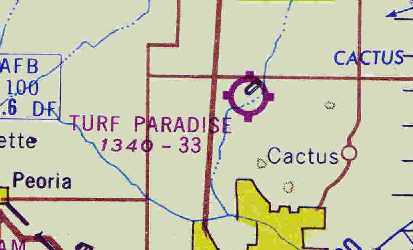
Turf Paradise Airfield, as depicted on the January 1964 Phoenix Sectional Chart (courtesy of Chris Kennedy).
This private airfield was located on the property of the Turf Paradise horse racetrack, which was built in 1954.
Turf Paradise Airfield was apparently built at some point between 1958-59,
as it was not yet depicted on a 1949 aerial photo nor on the March 1958 Phoenix Sectional chart (according to Chris Kennedy).
Duncan Woods recalled, “Turf Soaring School was originally located just south of Turf Paradise Race Track at Bell Road & 19th Avenue
back when the race track was about the only thing out there, back in the 1950s.
There was one northeast/southwest runway and a fair amount of glider activity.”

A 1958 aerial view of Turf Paradise (courtesy of John Arthur) appeared to show a single unpaved southwest/northeast runway
(or at least the beginnings of a cleared runway) on the southeast side of the racetrack.
The earliest dated reference which has been located of the usage of the Turf Paradise Airfield is from Jack Young, who recalled,
"Back in 1959 while getting qualified in taildraggers I used to fly an Aeronca Champ in & out of Turf Paradise.
I never saw another airplane there while I was using it."
The earliest aeronautical chart depiction of the Turf Paradise Airfield which has been located
was on the January 1964 Phoenix Sectional Chart (courtesy of Chris Kennedy).
It depicted the field as having a 3,300' unpaved runway.
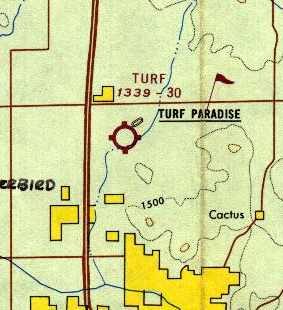
The 1966 Phoenix Local Aeronautical Chart (courtesy of John Voss) depicted Turf Paradise as having a 3,000' unpaved runway.
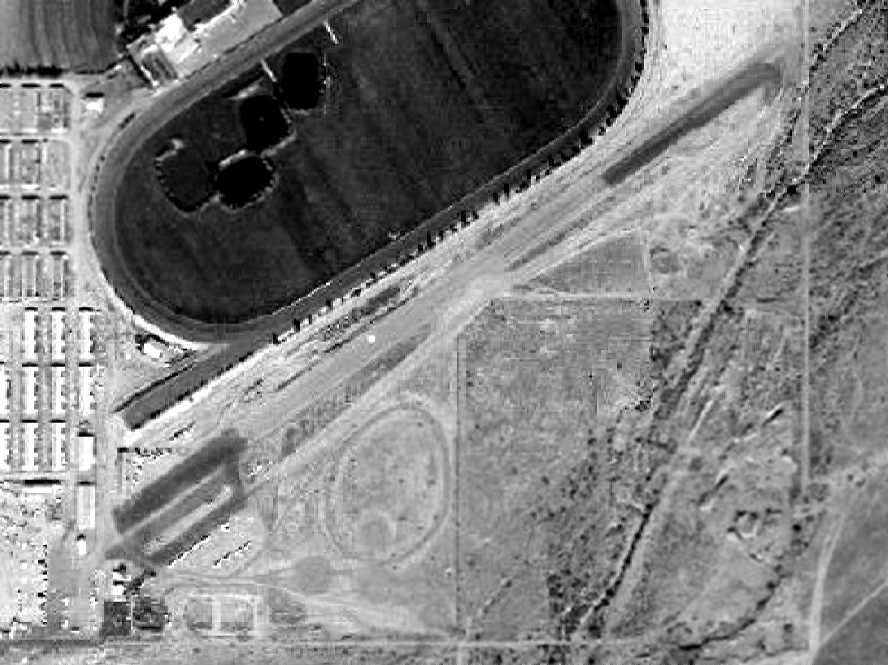
A January-March 1969 aerial view (from the Maricopa County Flood Control District) depicted Turf Paradise Airfield's single southwest/northeast runway on the southeast side of the racetrack,
along with at least 9 small general aviation aircraft parked at the southwest end of the field.
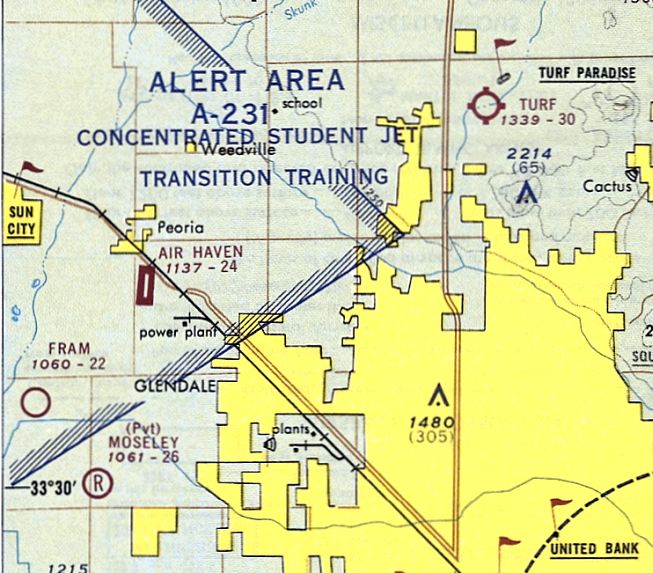
The January 1971 Phoenix Sectional Chart closeup portion (courtesy of Ron Plante)
depicted Turf Paradise Airfield as having a 3,000' unpaved runway.
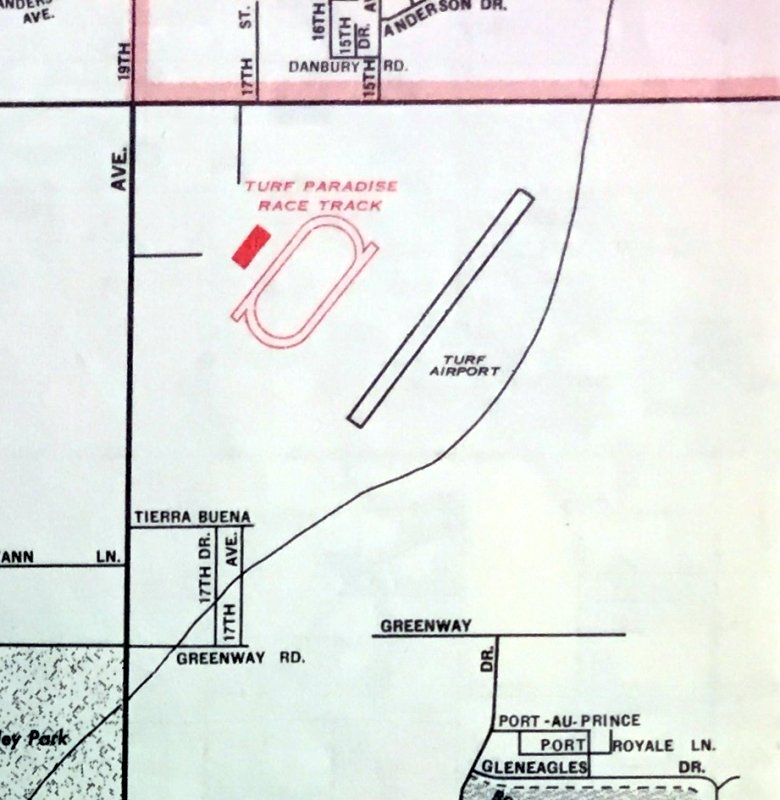
A 1975 street map (courtesy of Kevin Walsh) depicted “Turf Airport” as having a southwest/northeast runway.
John Moore recalled, “Back in the mid-1970s, I flew sailplanes, rented from Turf Soaring School, out of Turf Paradise Airfield. The strip at the time was gravel.
A nice thing about that airport was that you could soar over Phoenix & the mountains that within the city limits.
Also, there was very little air traffic there at the time. The airport also had personally-owned gliders.
The approach to the airport was interesting because there was almost always sink (downward moving air) on the final leg (towards the southwest), so you needed to be careful to make the field.
However, in a glider you go at maximum speed on final (at least, the little trainers I flew), just in case.
Gliders have the ability to rapidly lose speed & altitude, using spoilers plus extreme slip, and it was easy to land & then stop your glider a yard behind the last glider in the line waiting for a tow.”
George McNeil recalled, “I learned to fly at Turf Soaring School in the 1970s.
Turf Soaring School moved from Turf Paradise Airport sometime in 1976 because it had been rumored & then announced that the field would be closing.
The school owner Roy Coulliette built a new airport which became Pleasant Valley Airport.”
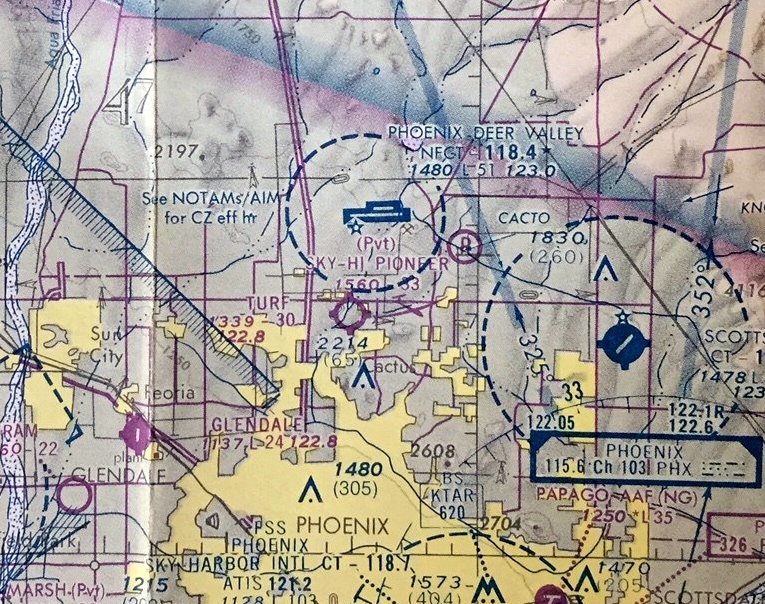
The last aeronautical chart depiction of the Turf Paradise Airfield which has been located was on the June 1977 Phoenix Sectional Chart (courtesy of Kevin Walsh).
It depicted Turf Paradise as having a 3,000' unpaved runway.
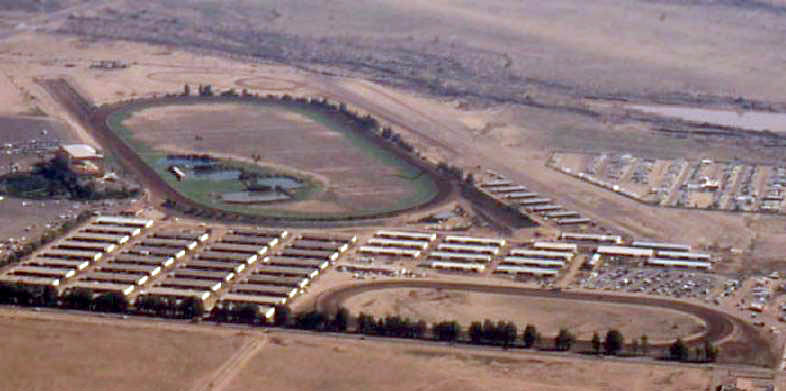
A 1978 aerial view of Turf Paradise, looking east, by Chris Kennedy.
The runway was still visible just to the right of the large racetrack, but it is not known if the airfield was still open by that point.
The Turf Paradise Airfield was evidently closed at some point between 1977-78,
as it was no longer depicted on the 1978 Phoenix Sectional Chart (courtesy of Jonathan Westerling).
A 12/15/79 aerial view (from the Maricopa County Flood Control District) showed that with no trace of Turf Paradise Airfield remained,
with the runway having been covered by several new buildings.
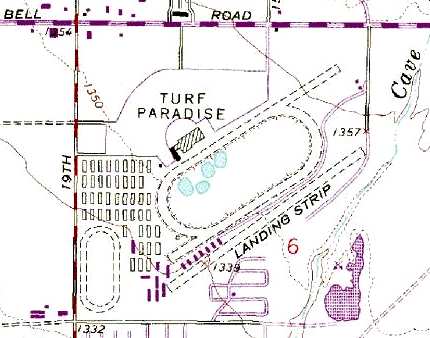
The 1982 USGS topo map continued to depict the "Landing Field" as having a single 3,000' runway,
even though it had already ceased to exist for at least 3 years.
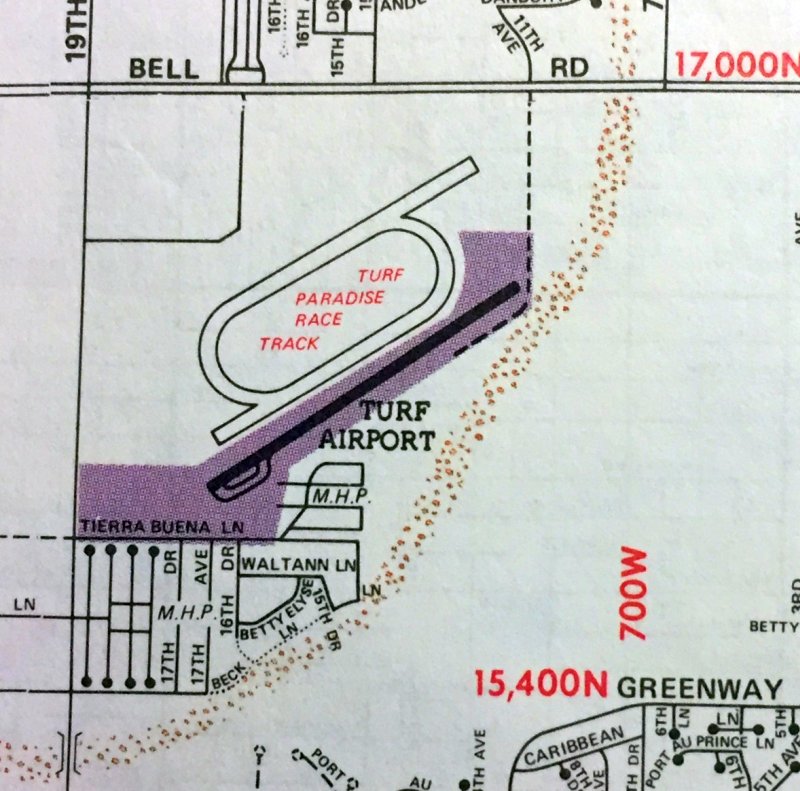
A 1983 street map (courtesy of Kevin Walsh) continued to depict “Turf Airport” as having a southwest/northeast runway.
The Turf Paradise runway continued to be depicted on the 1988 USGS topo map, even though it had been built-over for at least 9 years by that point.
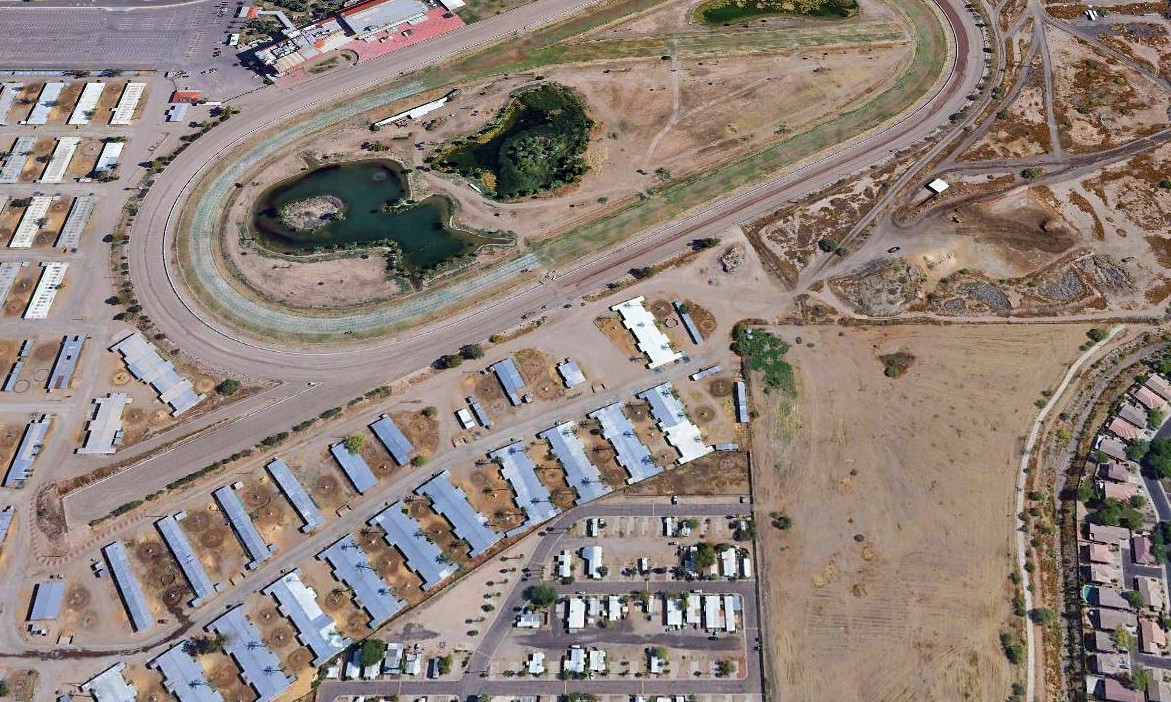
A 2019 aerial view looking north showed no trace remained discernible of Turf Paradise Airfield.
The Turf Paradise Race Course is located southeast of the intersection of Bell Road & North 19th Avenue.
An earlier airfield, Paradise Airport, was located 4 miles to the south of Turf Paradise Airfield.
____________________________________________________
33.53, -112.28 (Northwest of Phoenix, AZ)
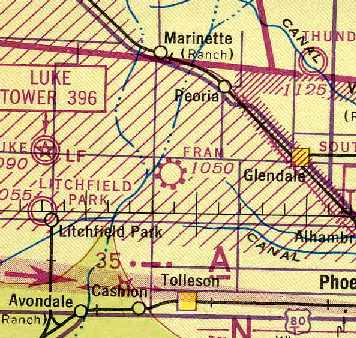
Fram Field, as depicted on the September 1941 Phoenix Sectional Chart (courtesy of Chris Kennedy).
According to Donalyn Fram Easterday, his grandfather Ray Fram "known as Pops to us, was a special person.
Ray fell in love with flying as a doughboy in France fighting in the trenches.
So after the War [WW1] he returned, married & started learning to fly.
His instructor was Bill Landon & he learned in an Eagle Rock, American Eagle, old engine OX5, water cooled.
He really liked his instructor. His instructor did not carry a club as some did in those days.
The instructor, Bill, was in the front seat & a student in the back.
The student froze holding the stick back keeping the plane in a spin.
If he had had a bat, he could have turned & knocked the student out. So those 2 spun in."
Donalyn continued, "Ray went to South Central Airport, [where] Goldtrap & Lee had a flying service.
They had 3 Monopreps (2-place) & one Monocoup (faster than the Monoprep).
He flew with them & bought one NC111K built in 1928. It had the name painted on it, 'The Spirit of the Depression'.
The inspector did not like it & said paint it out, so he did."
Donalyn continued, "It was a fabric plane, so friends came & moved the chicken pens together to shade the plane.
With Ray's $600 bonus from the War, he hired a Mexican contractor.
Times were tough; labor was 15 cents / hour. Adobe bricks were $25 / 1,000.
Part went to make their house & part of the brick made the hangar.
Ray became a popular instructor pilot on weekends as he had to farm during the week.
Dad said Fram Field was busier on weekends than Sky Harbor was."
Donalyn continued, "Ray's daughter Kay got her pilot's license at 16, and my son, my Dad, would fly to football practice at Peoria
as he had to get the chores done & they only owned a milk truck."
Ray also bought a Portierfield Zepher, a 3570 Portierfield #16498, and a 384H Fairchild KR-34.
Fram Field was not yet depicted on the January 1941 Phoenix Sectional Chart.
The earliest depiction of Fram Field which has been located
was on the September 1941 Phoenix Sectional Chart (courtesy of Chris Kennedy).

Fram Field was still depicted on the February 1943 Phoenix Sectional Chart (courtesy of Chris Kennedy).
Donalyn Fram Easterday said "The government closed the airport during WWII & locked the planes in the hangar.”
Fram Field was not depicted on the March 1945 Phoenix Sectional Chart (courtesy of Ron Plante).
Donalyn Fram Easterday recalled, “After the war [WW2] Ray resumed instructing.”
A directory of AZ Airports in the 5/47 issue of Arizona Highways (courtesy of George Miller),
described Fram Field as having a 2,100' runway.
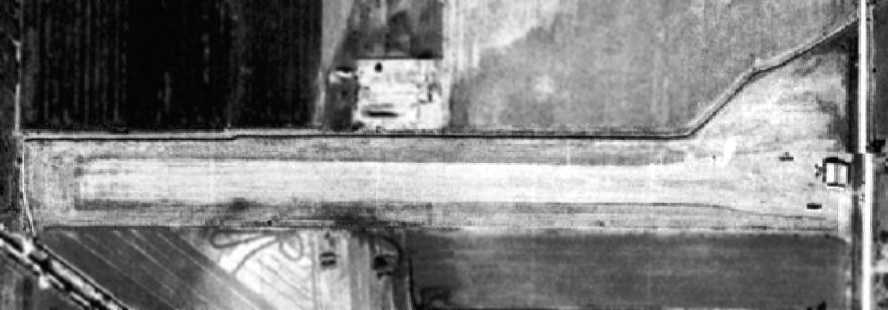
The earliest photo which has been located of Fram Field was a 2/14/49 aerial view (from the Maricopa County Flood Control District).
It depicted the field as having a single unpaved east/west runway, with a small hangar & 2 small aircraft on the east side of the field.
Brenda Shears recalled, “I am Max Shears' daughter. My father ran his crop dusting business [at Fram Field].
Three of my brothers became cropdusters. I hung around the airport a lot when I was young in the 1950s.”
An article entitled “Duster Heaven” by Harry Gann (courtesy of Brian Baker) in a circa 1957-58 AAHS Journal
said “On 99th Avenue & Glendale Avenue is Fram Field.
Max Shears & Bill Mason have a collection of airplanes that would whet the appetite of any aviation enthusiast.
The December 1957 issue of American Airman had an interesting article about the field.
I have photographed the following Standards there: Jones New Standard D-25 duster, N19155, Wright R-975-11.
New Standard D-25 sprayer, N9194, Lycoming R-690-9. New Standard D-25 duster, N31K, Wright R-975-11.”
Dave Stevenson recalled, “Fram Field... Max Shears was a well-known cropduster.
He had an old adobe hangar, and 5 New Standard D-25s.”

The earliest ground-level photo which has been located of Fram Field was a circa 1950s photo by Brian Baker of a New Standard biplane, with an unusually large exhaust stack.
Brian recalled, “It was parked on the south side of the strip. I only saw 2 of them there, although Gann lists another.”
The number of aircraft visible on Fram Field increased to 8 in a 2/20/59 aerial view (from the Maricopa County Flood Control District).

A circa 1961-64 photo by Jim Lindsay of the BC-12D Taylorcraft, N96020 he co-owned with Donald Lester, at Fram Field, with 2 of Max Shear's cropdusters in the background (courtesy of Fred Lester).
Fred recalled, “Dad parked it at Fram Field. The far cropduster is N19155. My dad learned to fly in 1960. His instructor was Max Shears.
I have more memories of the things in the hangar: an engine laying around the hangar, with crates of new engines, government surplus.
He would change out an engine & put another one in. I know of only 3 planes; one was in the hangar rafters.”
In the 1962 AOPA Airport Directory, the operator of Fram Field was listed as M. B. Shears.
Donalyn Fram Easterday said "The man you have listed as running the airport either sold or gave away the planes.
None of the family was living in the Phoenix area at that time to keep tabs on what was happening."

A 1964 street map (courtesy of Kevin Waslh) depicted Fram Field as having a single east/west runway, with “Limited facilities”.
Michael Grantland recalled, "My grandfather, Richard Comfort,
lived on & operated this air field from the mid 1960s through the 1980s until it was closed down.
My Grandparents lived there for over 30 years while it was Fram Field Aviation.
My Grandfather said he leased the property from Mrs. Fram."
Daniel Gilsdorf recalled, “I spent many years growing up, following Dick Comfort at Fram Field in the late 1960s into the 1970s.
I want to say his wife's name was Trudy, and I think he had a son Wayne. She had a Stanley Steamer and an old J3 Cub stored in the back of the old hangar.
Max Shers' Sanders were parked down the runway to the west. Old Dick was a member of the Sheriff's airport.”
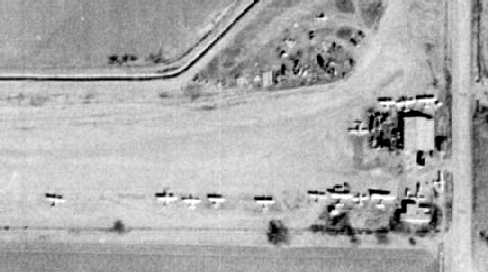
A closeup from a 1970 aerial view, showing Fram Field at its peak of popularity,
with a total of 15 single-engine aircraft parked around a few small buildings on the southeast side of the field.

The January 1971 Phoenix Sectional Chart closeup portion (courtesy of Ron Plante)
depicted Fram Field as having a 2,200' unpaved runway.
The December 1976 Phoenix Sectional Chart (courtesy of Chris Kennedy)
depicted Fram Field as having a 2,200' unpaved runway.

The 1977 Phoenix Sectional Chart close-up portion (courtesy of Ron Plante) depicted Fram Field as having a 2,200' unpaved runway.

The last photo which has been located of Fram Field was a 12/15/79 aerial view (from the Maricopa County Flood Control District).
A dozen small general aviation aircraft were visible parked at the southeast end of the field.
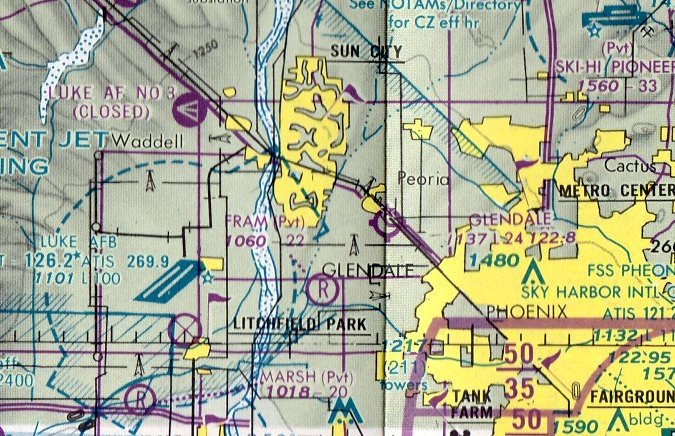
The last aeronautical chart depiction which has been located of Fram Field was on the June 1981 Phoenix Sectional Chart (courtesy of Paul Sibitzky).
It depicted Fram Field as a private airfield having a 2,200' unpaved runway.
In the 1982 AOPA Airport Directory (courtesy of Ed Drury), Fram Field was described as having a single 2,160' dirt Runway 8/26,
and the operator was listed as Fram Field Aviation.
The Notes said, "Private. Use at own risk. Field closed to all students. W end of field may be flooded."
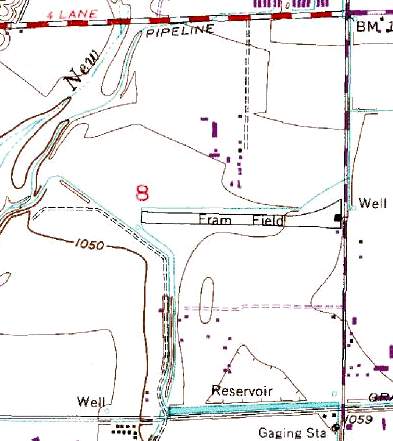
The 1982 USGS topo map depicted Fram Field as having a single 2,600' runway, oriented east/west.
According to Michael Grantland (grandson of Fram Field operator Richard Comfort), "It was closed down in 1984."
Fram Field was no longer depicted on the November 1985 Phoenix Sectional Chart (courtesy of John Voss).
Fram Field was still depicted on the 1988 USGS topo map, but was labeled simply "Landing Strip".

A 1992 USGS aerial view looking northwest showed Fram Field was still intact several years after it had been closed, including the runway & the hangar on the east side.
Fram Field was no longer depicted at all (even as an abandoned airfield) on the 1998 Sectional Chart.
Donalyn Fram Easterday said "Even though the field doesn't exist [anymore],
the property is still in the family & it was a part of aviation history in the area."
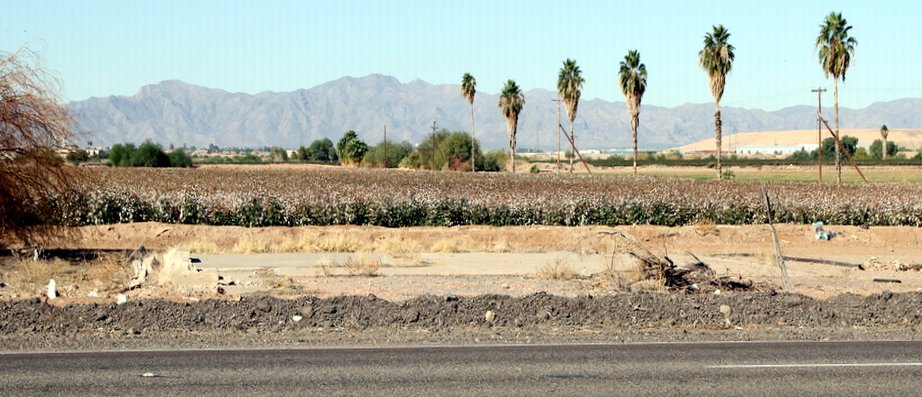
An 11/6/13 photo by Chris Kennedy looking west at what appears to be a Fram Field foundation, southwest of the intersection of 99th Avenue & Maryland Avenue.
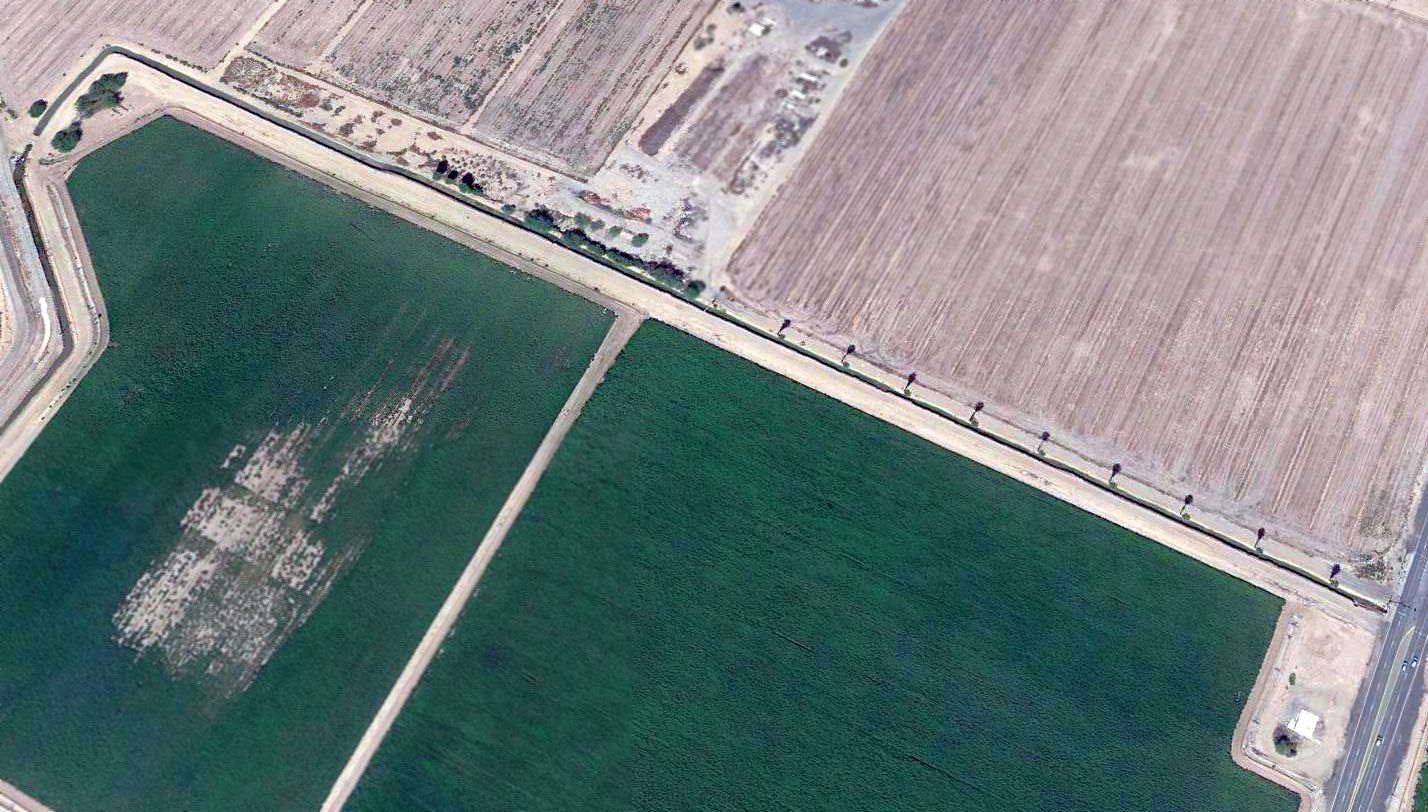
A 2016 aerial view looking northwest at the site of Fram Field shows no trace remaining of the runway, with the land having reverted to farming.
The last remaining trace of the little airfield is the foundation of the hangar on the east side (bottom-right).
The site of Fram Field is located northwest of the intersection of North 99th Avenue & West Rose Lane,
a half mile east of the present-day Glendale Municipal Airport.
____________________________________________________
Luke Satellite Field #3 / Luke Auxiliary Army Airfield #A1 / Luke Auxiliary Army Airfield #1 / Wittman Field, Glendale, AZ
33.72, -112.53 (Northwest of Luke AFB, AZ)

The earliest photo which has been located of Luke “Satellite Field #3” was an 8/29/42 USAAF aerial view (courtesy of Brian Rehwinkel).
This satellite airfield for Luke Army Airfield confusingly went through an early name resignation,
being first known as Luke Satellite Field #3, then as Luke Auxiliary Field #1.
Luke Satellite Field #3 was built during WW2 as one of a large number of satellite airfields for Luke AAF,
which was the largest single-engine advanced training base in the world during WW2.
According to the "History of Luke AFB" (obtained by David Brooks from the public affairs office at Luke AFB),
"The first [of Luke's auxiliary airfields], appropriately named Auxiliary Field #1, but also known as Wittman,
served as the training site for P-40 operations when Luke Field became too congested with aircraft.
Wittman Field was located 4.5 miles south of the Arizona town with the same name & was activated on 7/1/41."
The configuration of Wittman Field was described as "having 4 runways,
three being 300' wide & 4,000' long & built in an equilateral triangle configuration,
with a 300' x 3,600' landing strip bisecting the center.
The 4-runway configuration… cost $300,000 to construct.
Wittman Field facilities were limited to a control tower, crash truck shed & a generator shed. Wittman totaled 709 acres."
The earliest photo which has been located of “Luke Satellite Field #3”
was an 8/29/42 USAAF aerial view (courtesy of Brian Rehwinkel).
It depicted the field as having 4 paved runways, with a cluster of small buildings or tents to the northwest.
The east/west runway had the field elevation of “1531” painted in the middle, and the field designation “3” was painted inside a large circle on the eastern end.
By the time of a 12/2/42 USAAF aerial view (courtesy of Brian Rehwinkel), it was captioned as “Aux. Field #A1”.
The physical airfield configuration was unchanged, including the airfield designation of “3” inside a large circle on the eastern end.
Closed-runway “X” symbols were painted on the west & northeast runway ends.
Wittman Field was not yet depicted on the August 1943 Regional Aeronautical Chart (courtesy of Kevin Walsh).
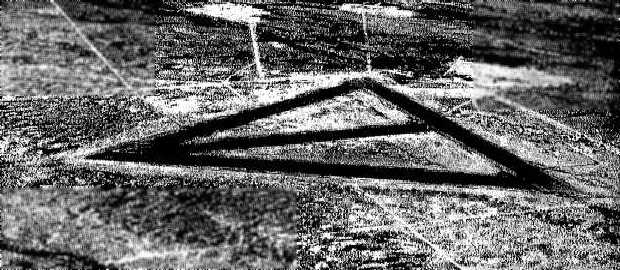
A 6/7/44 aerial view looking northeast from the 1945 AAF Airport Directory depicted Wittman as having 4 paved runways.

The earliest aeronautical chart depiction of the Wittman auxiliary field which has been located
was on the March 1945 Phoenix Sectional Chart (courtesy of Chris Kennedy).
It depicted Wittman "#1" as an auxiliary airfield.
The 1945 AAF Airfield Directory (courtesy of Scott Murdock) described Luke Field Auxiliary #1 (Wittman Field)”
as a 709 acre square property within which were 4 bituminous runways,
with the longest being the 4,000' northeast/southwest, WNW/ESE, and NNW/SSE strips.
The field was described as not having any hangars, and to be operated by the Army Air Force.
According to the "History of Luke AFB" (obtained by David Brooks from the public affairs office at Luke AFB),
"It remained a Luke Field asset through the base’s inactivation in 1946."

The 1947 Gila River World Aeronautical Chart depicted Luke AF #1 as having a 3,900' paved runway.
Luke Aux AAF #1 was listed in a directory of AZ Airports
in the 5/47 issue of Arizona Highways (courtesy of George Miller),
which described the field as being unattended, and the longest runway as being 4,000'.
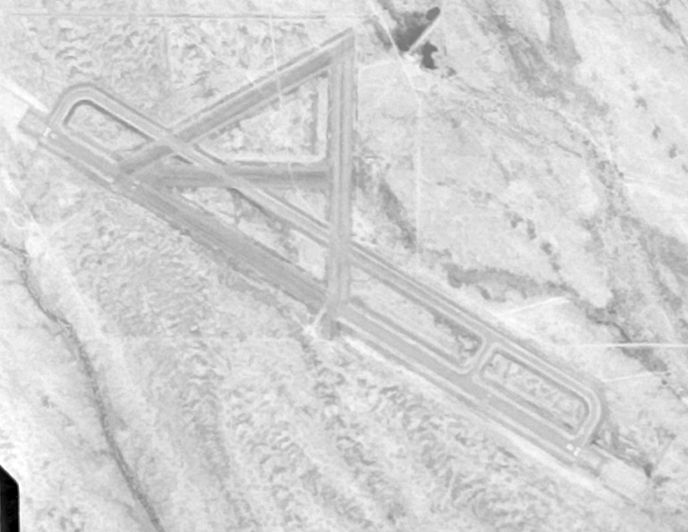
Luke Aux #1 evidently gained a much lengthened northwest/southeast runway at some point between 1947-53 (presumably to support jet aircraft),
as depicted on a 3/31/53 USGS aerial view.
"Luke AF #1" was still depicted as an active airfield on the 1956 Phoenix Sectional chart (courtesy of John Voss),
and described as having an 8,800' runway.
This airfield was apparently one of the last of Luke's many surrounding WW2-era satellite airfields to remain open.
Unlike most of the others, it was still depicted as an active airfield
on the 1966 Phoenix Local aeronautical chart (courtesy of John Voss).
The December 1976 Phoenix Sectional Chart (courtesy of Chris Kennedy)
depicted Luke AF #1as having 4 paved runways, with the longest being 7,800'.
The Volvo Arizona Proving Ground (automobile test track) was constructed adjacent to the southeast corner of the airfield, opening in 1985.
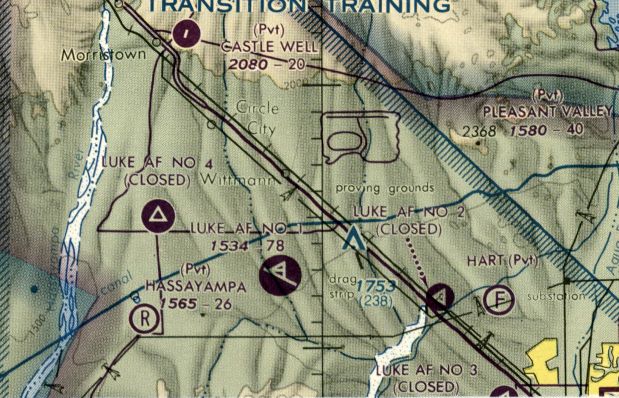
"Luke AF #1" was still depicted as an active airfield on the 1988 Phoenix Sectional Chart (courtesy of Jonathan Westerling).
It was depicted as having 4 paved runways, with the longest being 7,800'.
Luke Auxiliary #1 was evidently closed at some point between 1988-93,
as it was labeled “Closed” on the May 1993 Phoenix Sectional Chart (courtesy of Ron Plante).
Luke Auxiliary #1 had yellow Xs painted along the length of Runway 11/29 on a 1993 aerial view,
but it also appeared to have relatively-recent runway markings.
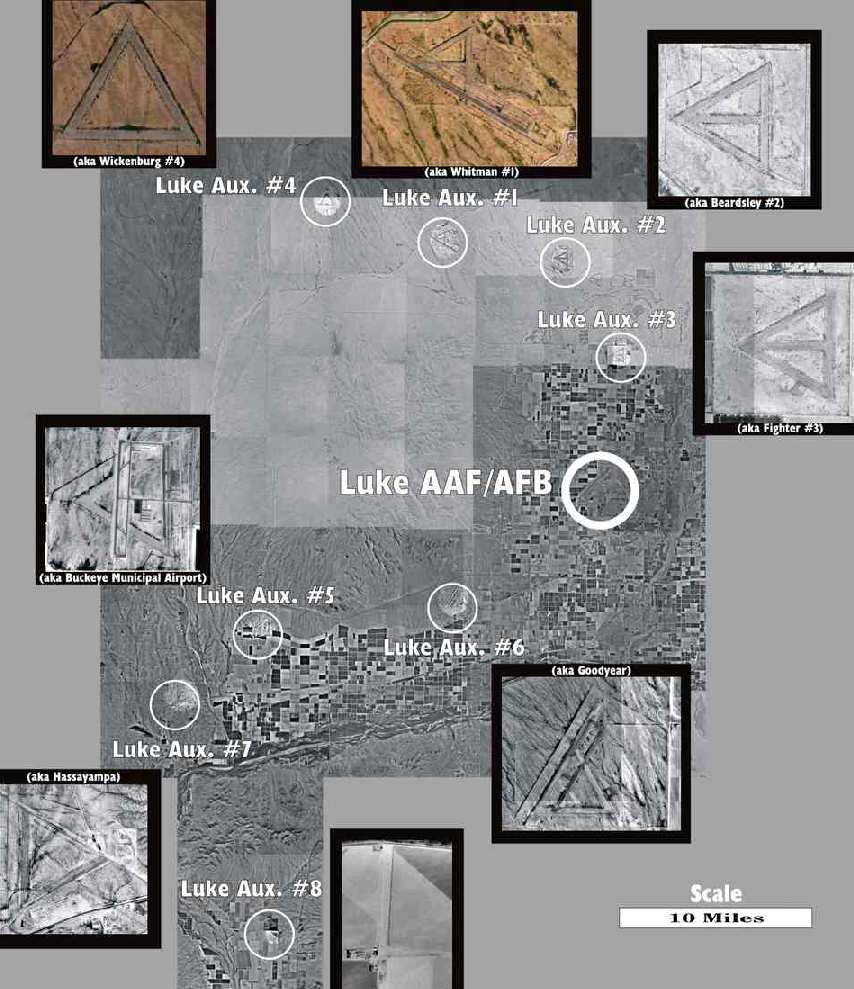
A remarkable composite picture, in which David Brooks has superimposed close-up views of the numerous former Luke auxiliary airfields over the 1996 USGS aerial photo,
showing their location relative to Luke AAF/AFB.
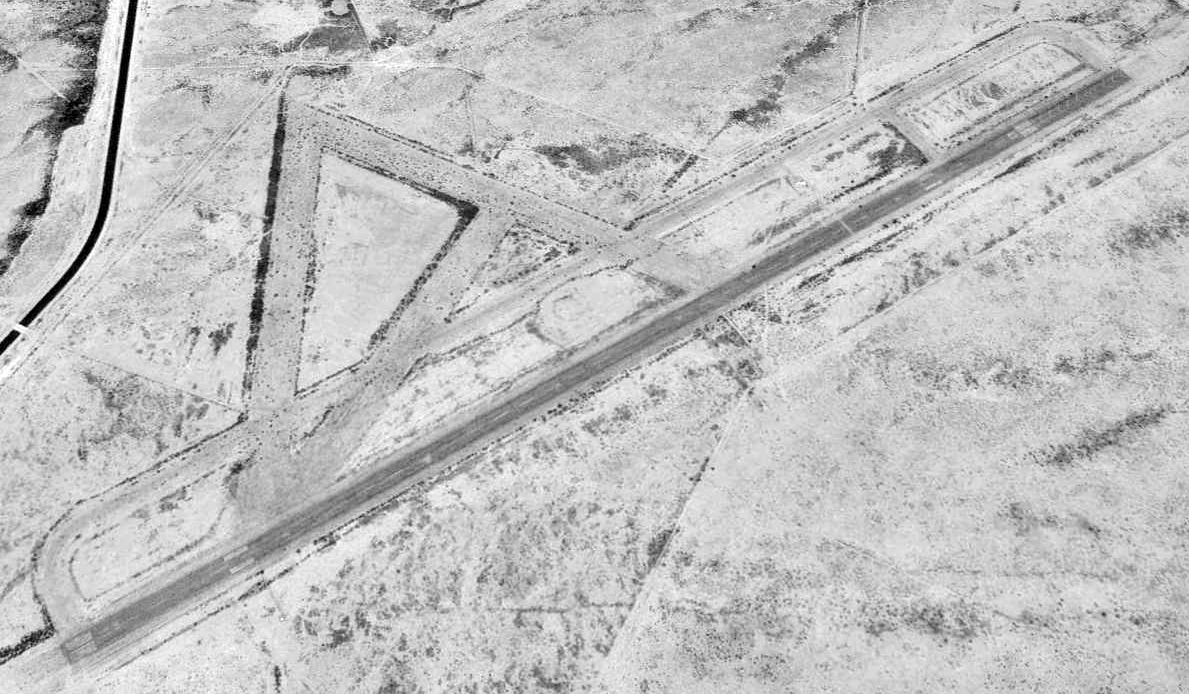
A 1997 USGS aerial view looking northeast at Luke Aux #1 showed the upper 3 runways were laid out in the triangular arrangement typical of a WW2 Army Airfield,
while the primary runway was eventually further lengthened to 10,000'.
Although officially not an active military airfield, new navigational radio & radar equipment has been installed by the USAF at the Wittman airfield in recent years.
This is a fairly unusual case of an abandoned airfield being reused for practice approaches
(which are not continued all the way toward a landing).
Ironically, there are plenty of active airfields which do not have any instrument approaches at all,
while this abandoned airfield has an elaborate set of ground-based instrument approach aids!
According to Lt. Col. Mark Scharf (F-16 ANG pilot, and former F-16 IP at Luke AFB),
"The students at Luke AFB, learning in the initial phases of F-16 training,
have to do a number of instrument approaches before their "qualification" checkride.
To relieve some congestion at Luke AFB proper,
Aux 1 was equipped with a Precision Approach Radar (PAR) and a localizer/ILS to the abandoned runway.
All approaches are to Runway 11 (from the Northwest).
I don't know when this was done, but it's been operating for quite a while.
F-16s departing the MOAs to the northwest of Luke can easily drop into Aux 1 for practice approaches,
then continue back to Luke, which is just over the White Tank Mountains.
The runway is not suitable for landing (big warning on the approach plates we use)
because of the breakdown & foliage growth."
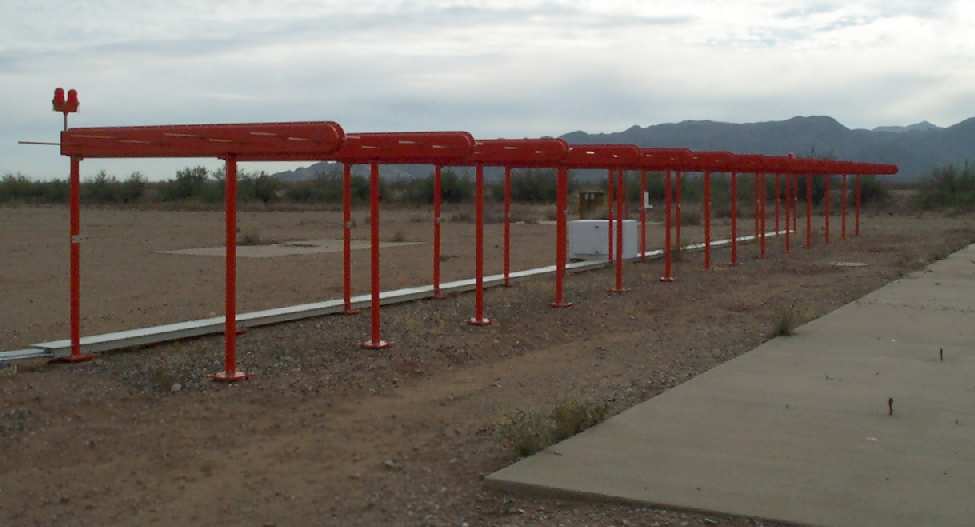
A 2002 photo by a local AZ pilot of the localizer antenna at Wittman Aux.
He observed, "There are fresh yellow 'X's on the runway,
and 2 white 'T's painted about where the runway thresholds should be."
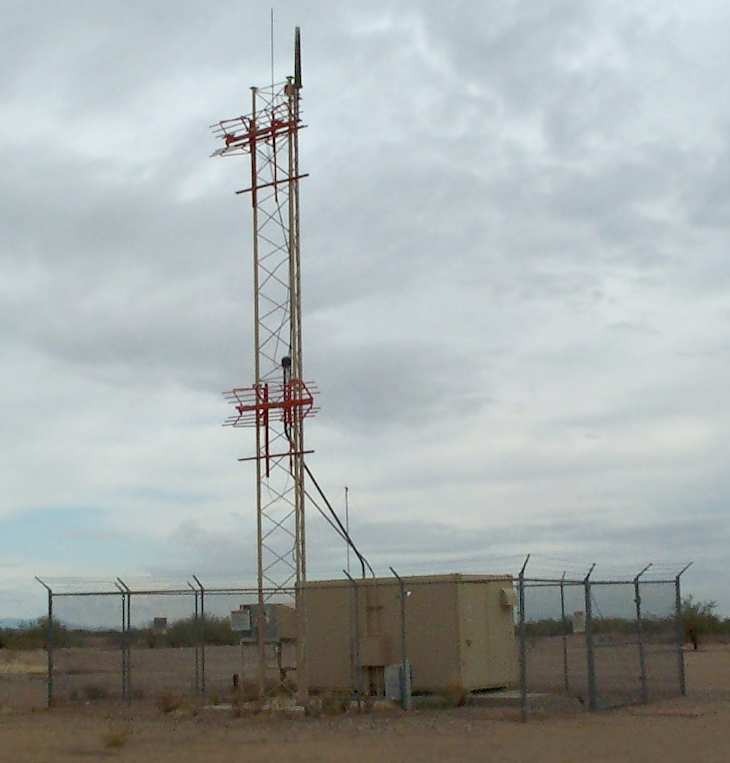
A 2002 photo by a local AZ pilot of a glideslope antenna at the end of Runway 29 at Wittman Aux.
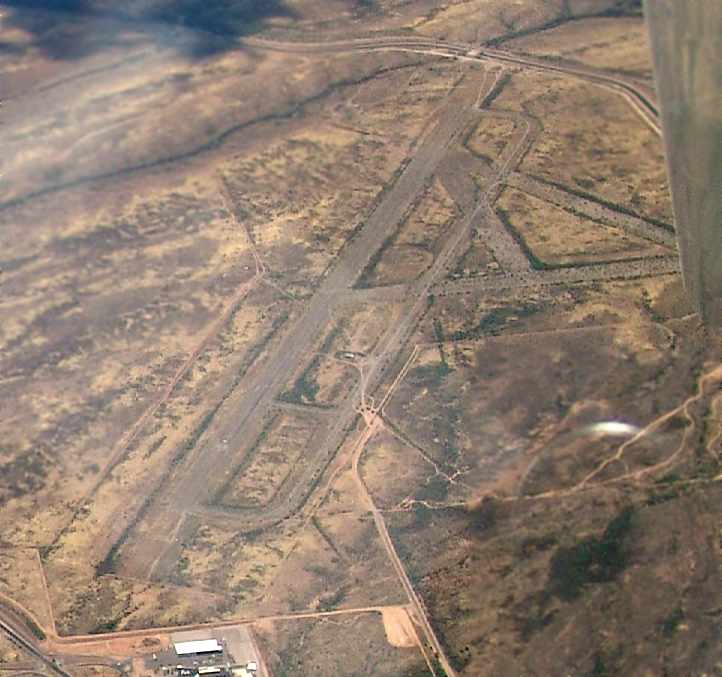
An August 2005 aerial view by Alejandro Diaz looking west at the Wittman airfield,
with the facilities of Ford's Volvo Arizona Proving Ground visible at the bottom-left.

A 3/10/19 aerial view by Tim Gagnon looking east at the remains of Luke Aux #1.

An 11/24/22 photo by Kurt Bob looking along the remains of the Luke Auxiliary #1 /Wittman Field main runway, “ery overgrown with small desert shrubs”, but with the runway numbers still visible.

An 11/24/22 photo by Kurt Bob at the site of Luke Auxiliary #1 /Wittman Field.
Kurt observed, “Added during the very end of the field's useful life, the electronics building & tower, 1 mile down Runway 11, is virtually the only structure left on the entire airfield.”
____________________________________________________
Luke Auxiliary Army Airfield #2 / Beardsley Field, Glendale, AZ
33.704, -112.42 (Northwest of Luke AFB, AZ)

An 8/29/42 USAAC aerial view of Beardsley Field (from the National Archives, courtesy of Brian Rehwinkel).
Beardsley Field was built during WW2 as one of a large number of satellite airfields for Luke AAF,
which was the largest single-engine advanced training base in the world during WW2.
According to the "History of Luke AFB" (obtained by David Brooks from the public affairs office at Luke AFB),
"The origination date of [Beardsley Field] is lost to history."
The site consisted of 580 acres that were leased by DoD, presumably at some point after Luke Air Force Auxiliary Field #1, which was acquired in 1942.
The configuration of Beardsley Field was described as "having 4 runways, three being 300' wide & 4,000' long & built in an equilateral triangle configuration,
with a 300' x 3,600' foot landing strip bisecting the center.
The 4-runway configuration… cost $300,000 to construct.
Beardsley Field facilities were limited to a control tower, crash truck shed & a generator shed."
Beardsley also had a 4,000 gallon water tank & a wind tetrahedron.
The earliest photo which has been located of Bearsley Field was an 8/29/42 USAAC aerial view (from the National Archives, courtesy of Brian Rehwinkel).
It depicted Beardsley as having 4 paved runways.

A 6/17/43 aerial view looking east from the 1945 AAF Airport Directory depicted Beardsley as having 4 paved runways.
Beardsley Field was not yet depicted on the March 1944 Phoenix Sectional Chart.
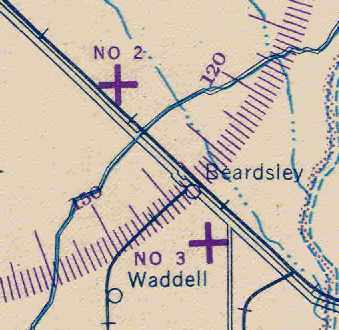
The earliest aeronautical chart depiction of the Beardsley airfield which has been located was on the March 1945 Phoenix Sectional Chart (courtesy of Chris Kennedy).
It depicted Beardsley "#2" as an auxiliary airfield.
The 1945 AAF Airfield Directory (courtesy of Scott Murdock) described Luke Field Auxiliary #2 (Beardsley Field)”
as a 587 acre square property within which were 4 bituminous runways,
with the longest being the 4,000' ENE/WSW, WNW/ESE, and NNW/SSE strips.
The field was described as not having any hangars, and to be operated by the Army Air Force.
According to the "History of Luke AFB" (obtained by David Brooks from the public affairs office at Luke AFB),
"It remained a Luke Field asset through the base’s inactivation in 1946."

The 1947 Gila River World Aeronautical Chart depicted Luke AF #2 as having a 3,900' paved runway.

A 2/14/49 aerial view (from the Maricopa County Flood Control District) depicted Beardsley as having 4 paved runways.
"Luke AF #2" was depicted as an active airfield on the 1956 Phoenix Sectional chart (courtesy of John Voss),
which described the longest runway as being a 3,800' hard-surfaced strip.
According to an Army Corps of Engineers report, after the Air Force completed use of the property, it was sold to a private owner.
The north/south runway was used for drag racing at some time in the past.
Owen Gibson reported “I have movie footage of a race at Beardsley...
the site was listed as 2.5M N/W of Beardsley on Hwy 60/70/89.
This was November 1958 & the track design was listed as 3,400' straights & has that classic triangle look.”
"Luke AF #2" was labeled "Closed" on the 1964 Phoenix Sectional Chart (according to Chris Kennedy).
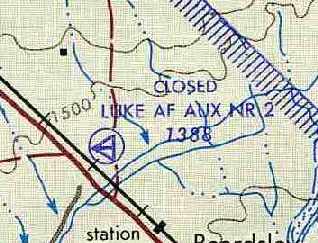
"Luke AF Aux #2" was depicted as a closed airfield on the August 1971 USAF Tactical Pilotage Chart (courtesy of Chris Kennedy).
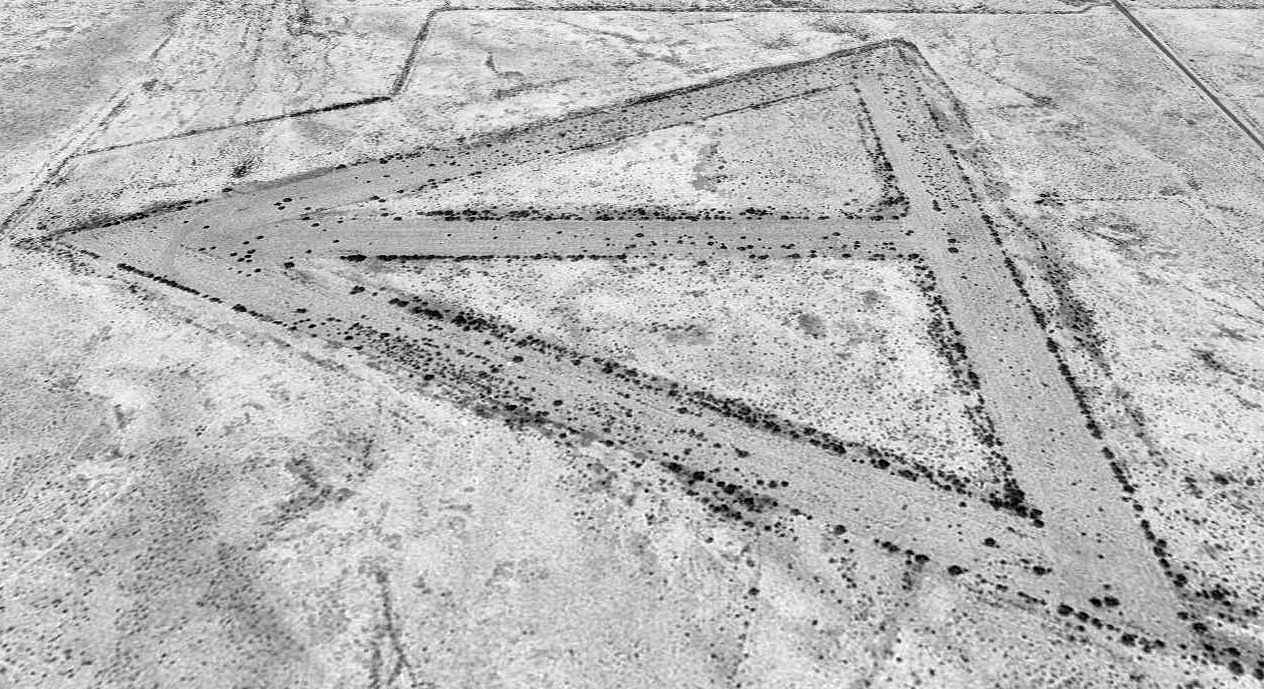
A 1997 USGS aerial view looking north showed all 4 Beardsley Field runways remained intact.
According to a 1998 Army Corps of Engineers report, all facilities (except for the runways) have been removed from the site.
The current owner leases the property to a rancher for cattle grazing.

As seen in a 2005 aerial photo looking northeast by Jim Baker of Hikari Photography,
the runways of Luke Aux #2 appear to remain in the same condition as depicted in 1997.

An April 2007 aerial view by John Galban looking southwest at the site of Beardsley Aux #2,
showing that over half of the airfield has been removed for new construction.
John reported, “I was taken by surprise when flying from Phoenix to Kingman last spring & noticed that this old landmark had almost disappeared.”

A November 2009 photo by Chris Kennedy looking north along part of the north/south runway of Luke Auxiliary #2.
Chris observed, “Access is less than ideal. Only a little less than half of this runway is left & this is taken looking north from the south end of the remaining portion.
It's not really recognizable as a runway from this angle, just an area where the bushes are a little smaller.
Ironically, the housing development that was the reason that most of the field was plowed up is mostly just empty streets, as are many of the other ones around here.”
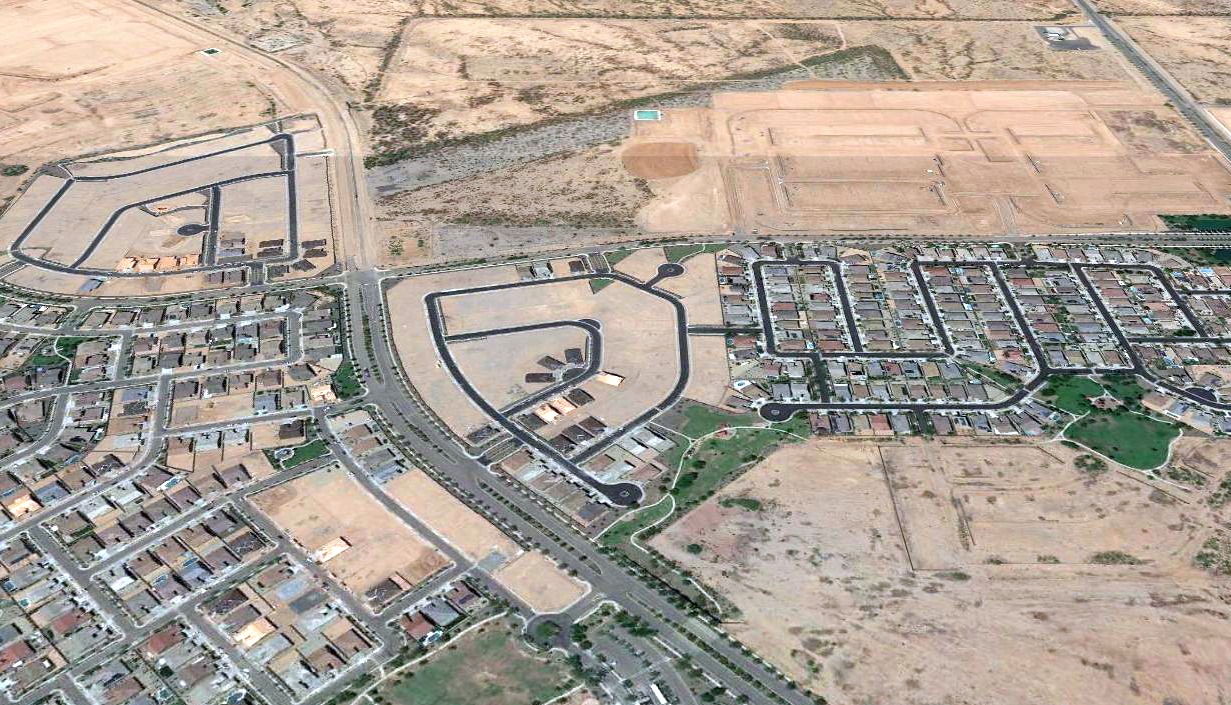
A 2019 aerial view looking north showed much of the site of 4 Beardsley Field had been redeveloped, with only portions of 2 runways remaining on the north side of the site.
____________________________________________________
Luke Satellite Field #1 / Luke Air Force Aux #3, Glendale, AZ
33.631, -112.365 (North of Luke AFB, AZ)
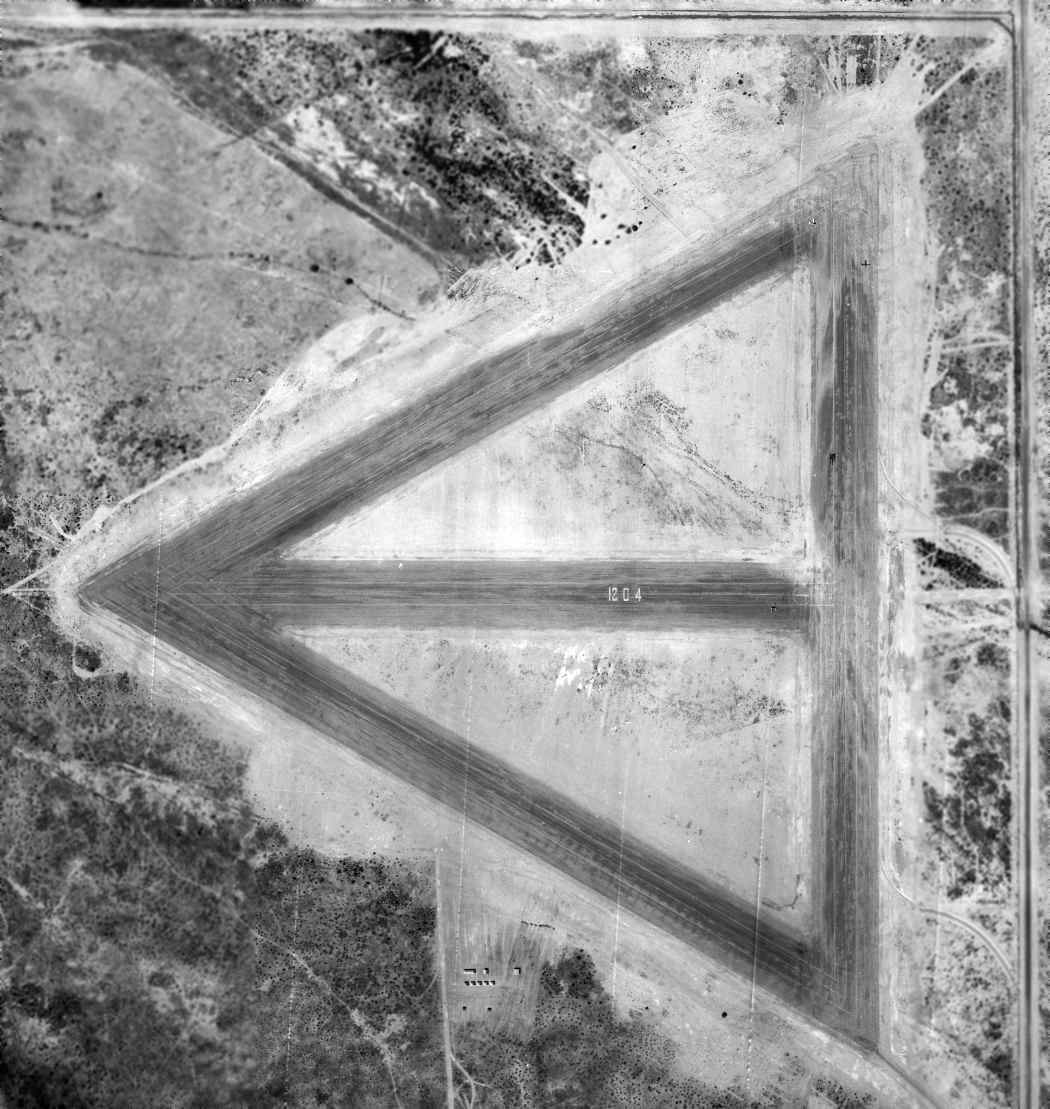
The earliest photo which has been located of Luke “Satellite Field #1” was an 8/29/42 USAAF aerial view (courtesy of Brian Rehwinkel).
This satellite airfield for Luke Army Airfield confusingly went through an early name resignation,
being first known as Luke Satellite Field #1, then as Luke Auxiliary Field #3.
Luke Satellite Field #1 was built during WW2 as one of a large number of satellite airfields for Luke AAF,
which was the largest single-engine advanced training base in the world during WW2.
Luke Satellite Field #1 was evidently built after 1941,
as it was not yet depicted on the September 1941 Phoenix Sectional Chart (courtesy of Chris Kennedy).
According to an Army Corps of Engineers Report, the 656 acre property for Luke Aux #3 was originally acquired in 1942.
According to the "History of Luke AFB" (obtained by David Brooks from the public affairs office at Luke AFB),
"Auxiliary Field Number 3 was simply referred to as Fighter Field.
It was located 12.5 miles west-northwest of Glendale & became a Luke Field asset on 12/1/42."
The airfield configuration of Field #3 was described as "having 4 runways,
three being 300' wide & 4,000' long & built in an equilateral triangle configuration, with a 300' x 3,600' landing strip bisecting the center.
The 4-runway configuration… cost $300,000 to construct.
[Among Luke's auxiliary airfields], Fighter & Goodyear Fields boasted the most facilities,
each having separate buildings for crew chiefs, operations, supply, barracks, pit latrine, crash truck shed, generator shed & a control tower.
Building construction cost totaled $24,500.
Adding the $11,400 cost for the land, Fighter Field at $335,900 was the most expensive purely auxiliary field owned by Luke during the era."
The earliest photo which has been located of Luke “Satellite Field #1” was an 8/29/42 USAAF aerial view (courtesy of Brian Rehwinkel).
It depicted the field as having 4 paved runways, with a cluster of small buildings or tents to the southwest.
The east/west runway had the field elevation of “1204” painted in the middle, and the airfield designation “1” inside a large circle on the eastern end.

A closeup from the 8/29/42 USAAF aerial view (courtesy of Brian Rehwinkel)
showing a single-engine plane on (or overflying) the east/west runway of Luke “Satellite Field #1”.
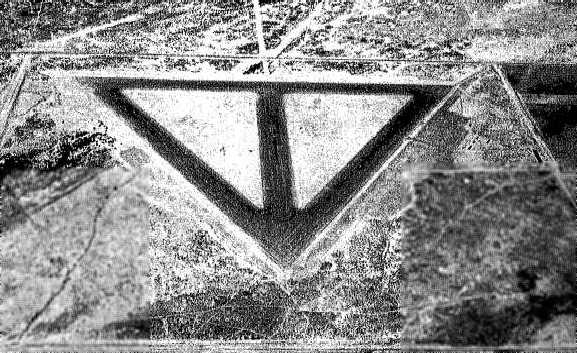
A 6/17/43 aerial view looking east from the 1945 AAF Airport Directory depicted Luke Aux #3 as having 4 paved runways.
Luke Aux #3 airfield was not yet depicted on the March 1944 Phoenix Sectional Chart.

The earliest aeronautical chart depiction of the Luke Aux #3 airfield which has been located
was on the March 1945 Phoenix Sectional Chart (courtesy of Chris Kennedy).
The 1945 AAF Airfield Directory (courtesy of Scott Murdock) described Luke Field Auxiliary #3 (Fighter Field)”
as a 653 acre square property within which were 4 bituminous runways,
with the longest being the 4,000' northeast/southwest, WNW/ESE, and NNW/SSE strips.
The field was described as not having any hangars, and to be operated by the Army Air Force.
According to the "History of Luke AFB" (obtained by David Brooks from the public affairs office at Luke AFB),
Auxiliary Field #3 remained a Luke Field asset "until surplused on 2/1/46."

The 1947 Gila River World Aeronautical Chart depicted Luke AF #3 as having a 3,900' paved runway.
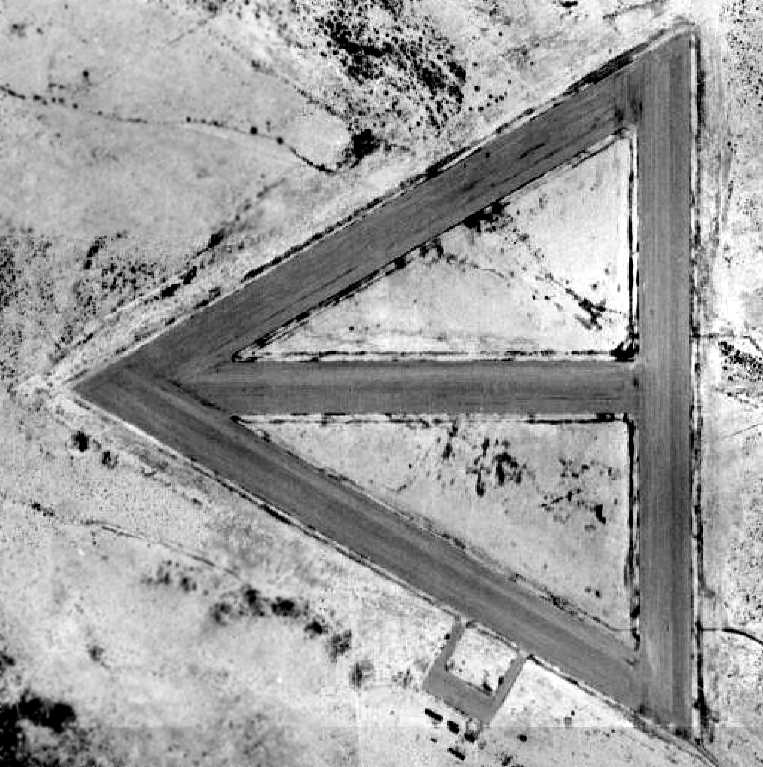
A 2/14/49 aerial view (from the Maricopa County Flood Control District)
depicted Luke Aux #3 as having 4 paved runways, with a small paved ramp on the southwest side.
The airfield property was conveyed to the City of Phoenix in 1949.
However, the entire property was leased again from the City of Phoenix in 1949
and the air field was reestablished for military use.
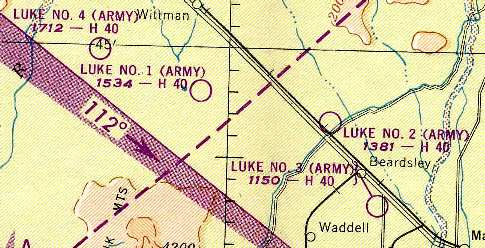
"Luke #3 (Army)" was depicted as an active airfield on the 1949 Phoenix Sectional Chart (courtesy of Chris Kennedy).
Top Speed Magazine, 1952, mentioned that the Kluster Busters car club held weekly drag races at Luke Field, Auxiliary #3.
"Luke AF #3" was depicted as an active airfield on the 1956 Phoenix Sectional chart (courtesy of John Voss),
which described the longest runway as being a 3,800' hard-surfaced strip.
The Luke AF #3 military lease was once again terminated in 1957.
The lease release documentation contained a clause prohibiting
use of the land as an airfield as long as Luke AFB is used as an air field.

The last aeronautical chart depiction which has been located showing Luke AF #3 as an active airfield was on the March 1960 Phoenix Sectional chart.
It depicted “Luke AF #3” as having 4 paved runways, with the longest being 3,800'.
"Luke AF #3" was depicted as a closed airfield on the September 1960 Phoenix Sectional Chart.

A 1997 USGS aerial view looking north showed the runways & ramp of Luke AF #3 remained intact though deteriorated.
Three of the runways have been overgrown by vegetation.
The 4th runway is surfaced with asphalt & is used by permitted radio controlled airplane operators.
The City of Phoenix has removed the operations buildings, and no evidence of remaining concrete pads has been found.
The large Sun City West community is adjacent to the airfield to the north.
Nearby resident Jim Kudlinski reported in 2002 that the City of Phoenix recently exchanged the Luke Aux #3 property for another parcel of nearby land.
The new owner intends to develop it into residential housing.
A 2002 aerial photo showed several roads had been built over the southwest portion of the Luke Aux #3 runways at some point between 1997-2002.
Chris Kennedy reported in 2003 that an article described that a baseball stadium & spring training complex had recently been built in Surprise, AZ,
'on a square-mile of desert where Luke Air Force Base's auxiliary field once stood.'
However, it turns out that the baseball complex has actually been built
adjacent to the west side of the Luke Aux #3 airfield, not over the airfield itself.

A 2004 photo by Bret Kepner, looking southwest along a former runway at Luke Aux #3.
The light towers of the baseball complex which has recently been built adjacent to the west side of the airfield are visible on the horizon.
Bret reported, "I parked in the new Kohl's Department Store lot to the north
and walked (freely, I might add) to the northern runway intersection."
Bret observed that the "new massive ballpark complex" had been built adjacent to the west side of the Luke Aux #3 property to the west.

A 2019 aerial view looking north showed that portions of all 4 Luke Aux #3 runways still remained intact,
although a recreational complex had covered much of the southwestern portion of the former airfield.
George Van de Langeryt reported in 2024, “We hold a memorial service at Luke Aux Field #3 yearly on the Saturday before Memorial Day to honor the pilots who never returned after training at Fighter Field.
I give a short history of the field.”
____________________________________________________
Luke Auxiliary Army Airfield #4 / Wickenburg Field, Wittmann, AZ
33.75, -112.63 (Northwest of Luke AFB, AZ)

A 6/17/43 aerial view looking north at “Luke Auxiliary Field #1 (Wickenburg Field)”
from the 1945 Army Air Forces Directory of Airfields (courtesy of Scott Murdock).
This field was built during WW2 as one of a large number of satellite airfields for Luke AAF,
which was the largest single-engine advanced training base in the world during WW2.
This field was also known as "Wickenburg Field" (which could lead to some confusion with Echeverria Field, which was actually located in Wickenburg).
According to the "History of Luke AFB" (obtained by David Brooks from the public affairs office at Luke AFB),
Wickenburg Field (#4) had three 4,000' x 300' runways, and was "built during the period July - August 1942."
However, Luke Aux #4 was not yet depicted on the March 1944 Phoenix Sectional Chart.
The earliest depiction of the Luke Aux #4 airfield which has been located
was a 6/17/43 aerial view looking north from the 1945 Army Air Forces Directory of Airfields (courtesy of Scott Murdock).
It depicted the field as having 3 asphalt runways.

The earliest aeronautical chart depiction of the Luke Aux #4 airfield which has been located
was on the March 1945 Phoenix Sectional Chart (courtesy of Chris Kennedy).
The 1945 AAF Airfield Directory (courtesy of Scott Murdock) described Luke Field Auxiliary #4 (Wickenburg Field)”
as a 640 acre square property within which were three 4,000' bituminous runways,
oriented NNE/SSW, ENE/WSW, and northwest/southeast.
The field was described as not having any hangars, and to be operated by the Army Air Force.

The 1947 Gila River World Aeronautical Chart depicted Luke AF #4 as having a 3,800' paved runway.
Luke Aux AAF #4 was listed in a directory of AZ Airports in the 5/47 issue of Arizona Highways (courtesy of George Miller),
which described the field as being unattended, and the longest runway as being 4,000'.
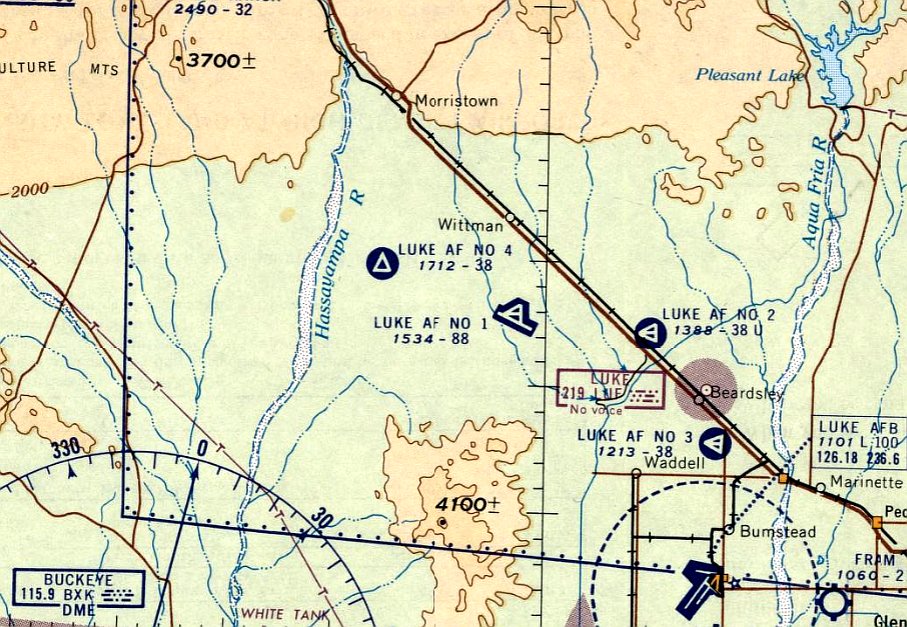
The last aeronautical chart depiction which has been located showing Luke AF #4 still open was on the March 1966 Phoenix Sectional Chart.
It depicted Luke AF #4 as having 3 paved runways, with the longest being 3,800'.
The Luke Aux #4 airfield was apparently closed at some point in 1960,
as it was labeled "closed" on the September 1960 Phoenix Sectional Chart.

"Luke AF Aux #4" was depicted as a closed airfield
on the August 1971 USAF Tactical Pilotage Chart (courtesy of Chris Kennedy).
Like Luke Aux #3, the property of this field was apparently transferred to the City of Phoenix,
as it was depicted as "Luke Auxiliary Field #4 (City of Phoenix)" on the 1988 USGS topo map.
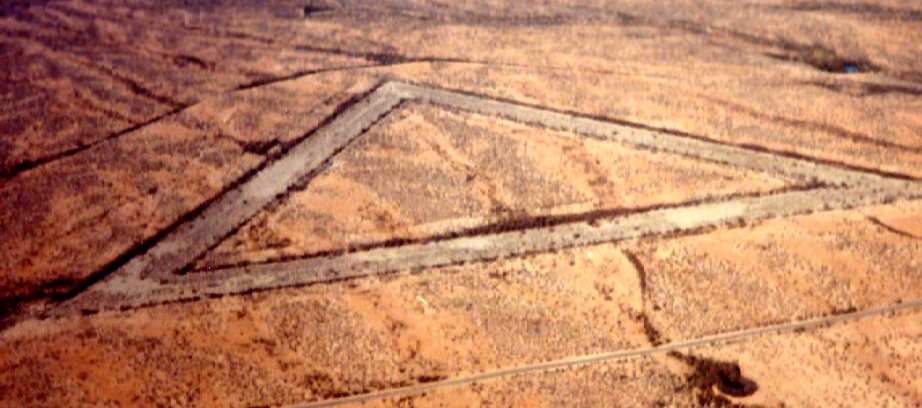
A 1997 aerial photo of Luke Aux #4 by Steve Hoza, author of the book "Best Place in the Country".

A circa 2001 aerial view showed that Luke Aux #4 consisted of three 4,000' paved runways arranged in an equilateral triangle,
like the large number of other Luke satellite fields.
The runways remained in fairly decent condition, with no sign of any buildings at the site.
Luke Aux #4 was still depicted as an abandoned airfield on 2002 aeronautical charts.
Steve Hoza reported in 2003 of Luke Aux #4, "This has changed little since I [he took the 1997 aerial photo].
Mike & I have visited this on the ground & the pavement is still in relatively good shape."
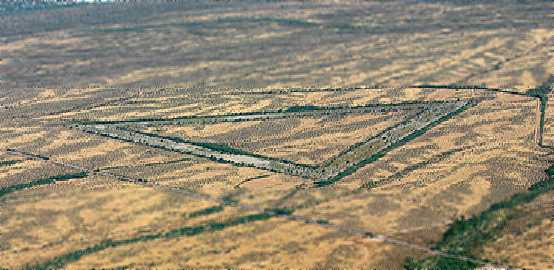
As seen in a 2005 aerial photo looking northwest by Jim Baker of Hikari Photography,
the runways of Luke Aux #4 appear to remain in the same condition.
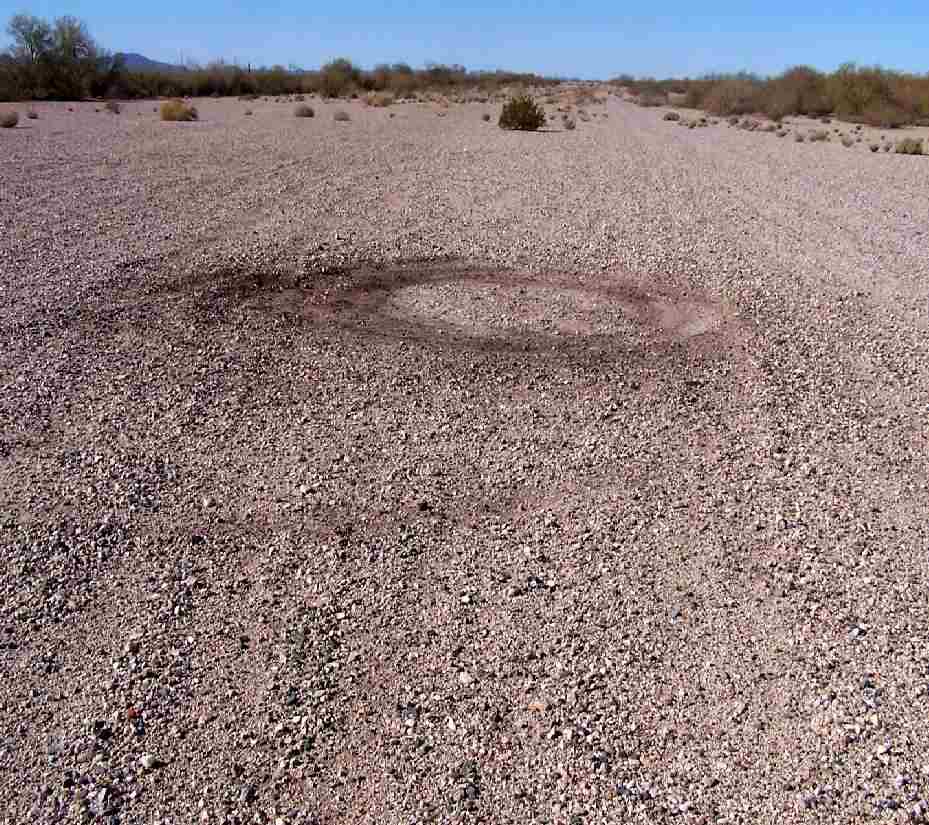
A 2008 photo by Richard Winkler of the remains of a Luke Aux #4 runway.
Richard observed, “The condition of the old airfield is poor.
The runways have been reduced to gravel with the east side runway being almost completely overgrown by brush, which might indicate it was used the least.
The south & west runways are in similar condition, some brush, some garbage discarded by uncaring individuals
but for the most part a darn good option in the event of an emergency landing.
Interestingly, I have spent enough time around WWII aircraft to know the smell of radial engine oil & asphalt
and on the southern most runway, there is still a large saturated area of oil in the gravel/asphalt as if something had sat there for a long period of time.
Maybe my imagination is running wild, but it's neat to think about.”
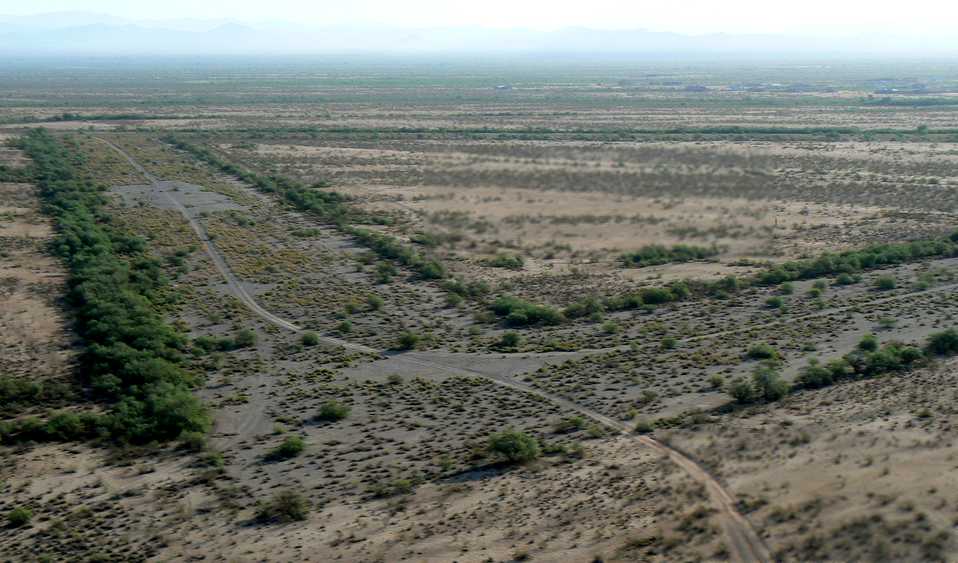
A 8/10/08 aerial view of the remains of the Luke Aux #4 runways.
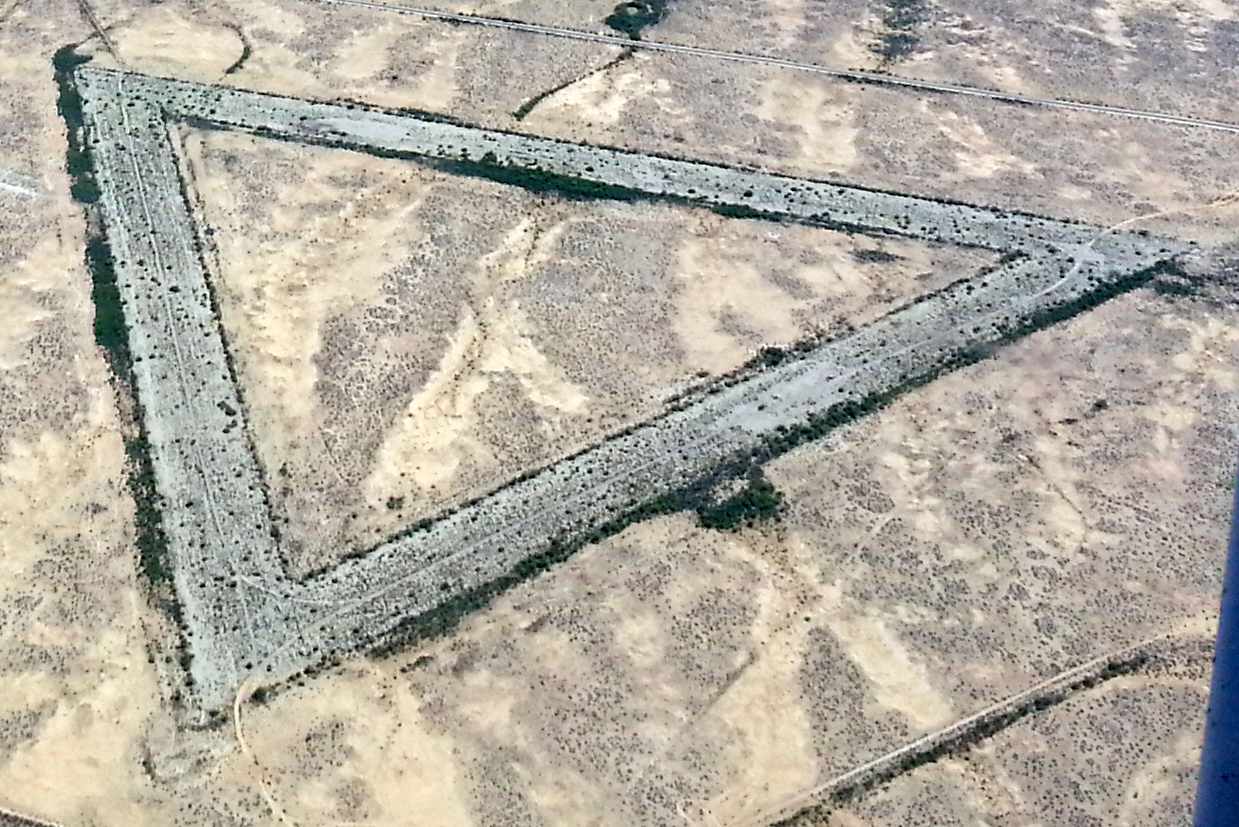
A 4/13/15 aerial view by Doug Landers looking southeast at the site of Luke Aux #4.
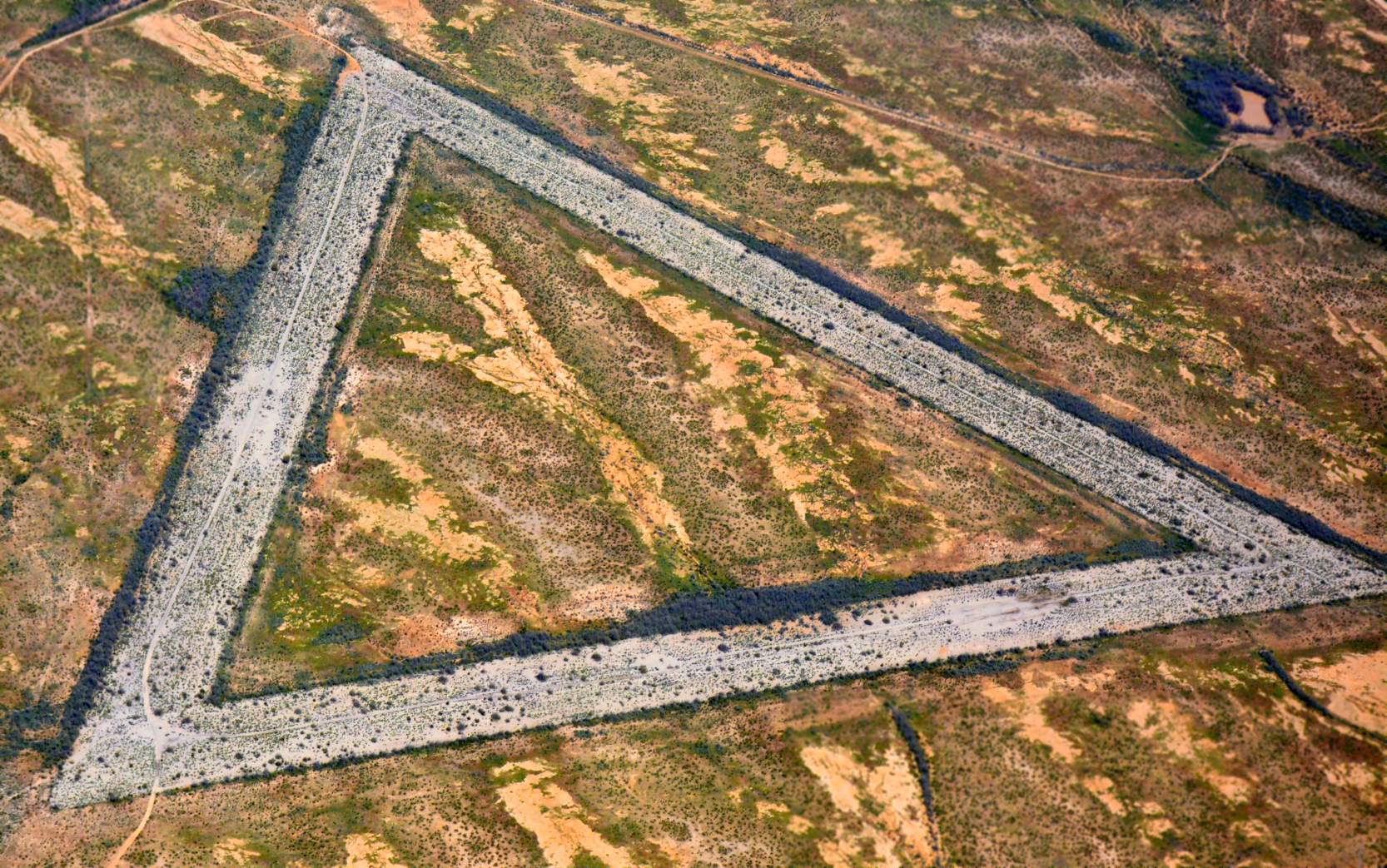
A 3/10/19 aerial view by Tim Gagnon looking northeast at the remains of Luke Aux #4.
Luke Aux #4 is located northeast of the intersection of West Patton Road & Ogden Road, 6 miles southwest of Wittmann.
____________________________________________________
Since this site was first put on the web in 1999, its popularity has grown tremendously.
If the total quantity of material on this site is to continue to grow,
it will require ever-increasing funding to pay its expenses.
Therefore, I request financial contributions from site visitors,
to help defray the increasing costs of the site
and ensure that it continues to be available & to grow.
What would you pay for a good aviation magazine, or a good aviation book?
Please consider a donation of an equivalent amount, at the least.
This site is not supported by commercial advertising –
it is purely supported by donations.
If you enjoy the site, and would like to make a financial contribution,
you
may use a credit card via
![]() :
:
Please consider checking the box to make a monthly donatation.
For a mailing address to send a check, please contact me at: paulandterryfreeman@gmail.com
If you enjoy this web site, please support it with a financial contribution.
This site covers airfields in all 50 states.